

17 Best Catamarans for Sailing Around the World
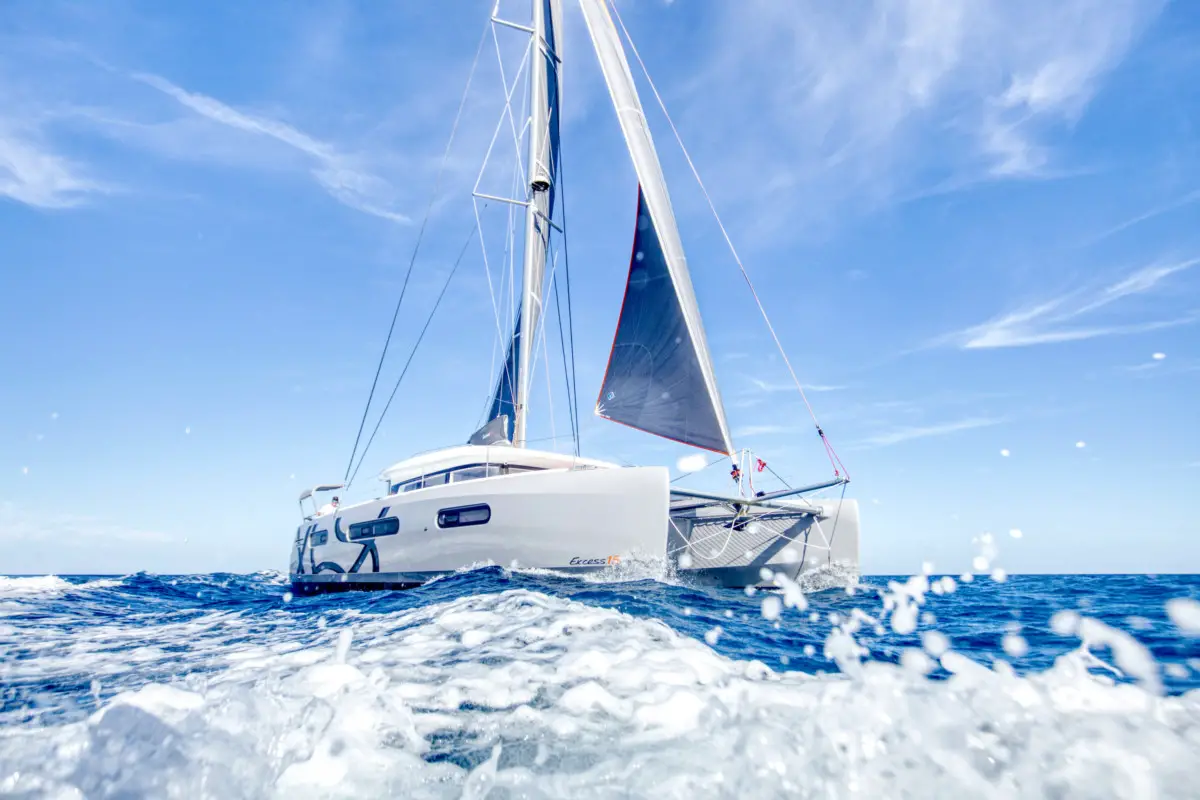
As an Amazon Associate, we earn from qualifying purchases. We may also earn commissions if you purchase products from other retailers after clicking on a link from our site.
Catamarans are quickly outstripping single-hull boats for long-distance journeys. They are more stable and comfortable , and some can travel more than 200 miles in a day. In today’s article, I have put together a complete (well almost) list of some of the best catamarans for circumnavigating the planet; the question is, which one is best for you?
The best catamarans for sailing around the world include:
- The Fountaine Pajot Ipanema 58
These cats focus on speed, safety, and comfort for longer journeys.
This article will show you the seventeen best catamarans for long journeys, and why they’re the best. You’ll also learn some great tips on what to look for in a Catamaran and how to save money by buying a used catamaran. Let this list be a jumping-off point for your future research!
Pro-tip; here are the actual costs of maintaining a cat and here are considerations on how to circumnavigate .
Table of Contents
The Best Catamarans for Sailing Around the World
A catamaran is a double-hulled boat with a deck or cabin area in between (bluewater cat definition in this article ). The double hull design means that the boat rocks less, sits higher on the water, uses less fuel to sail, and can be sailed in shallower waters than a single-hulled boat without worrying about grounding.
Catamarans come in a variety of sizes and can be sail-powered or motor-powered and range from single-person sailing boats to family-sized yachts. Every catamaran design is different, and the twin-hull shape offers many ways to customize the layout of a ship.
Each boat on this list is a larger catamaran (+40ft, more on size here ), so if you’re going to sail around the world, you want lots of space for provisions and rest.
Of course, there are tons of technical specs for each of these boats, but I’m going to focus on the overall features of each of these catamarans, what makes them stand out, and why they would each be an excellent choice for a transatlantic journey.
Antares 44i
The Antares 44i is an excellent option for sailing around the world and was explicitly designed for long-distance cruising. It performs well in any weather conditions, can be sailed easily by two people, and you’ll be able to sail long distances and live in comfort.
Although it can be easily sailed by a crew of two I believe that a true bluewater cat should be set up for single-handed sailing, more on that in another article .
This catamaran features a stateroom on each hull and a forward cabin with plenty of storage space. The living and entertainment features include a flatscreen tv and a high-end deck speaker system.
With this model, Antares dedicates itself to high-quality boats with optimal rigging and engine configurations.
Atlantic 42
Atlantic is no longer building this catamaran, but there are usually a few pre-owned boats on the market. You can also get it made custom if you love the design, but be prepared to spend more money on a custom boat (custom boat also gets custom problems ;)).
The Atlantic 42 is slightly smaller than some of the other catamarans on this list but is a seaworthy vessel. 42 ft is what most sailors I interview ( in this article ) said was the smallest cat to safely cross big oceans. It is also a decent size to counter the risk of capsizing (more on that here ).
It has a forward cockpit and pilothouse, which gives the owner a better use of space and makes the boat easier to navigate. With single-handed capability, one person can sail it easily and let the rest of the crew relax.
One of the best-praised aspects of the Atlantic 42 is its galley, more extensive than most 42-footers (12.8-meter) can offer.
One of the few 50 footers (15.24 meters) that can be sailed by just one person (many would of course disagree on this).
The Catana 50 is a catamaran worthy of an overseas journey. Its size adds to its stability on the open waters and its ability to sail straight through the choppy ocean and windy conditions.
The Catana is also incredibly spacious on the inside, with substantial cabins and showers. The biggest downside to the Catana 50 is its price, as it’s much more expensive than most of its competitors.
Catana also holds up well against some of the fastest cruising cats out there, here’s a list of the fastest cruisers if you are interested in that.
However, if you can find a gently-used Catana 50, you can rest assured that this boat will last!
The Dolphin 42 is unique because of the use of daggerboards instead of fixed keels. This upgrade means that the boat has some pretty decent upwind performance while at the same time being faster downwind.
Centerboards and daggerboards offer some interesting downsides compared to mini keels. This is an interesting discussion and I suggest you read another one of my articles if you want to deepen your knowledge a little.
These catamarans are some of the lightest on the market. Not many Dolphins were made, so they are relatively hard to find. However, if you want a small, lightweight boat capable of going great distances, the Dolphin 42 is an excellent choice.
Fountaine Pajot Belize 43
The Fountaine Pajot Belize is another well-built cruising yacht. Its core is made of foam instead of balsa, which reduces the risk of structural damage due to a rotten core in case of water intrusion.
The design of Belize offers many options for customizability, with large open spaces and a combined saloon, navigation, and dinette area.
There are two styles of Belize catamarans for sleeping quarters. You can either purchase a boat with an entire primary suite on one hull or one with two cabins in each hull. The first option is great if you are sailing the world alone and not expecting many guests, as it increases the storage capacity.
Understanding what factors to consider when getting a cat can be hard, there are just so many of them (such as the daggerboard discussion above), I have tried to compile some of the most important in this article .
The boat also has wraparound windows to increase the sense of space in the galley.
Fountaine Pajot Lucia 40
Fountaine Pajot is one of the best sailboat manufacturers existing today, as their boats are well made and highly versatile. The Lucia 40 is no exception – it’s a smaller boat but has a lot of room for moving around and on-board living.
The living area is remarkably spacious on this catamaran for its size.
The galley and lounge easily accommodate 6+people. The Lucia 40 doesn’t disappoint when it comes to sailing either, as the narrow hulls slice through choppy waters with ease.
Most catamarans today are built to withstand rough weather but that doesn’t matter as much if the crew isn’t up for the task, I firmly believe that the most important thing a boat should consist of, is knowledge. Therefore taking online courses ( two free here ) or reading books ( my favorites here ) is imperative.
Gemini 105M
Gemini’s boats have been on the market for years and are solidly built for cruising. This boat is one of the most popular ever made, I personally would consider something different for offshore cruising, but since it has such a good reputation, I felt I had to add it to the list.
If you want to understand why I am hesitant to take this boat around the world, I recommend you read my article: What are trampolines on a catamaran?
The Gunboat 62 is a great catamaran and set the standards for the rest of the impressive Gunboat lineup. It’s sleek and spacious while being robust and capable of transatlantic journeys. You can easily travel the world in a Gunboat 62 with several people and not feel cramped.
The yacht was made for speed and power and remains one of the fastest catamarans on the market, even rivaling the newer Gunboat models. GABO
Although the earlier models of the Gunboat 62 weren’t designed for a lot of cargo, you can still find space for everything you need without compromise.
Lagoon catamarans are known for their reliability and ease of use. If you are considering a catamaran for the first time and are unsure about the technicalities of sailing, a Lagoon boat is a great option.
The Lagoon 380 is probably the smallest cruiser on this list, which makes it better suited for solo or couple sailing.
When I go looking to buy something, whether it be a boat, campervan, or whatever, I create a checklist and classify all the things I want either by NEED or NICE to have.
I believe the Lagoon 380 to be sub-optimal for my NEEDS, even though it does check a lot of NICE boxes, there’s a step-by-step article on the NEED and NICE method here .
There are several cabin options available on the Lagoon 380, but if you’re sailing by yourself, you can settle for three cabins and a larger galley and living space. With a smaller cockpit and broader side decks, the Lagoon 380 packs a lot of practicality and ease of sailing into a more compact catamaran.
If you like the idea of a Lagoon boat but want a little more space, the Lagoon 42 is the upgraded version of the Lagoon 380. With all of the same benefits, it comes with more space for cabins or storage, making it one of the best-selling Lagoons of all time.
The Lagoon 42 is also a faster cruiser built for strength. While it’s not the fastest on the market, it works well in choppy waters and windy conditions, making it great for the beginning sailor to go on a more extended trip.
Many people have completed an around-the-world sail with this ship.
Although there is a flybridge version, I would recommend the “open” version due to several factors, some including increased windage and a higher boom. More on flybridges pros and cons here .
For stability, safety, and durability, you can’t beat the Lagoon 42.
The Leopard 45 performs better with less storage weight because of the relatively low bridge deck clearance. If the boat is fully loaded, you could experience some wave pounding. However, the cockpit is open and airy, with devices that block the sun and provide maximum comfort while sailing.
The Leopard 45 is an incredibly beautiful boat, and has a strong reputation for excellent build quality!
Leopard catamarans are one of my personal favorites, as such I have written an entire article about the brand, so if you want to understand its pros and cons then here is the link . Gabo
Designed in South Africa, it features a high rear arch for extra support and very smoothly connected decks. The galley is large and open, and most Leopards offer a four-cabin plan. If you are traveling with another person, this boat is an excellent option for you!
The Manta 42 is another classic catamaran that you can buy used (at a decent price), as it is an incredibly seaworthy vessel. While still in production, the Manta was one of the most popular catamarans on the market.
It is still in high demand amongst circumnavigators. Buying a used Manta 42 usually means that you inherit some of the previous owner’s boat upgrades!
The Manta 42 also made it to my list of the 9 safest catamarans on the market ( link ).
This blue water cat can be sailed by one or two people, making it ideal for liveaboard couples or long-distance shorthanded sailing. The galley is in the saloon ( instead of in one of the hulls ), making the cabins below more spacious and better equipped.
Overall, the Manta is well equipped for sailing around the world.
Nautitech 44
Nautitech is an excellent brand of the catamaran, with several different designs per boat. The Nautitech 44 has a unique feature, you can have it with two options for steering: twin wheels or a single wheel.
The Nautitech 44 also features a cockpit on the same level as the saloon. The door between the two is more convenient than a hatch and dramatically reduces the risk of water damage during rain pour.
This is also the same boat that aeroyacht president Gregor owns, he has offered some great insights into Nautitech in the book Catamarans (amazon link )
Outremer 45
Outremer is famous for being one of the fastest brands of catamarans on the market. If you need speed, the Outremer 45 might be the perfect choice for you. It has a top speed of 16 knots, which is higher than almost every other catamaran of its class.
While the Outremer 45 is known for speed, it doesn’t compromise on the quality of living.
You can settle into life on this boat with complete peace of mind. Even as a beginning sailor, the steering is simple and easy to use, and the autopilot is top of the line, so you’ll be able to sail across the ocean in an Outremer without issue.
Privilege Serie 5
A French-designed catamaran, the Privilege Serie 5 is one of the most comfortable 50-foot (15 m) yachts available. The unique cabin layout includes the master cabin in the boat’s center instead of in one of the hulls.
The Privilege Serie 5 is also incredibly easy to sail, despite its larger size.
The sails and controls lead to the helm, where the raised deck makes it easy to see all around the deck. If you want to cross the ocean with a full crew then the Privilege Serie 5 might be perfect for you!
Seawind 1000
The Seawind 1000 is the smallest boat on this list, measuring 33 feet (10 meters) long altogether. However, this doesn’t mean that it’s not livable. If you are sailing on your own or with a partner, there is more than enough space to live in the Seawind 1000, which includes the option of a centered cabin or two hull cabins.
Because it’s small, the Seawind 1000 is easy to handle. The mast and sails are all manufactured for extra stability and ease of use.
Overall, the Seawind 1000 is an excellent example of a simple, safe, and seaworthy catamaran.
Note: since this is a small catamaran it will also be more sensitive to heavy weather so trip-planning becomes even more important.
The Voyage 44 is one of the oldest cats on this list, having had its hay-day in the mid-1990s. However, this also means that a used Voyage 44 will be cheaper than a newer boat. If you can find a Voyage with previous responsible owners, you will inherit any upgrades and fixes that they’ve made on top of a very seaworthy boat.
The Voyage 44 has more storage and space than most cruisers of its size and is known for behaving very well in choppy waters.
This catamaran does its job well while providing adequate space for cooking, sleeping, and living aboard.
What To Look For in a Long-Distance Cruising Catamaran
If you are planning to sail around the world, you need to be very careful about which kind of catamaran you decide to use. Many of the things you want in a boat really comes down to personal preference, so be sure you know what design preferences you want before you start shopping!
Size and Payload
The most important thing to consider when buying a catamaran is how much space and cargo you need because the larger the boats are, the bigger the payload it can handle. Decide how long you want the ship to be and how much you’re taking with you.
It’s vital not to overload a catamaran, this will reduce performance and increase risk of unwanted behavior in heavy seas.
Cabin Placement
Most catamarans have options for a “Maestro” cabin placement, where one entire hull is the master suite, and the other cabins are located on the opposite hull.
Cockpit and Protection From The Weather
Is the cockpit on the boat you’re looking at covered or open? This can make a difference on the high seas, especially during rainy weather.
The size of the ship also can affect how many people you need as a crew. If you’re traveling by yourself or with one other person, you don’t want to buy a boat that needs a larger crew.
Buying Used?
If you don’t want to spend the money on a brand new catamaran, I don’t blame you. Several of the ships on this list are out of production and can only be found used. However, for circumnavigation, you do want a boat of high quality to keep you safe and dry until you make it to your destination.
When buying a suitably used catamaran, it’s essential to look at the refit history of the boat more than the year it was made. Catamarans are sturdy, and the general design has been the same for at least the past decade.
If you find a newer, larger, cheaper boat, you should look into its history.
Your best bet to save money while buying a catamaran will be to buy an older, probably smaller boat with an excellent refit history and no serious issues. It will still be an investment, and a sturdy used catamaran will serve you well.
Final Thoughts
No matter which catamaran you decide to buy for your journey, you’ll be able to sail safely and comfortably. Catamarans are great yachts for long-distance sailing, and the ships on this list are the best of the best. These brands are time-tested and ready to accompany you on an adventure around the world!
Here are Some of My Favorite Catamaran Cruising Resources
Thank you for reading this article. I hope you found it helpful as you hopefully start your sailing adventures. Here are some resources that I use as a sailor that I hope you’ll also find helpful. These are affiliate links, so if you do decide to use any of them, I’ll earn a commission. But in all honesty, these are the exact things that I use and recommend to everyone, even my own family. Sailboats: If you’re looking for the best boat to suit your needs, I would recommend a catamaran. If you’re interested, I can show you the differences between catamarans and other types of sailboats .
Books: For getting started, I really like Cruising catamarans made easy . It is actually a textbook from the American sailing association; it is used to get a cruising catamaran certification. There are some other great books, and I have compiled a list of books about cruising catamarans that you will find useful.
Communication: Being out on adventures, whether it be sailing or climbing mountains, good communications are essential to being safe. I recommend two things Google fi (incredibly simple cellular data all over the world) and Garmin inreach mini (for text and voice in remote areas without cell coverage)
Sailing courses: Online sailing courses are great for beginners starting out their sailing career; it’s an efficient way of learning the basics of navigation, throttle controls, and maritime safety. I suggest starting with two free courses from NauticEd .
To see all my most up-to-date recommendations, check out this resource that I made for you!
- Wikipedia: Catamaran
- Cruising World: A-Z Best Cruising Catamarans
- Dreamy Yacht Sales: Four Best Catamarans for New Buyers
- Atlantic Cruising: Good Cat/Bad Cat
- Yachting World: Catamaran Sailing Across the Atlantic
- Boat Affair: What is a Catamaran?
- Nautilus Sailing: Catamaran Sailing
Owner of CatamaranFreedom.com. A minimalist that has lived in a caravan in Sweden, 35ft Monohull in the Bahamas, and right now in his self-built Van. He just started the next adventure, to circumnavigate the world on a Catamaran!
3 thoughts on “ 17 Best Catamarans for Sailing Around the World ”
I like the efforts you have put in this, regards for all the great content.
Thanks Elisabeth I really appreciate the kind words 🙂
I appreciate you sharing this blog post. Thanks Again. Cool.
Leave a Reply Cancel reply
Your email address will not be published. Required fields are marked *
Save my name and email in this browser for the next time I comment.
Recent Posts
Must-Have Boat Gear for Catamaran Sailors!
Sailing is probably the most gear-intensive activity I've ever done; there are so many decisions to be made about what gear to buy now, for tomorrow, and what to definitely never buy. The gear on...
6 Best Trailerable Trimarans For Bluewater and Coastal Sailing
Having a boat costs a lot of money, even when you are not using it, marina fees, etc. And once it is in the water most sailors never go very far from their "home marina" and sailing will be somewhat...


My Cruiser Life Magazine
Best Catamaran for Sailing Around the World — Best Cruising Catamarans
Sailing around the world is a dream of many. It’s the grandest adventure you can have in a sailing vessel—or at least one of the top five. But what kind of boat do you choose?
For many, the go-to answer has become a bluewater catamaran. These boats offer outstanding comfort and living space. They outperform most monohull sailboats of their size, and their bright and airy salons and cockpits will convert non-sailors to the ideas of what is possible with such a boat.
Here’s a look at some of the best long distance cruising catamarans and why these boats are great choices for many crews.
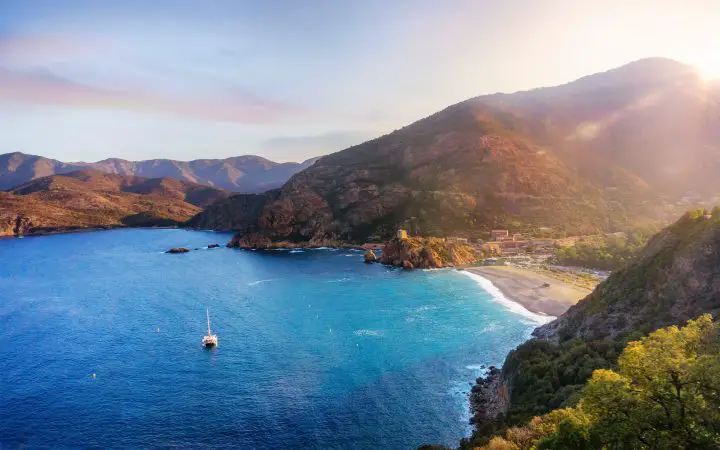
Table of Contents
Lagoon 440/450/46, leopard catamarans 42/43 (circa 2000-2007), pdq antares 44/44i, catana 471/47, fountaine pajot orana / helia 44, balance 482, what is a cruising catamaran, cruising catamaran pros, cons of catamaran offshore cruising, what to look for — best catamaran for sailing around the world, best cruising catamarans faqs, 8 popular choices for best cruising catamarans.
Every boat has strengths and weaknesses, and every list is biased. There are tons of boats out there, and it’s impossible to be familiar with every single one. Furthermore, as time passes and our needs change, the types of boats that catch our attention change.
Sailing long distances, like around the world, is a very specific mission. It’s not something you wake up one morning and say, “Today, I’m setting off around the world!”
No, a circumnavigation is the culmination of years of preparation and research. Just finding the right boat is a big part of that. Some experienced cruisers make their business helping people find the right boat to suit their needs. If you’re completely lost in the boat-buying process, reaching out to an experienced expert (not just a yacht broker!) is an important step.
One such person is John Neal. Neal runs Mahina Offshore Services and is a consultant for folks wanting to cast off the lines. He’s written extensively about what makes a good bluewater cruiser and specializes in boat consultations. Be sure to visit his website and download his free ebook, Selecting and Purchasing an Ocean Cruising Sailboat.
Another great resource, especially if you’re considering voyaging with your kids, are Jamie and Behan Gifford of Sailing Totem . They work as consultants helping couples and families find their path to a successful circumnavigation—what they call “from dream worthy to seaworthy.” Totem and crew crossed their wake a few years back, and they write for Cruising World and often speak at events like Cruiser University at the Annapolis Sailboat Show in the fall.
Here’s a look at some of the most popular long-distance cruising catamarans. This isn’t an all-inclusive list, nor are these really recommendations. Rather, they’re a look at some boats, both good and bad, to consider for the ultimate sailing adventure.
View this post on Instagram A post shared by Katamarans (@katamarans)
Lagoons are the ubiquitous production boat of the catamaran world. Next to Leopard, they dominate nearly every list of catamarans since the company makes so many of them. They’ve been cranking these boats out for over 20 years, longer than many other manufacturers. When you do the math, there’re more examples of individual Lagoon models out there than hulls made by many other manufacturers combined.
What does all that mean for the buyer? For one thing, it means it’s not hard to find a Lagoon for sale. If you pick your model, you’ll probably find a few dozen for sale worldwide at any given time. A cursory look at Yacht World shows 23 listings for the 440 and another 77 for the 450 (not including those listed separately as 450F and 450S!).
The 440 was the first of Lagoon’s popular flybridge models. This offers an upper level so that the helmsperson can see all points of the boat and is separate from the salon and cockpit area. Many liveaboard 440 owners have converted the upper flybridge with an enclosure to make it an all-weather helm.
The 450 took the 440’s success and improved all the details. The updated design was one of the most popular boats Lagoon ever made. They eventually divided the lineup it the 450F, with the standard flybridge, and the 450S, with a “sporty” helm on the aft coachroof.
Both are very popular boats and are sized right for world voyaging. They aren’t without problems, however. Around 2020, many owners began discovering serious problems with bulkheads delaminating from the hulls. However, Lagoon has an official fix, and many boats have been successfully repaired. As always, get a good survey, research, and ask the right questions!
Lagoon 450s are currently listed for anywhere between $400,000 and $800,000. 440s are older and can be found between $275,000 and $450,000. As always, keep your eyes peeled for the less common and much more comfortable owners’ version layouts with one huge master cabin.
View this post on Instagram A post shared by Solo Deniz (@solo_deniz)
Leopard is another ubiquitous brand in the catamaran world. The company’s newer models, like the current (2023) Leopard 45, have a forward seating area and a large opening door on the front of the salon. In short, they’re perfect charter boats. Leopard habitually reuses their model numbers repeatedly, making getting the right model confusing. The newest Leopard 42 started production in 2020 and features the forward patio lounge.
The Leopards included on this list are much older and lack this forward patio design. Instead, these original Leopards have a low-profile aesthetic perfect for ocean sailing. They’re comfortable and functional. They’re a little on the small size for world cruising but would be perfectly suited for a couple that wants the smallest boat they can get.
The difference between the two models was only one thing—the 42 included a soft-top bimini, while the 43 had a hard top. Most owners have now converted their 42’s soft top to a hard one.
Leopard 42s and 43s from 2000 to 2007 are currently listed between $250,000 and $350,000. The 43s, which are a bit newer, go for just a little more. Since so many saw charter use, finding good examples with owner’s layouts is hard. When you do, they’re worth the trouble to bring home.
If you’re looking for a bargain, the older Leopard 45 and 47 were remarkably similar in design. They are less common on the used market today, but if you find one in good shape, it’s worth a look.
This boat started life built by Canadian catamaran builder PDQ. The design was wildly successful. However, when PDQ shut down, the hull molds made their way to Argentina and found new life. This is one of the few catamarans out there that is built for the specific mission we’re addressing here—a long distance cruising catamaran for a couple or a small family.
The Antares is built from the keels up to be reliable, simple, comfortable, and safe. She’s not winning any races against the Outremers, Gunboats, or fastest catamarans of the world, but she makes up for it with her sturdy design and comfortable handling.
At 44 feet long, she’s the perfect length for a voyaging catamaran. She has impressive bridgedeck clearance and can handle most anything King Neptune throws her way. Her fit and finish are above average—excellent, in fact—and her layout is supremely functional. This is one catamaran that must be on your shortlist if you’re considering a circumnavigation.
Currently, two Antares are listed on the market, from $595,000 to $798,000. Only a handful of 44s are out there, and while the boat has been in production since around the year 2000, there just aren’t many to choose from. Those that are out there are coveted for their build quality and seaworthiness, so they don’t come cheap.
Catana is a French builder that makes performance catamarans with retractable daggerboards. These improve upwind performance dramatically and reduce your draft when gunkholing. Proponents of daggerboard designs will also point to their improved handling at sea, allowing the boat to slip freely down waves, thereby reducing the likelihood of capsizing in extreme conditions.
Catanas also feature a unique helm layout. Twin helms are located outboard on each stern, so you can pick your driving position for the best visibility, the best shade, or the best breeze. You’ll be driving with the autopilot from the nav station at sea anyway. It keeps sailing a little more fun when you’re out there for the fun of it.
The 47 and 47OC (Ocean Class) are the newer versions of the boat. All versions feature Catana’s uniquely strong, lightweight composite layups and distinctive asymmetric narrow hulls. They’ve got outstanding bridgedeck clearance and
Catana 47s and 47OCs are listed between $360,000 and $700,000. The older 471 is a little harder to find. Catana has always been a higher-end, low-volume brand that makes fewer hulls each year than other makes.
Fountaine Pajot is the third of the “big three” catamaran makers. The French brand is often compared to Lagoon and Leopard, but their designs have always stuck more on the performance side than the bulky cruiser side. In the ocean-going length, their 44-footers are just about right.
Regarding layouts and features, it’s hard to imagine a more perfectly suited boat than the FP 44s. These boats are big enough to carry all your stuff and give you space to spread out. But they’re also good sailors and stable at sea. They feature the preferred coachroof-mounted helm, which is raised enough to provide good visibility without being disconnected from the action in the cockpit.
Oranas are currently listed from $295,000 to $468,000, while the newer and more popular Helias go for anywhere from $447,000 to $649,000. These were popular boats with private owners, and in charter, so there are usually quite a few available.
View this post on Instagram A post shared by David & Amy (@outchasingstars)
Mantas are a well-built, American-made catamaran sailboat that went through several revisions. Overall, the hulls and layouts never changed from the early 38s to the last 42 Mark IVs. But the transoms were extended for speed and better handling, and the extra length of the later models makes them just right for a small ocean-going cat.
Balance is a South African company that has made their business to produce a modern sailing catamaran for a new age of sailing. This isn’t a legacy brand, so you aren’t going to find one at a bargain price. Instead, these boats are being built on a semi-custom basis for owners like us who want to sail their boats around the world.
The company describes the Balance 482 as a “trend-setting circumnavigator.” It won Boat of the Year from Sailing World Magazine in 2022.
HH boats are built in Asia as cutting-edge sailing catamarans for the owner/sailor market. They’re designed by Morrelli and Melvin, one of the multihull world’s top design firms.
These boats are also semi-custom, so you won’t find many on the used market. They’re known for their modern innovations, including a fold-down swim platform and an EcoDrive hybrid system. You can spec your boat with either mini keels (OC or “ocean cruising”) or daggerboards (SC or “sport cruising”).
The HH50 is the company’s best bet for circumnavigating with a small family. There’s also the capable, smaller sistership, the HH44.
Why Are Catamarans Great for Long-Distance Voyaging?
Catamarans are immensely popular for a few reasons. For one thing, they’re some of the most comfortable boats for long-term living aboard. They offer lots of living space, storage, and tankage. They have panoramic views, with huge windows letting light and air into the open salon. Unlike classic monohull sailboats, they are not dark and stuffy at all.
Catamarans also don’t heel like monohull sailboats do. This is good and bad, but most people (especially non-sailors) prefer it. It means when you’re sailing, you aren’t at an angle for days or weeks at a time. Your stuff isn’t constantly rolling downhill on the counter and falling out of the medicine cabinet whenever you open the door. They still move and rock on the waves, but the motion is always more upright than heeled to one side.
There are a dozen other reasons folks prefer catamarans to monohulls for long-distance or long-term traveling. And, like all things in boating, every sailor is a little different. Some don’t like catamarans and prefer a beefy bluewater monohull’s stability and solid feel. Your mileage may vary, as the saying goes.
Of course, the longest voyage of them all is sailing around the world. The typical downwind circumnavigation involves several long-distance passages and many months of hopping through remote island nations. The longest leg is typically from Panama or the Galapagos Islands to French Polynesia (The Marquesa Islands), a leg of at least 3,000 nm that typically takes 20 days or more.
In total, a circumnavigation takes at least 18 months but commonly even longer. That’s a long time to spend on any vessel, so the comfort of a cruising catamaran makes a lot of sense.
A cruising catamaran is roughly defined as one designed to carry passengers and crew long distances. Obviously, this means it needs to be equipped with staterooms and heads, a galley, and a salon. But that also means it must hold enough fuel and water to keep its passengers safe for long voyages.
The cat also needs to be designed to be stable enough for all of that to be used to capacity. Two to four people, plus enough supplies to keep them fed and healthy for months, weighs quite a lot. Then you add in spare parts, water toys, and other goodies, and it adds up. Catamaran speed and stability come from its lightweight design. If you make it too heavy and overload it, it will be slow and less stable in rough conditions.
When you consider all of this, you’ll come up with a minimum size for a catamaran to carry all the stuff you need for such a long voyage. Generally, the smallest cats in this class will be around 42 feet long. This is the right size for a cruising couple that doesn’t often sail with others. A 44-footer will be a little more comfortable and make having occasional guests onboard a more pleasant experience. Once you get to 50 feet or longer, the boat is a bit large for most private owner skippers to handle. Costs start to balloon at this length and above, as well.
What about a small catamaran ? Many people have successfully done the trip in smaller boats, of course. Generally, however, these smaller cats are pushed to their limits in terms of load carrying capacity. In most cases, circumnavigators will take on extra crew for longer legs (this is sometimes even an insurance requirement!). The ride in rough seas is not as good in shorter cats, which tend to hobby horse more in a chop. So, overall, 42 feet and above is about the sweet spot.
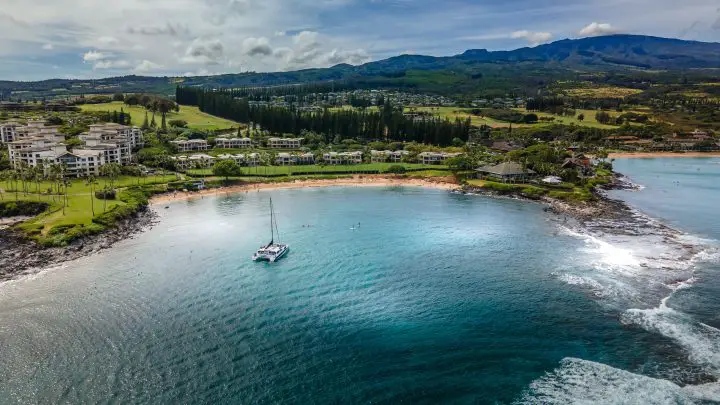
Comfortable Living Space
The huge salons and cockpits catamarans offer, with comfortable seating at big tables, truly improve your life at sea. The importance of all the light and air coming through those windows can’t be underestimated—it’s great at anchor when enjoying the sunset. But it’s also great to have an interior nav station where you can keep watch from the comfort of the salon. In short, a liveaboard catamaran is one of the most comfortable options for any type of cruising.
Better Speed, Especially Downwind
Compared to monohulls of similar length, catamarans are nearly always faster. This goes for fast catamarans, sure, but also for cruising catamarans. This becomes very apparent when traveling downwind, something that most monohulls struggle with. And downwind is the preferred direction to travel on a sail around the world route .
Comfort at Sea
The lack of heeling makes catamarans the preferred choice for long distance sailing. When given the choice of doing a 20-day passage perfectly upright or at a 10-degree tilt, which would you pick? Even the saltiest of sailors has to agree that heeling over is fun for a while but gets tiring quickly.
Redundant Systems and Structures
With two hulls, two engines, two water tanks, two fuel tanks, two sets of bilge pumps, and tons of other redundancy built in, catamarans offer owners extra layers of safety.
If all of this sounds too good to be true, it’s because we haven’t discussed the most limiting factor for most sailors—the cost of the boat! Catamarans are expensive from the outset. When juggling all of the factors with an around-the-world cruise, boat cost is the biggest.
Catamarans cost more than monohulls for many reasons. They are larger, but even still, they often sell for more. One reason is their popularity. These boats are in demand. Far fewer examples are on the market than monohulls, and more buyers are looking to purchase them. So prices are high and are likely to stay high. On the other hand, Monohull prices are much lower because there are more monohulls out there than there are monohull buyers.
With any boat, there is also the cost of keeping it once you own it. The larger the boat, the greater your expenses will be. This is true for everything from maintenance to storage. Catamarans cost more than monohulls in nearly every instance. For maintenance, you’ll be limited to facilities that can haul a boat with your width—which will be more expensive. You’ll have two engines, which means twice the maintenance and twice the replacement cost when that time comes.
Choppy Motion
Despite all the plusses and the flat ride, plenty of sailors out there just don’t like the ride a catamaran offers. You have to take one to sea to understand fully. A catamaran is light and tries to fly across the water, from wave to wave. It smacks each wave twice and always tries to come back upright after each impact. This leads to a choppy, jarring ride sometimes.
A monohull is built heavy and is designed to slice through the waves and push the water out of its way. The wind pressure on the sails keeps the boat’s angle steady (in most cases). So, a heavy monohull can ride quite comfortably in a chop, whereas a catamaran might feel like it’s taking a pounding. Many heavy-displacement monohulls built for long-distance travel were designed to provide a soft, comfortable ride that allows the crew to rest.
All sea conditions are different, as are all sailors and their expectations. So this is a personal choice as to which method you like better. And for every condition uncomfortable in a catamaran but smoother in a monohull, there’s something smooth and lovely in the cat and uncomfortable in the monohull. The ocean is just like that.
All cruising cats over about 40 feet are capable, and most have become proven circumnavigators in the past few decades. The right one for you simply comes down to the balance of cruising amenities versus performance. Fast catamarans are all the rage, but you’ll have to put a price on exactly how much performance you can afford.
To learn more about other boats before deciding, check out:
- Catamaran vs Pontoon
- Yacht vs Sailboat
What type of boat is best for sailing around the world?
The type of boat best suited to sailing around the world is a well-built, long-distance cruising boat. Many sailboats fall into the camp, both monohulls and catamarans.
This question has a million answers. Ask every sailor who wants to go around the world, and you’ll get a different one. And, once they’ve sailed around the world on that boat, they’d choose a different boat. The only rule is that there is no perfect boat.
What is the best catamaran to sail Caribbean?
Catamarans are extremely popular in the Caribbean because their open-air living space allows cooling airflow. Their living space is supremely suited for the tropical environment—imagine living al fresco on the waterfront all the time!
The right catamaran for the job depends on your group size and how long you intend to spend aboard. Full-time liveaboard couples prefer cats in the 38 to 44-foot range, while small families opt for something slightly larger.
Are catamarans easier to sail?
Catamarans are easy to sail—but similar to sailing a similar-length monohull sailboat. Beginners sometimes find them less intimidating because they do not heel and therefore seem more stable. However, monohulls are more forgiving of errors. Catamarans have large sails and rigging, and reefing early to avoid overloading the rig is extremely important on these boats. For more on beginner boats, check out my post: Best Boat for Beginners .
Matt has been boating around Florida for over 25 years in everything from small powerboats to large cruising catamarans. He currently lives aboard a 38-foot Cabo Rico sailboat with his wife Lucy and adventure dog Chelsea. Together, they cruise between winters in The Bahamas and summers in the Chesapeake Bay.
Leave a comment
Your email address will not be published. Required fields are marked *
Save my name, email, and website in this browser for the next time I comment.

- BOAT OF THE YEAR
- Newsletters
- Sailboat Reviews
- Boating Safety
- Sailing Totem
- Charter Resources
- Destinations
- Galley Recipes
- Living Aboard
- Sails and Rigging
- Maintenance

Best Cruising Catamarans
- By Cruising World Editors
- Updated: July 1, 2021
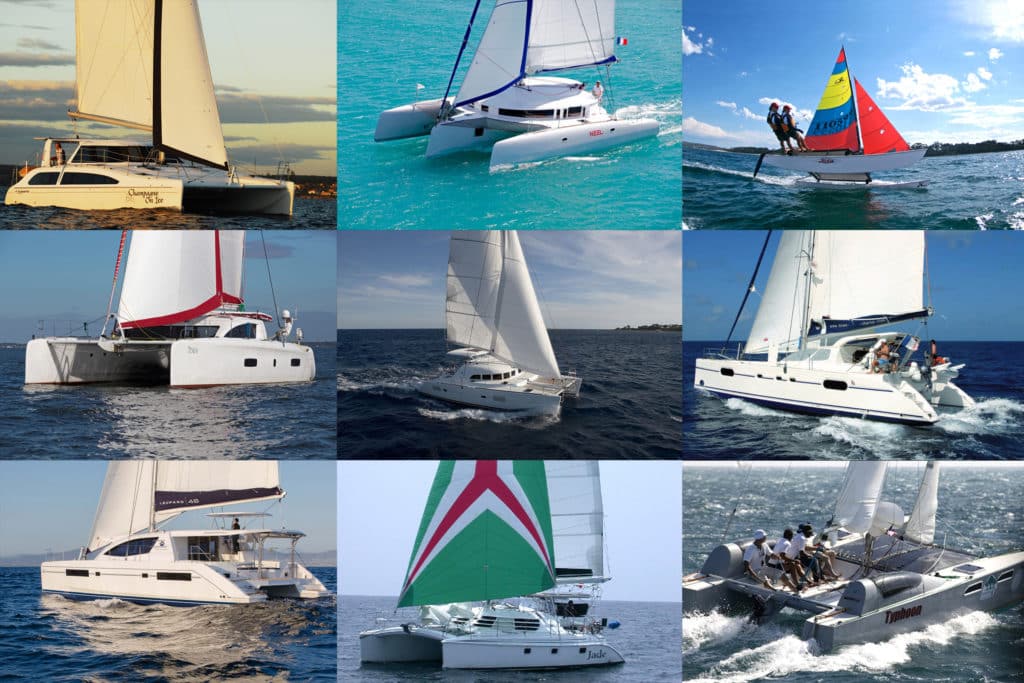
Cruising catamarans have been around for decades, but early models—often plywood and fiberglass vessels built by their owners from plans and kits, kept the boats on the fringes of mainstream sailing. That all changed, though, as big roomy cats were discovered by sailors who went off to charter in the Caribbean, where the multihulls proved their worth as comfortable liveaboard and party boats.
Today’s bluewater catamarans roam the globe, carrying families to exotic destinations across the Pacific and beyond. Just as with their monohull cousins, there is no best catamaran. Instead there is a wide variety of designs, ranging from small catamarans that offer the ease of maintenance a couple might enjoy to performance catamarans capable of easily knocking off 250-mile days. Today, the best catamaran brands offer a range of size models and layouts that can be optimized for an owner sailing with family and friends, or for the charter market, where there’s a demand for four, five and even six cabins worth of accommodations.
The most prolific catamaran manufacturers are in France and South Africa where yards include both large-run production builders and niche companies building fewer than 10 boats a year.
The best cruising catamarans offer good load-carrying ability and respectable performance. As with any sailboat , a modern catamaran’s design is a result of compromises. Daggerboards or keels? Galley up or galley down? Spacious owner’s cabin or extra bunks? There are lots of options to choose from—and that’s what makes looking at these sailboats fun!
Here, then is an eclectic A to Z list of some of the best catamarans that have helped shaped the evolution of how we live and sail on two hulls.
Antares 44i
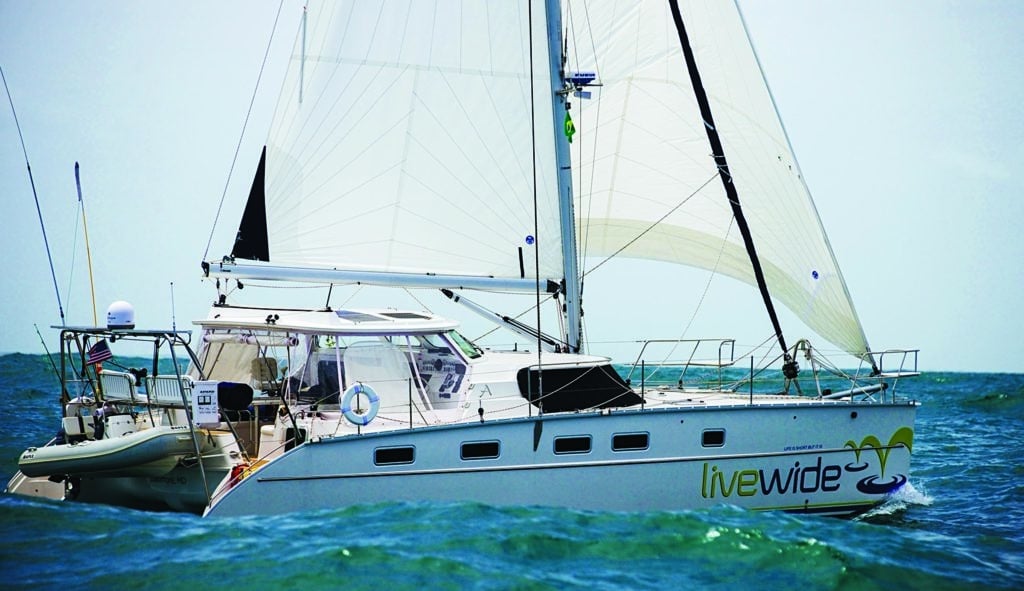
Now built in Argentina as a full-fledged, bluewater catamaran and cruiser that can be safely operated by a shorthanded couple or family crew, the Antares 44i features a fully covered cockpit with a quartet of big, standard solar panels recessed within the hardtop, one example of a yacht capable of long-range passagemaking.
Atlantic 42
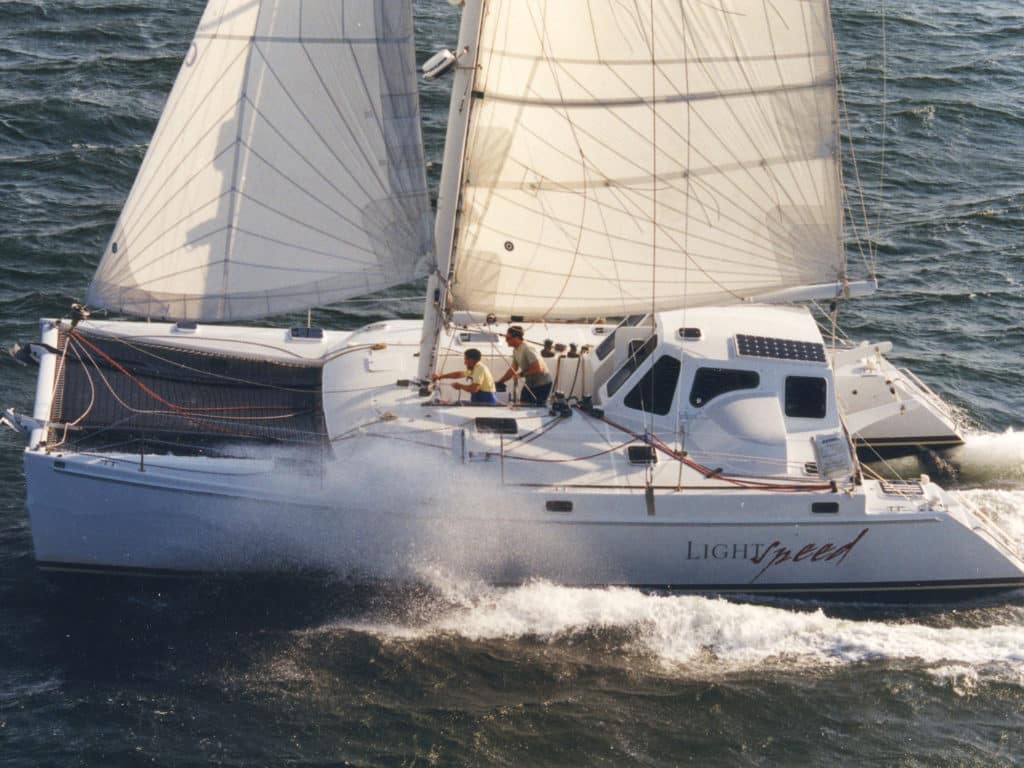
Almost 30 years ago, yacht designer Chris White revolutionized catamaran design with the first in his series of Atlantic cats, the primary feature of which was the innovative mid-ship sailing cockpit forward of the main cabin. The smallest in the Atlantic line, the 42 remains White’s most popular design ever.
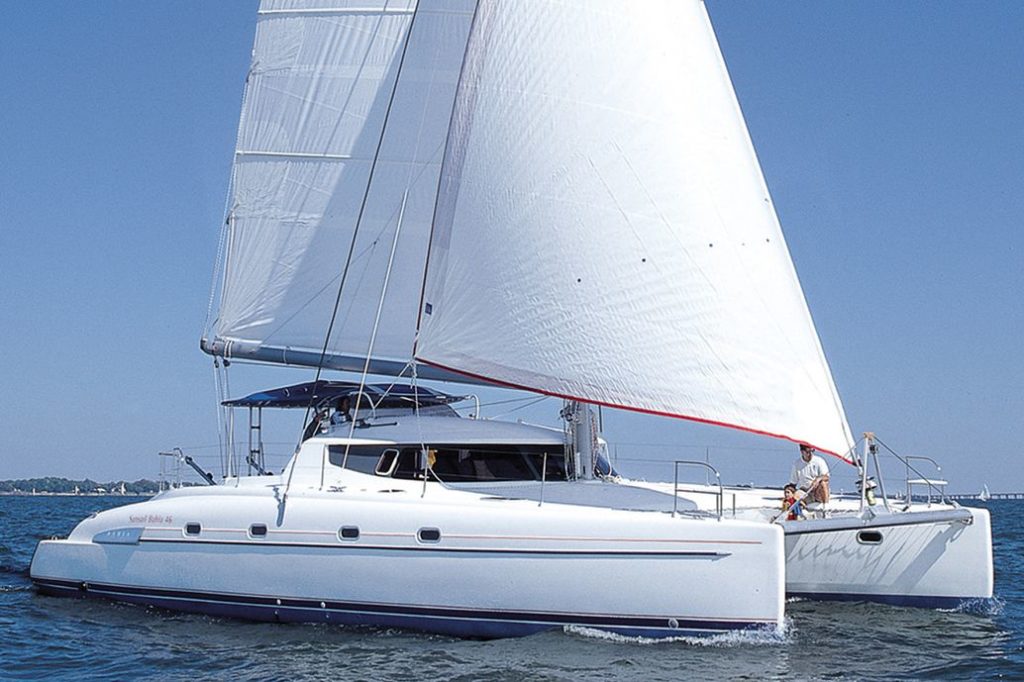
Fountaine-Pajot has built so many outstanding cruising catamarans that it’s difficult to narrow down any single boat, but we’ve always been fans of the good-looking, well-thought-out Bahia 46. At 46 feet, the boat is large enough for offshore forays and has plenty of volume; with its simple but powerful sail plan, it’s also an excellent performer.
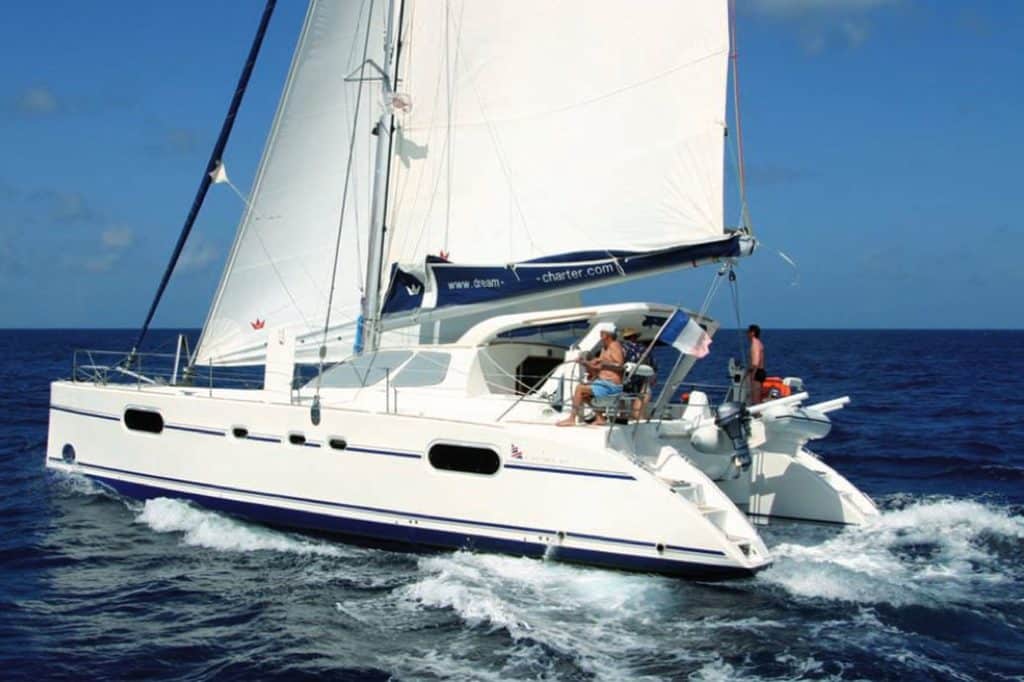
Beginning around 1996, the French builder Catana was one of the first companies to manufacture fully found cruising cats for private ownership, and this Christophe Barreau design, which enjoyed a nearly 10-year production run from 1997-2006, was emblematic of this first generation of safe, fun, long-legged offshore voyagers.
Click here to see more cats from Catana.
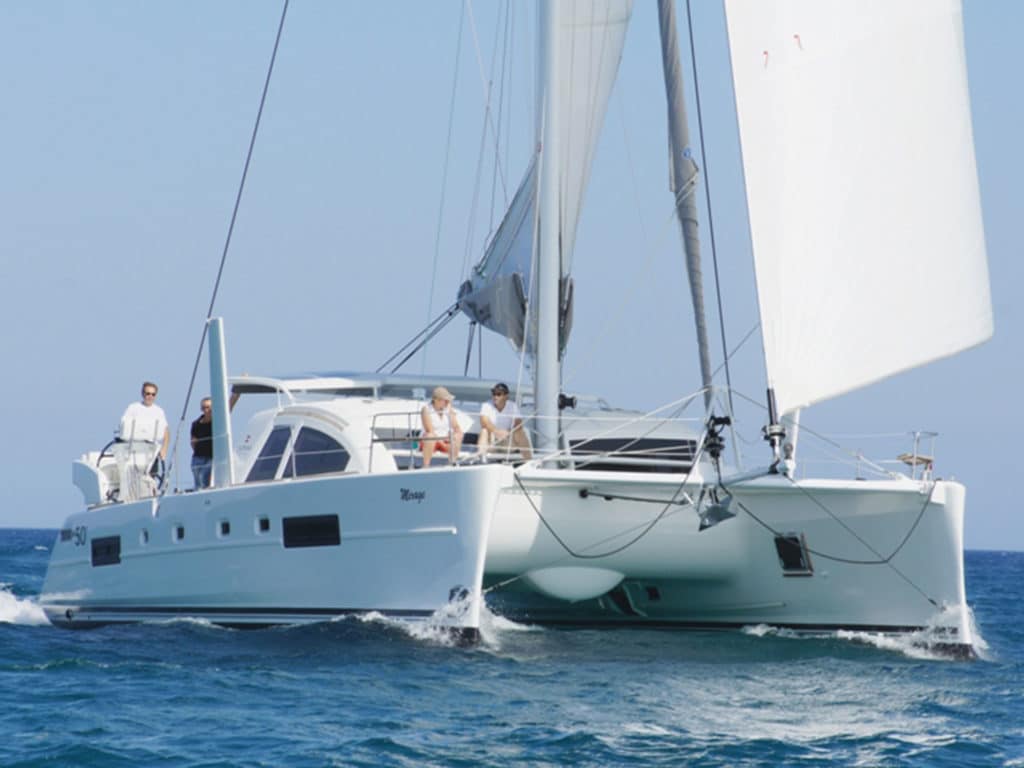
When it comes to speed, light boats are fast ones. And if you wish to save weight, that means exotic modern materials like carbon. Catana now infuses the laminates of their entire production line with carbon fiber, and for this list, we’ve chosen the Catana 50 Carbon, one of the zippiest cats now crossing oceans.
Click here to read about a couple’s charter aboard a Catana 50.
Gemini 105M
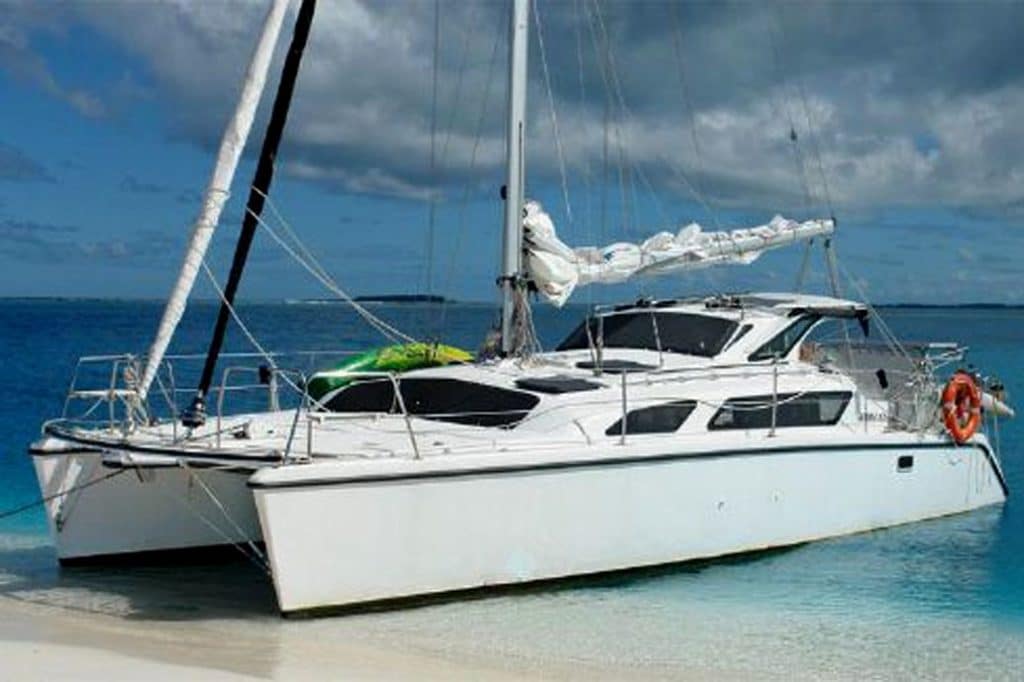
Pioneering catamaran sailor, builder and designer Tony Smith launched the first of his 33-foot Gemini 105M’s (10.5 meters = 33′) in 1993, and soon after found a ready and willing stream of sailors enamored of the boat’s compact size, affordable price tag, and such innovations as the nifty lifting rudder and transom steps.
Click here to read about the Gemini Legacy 35.
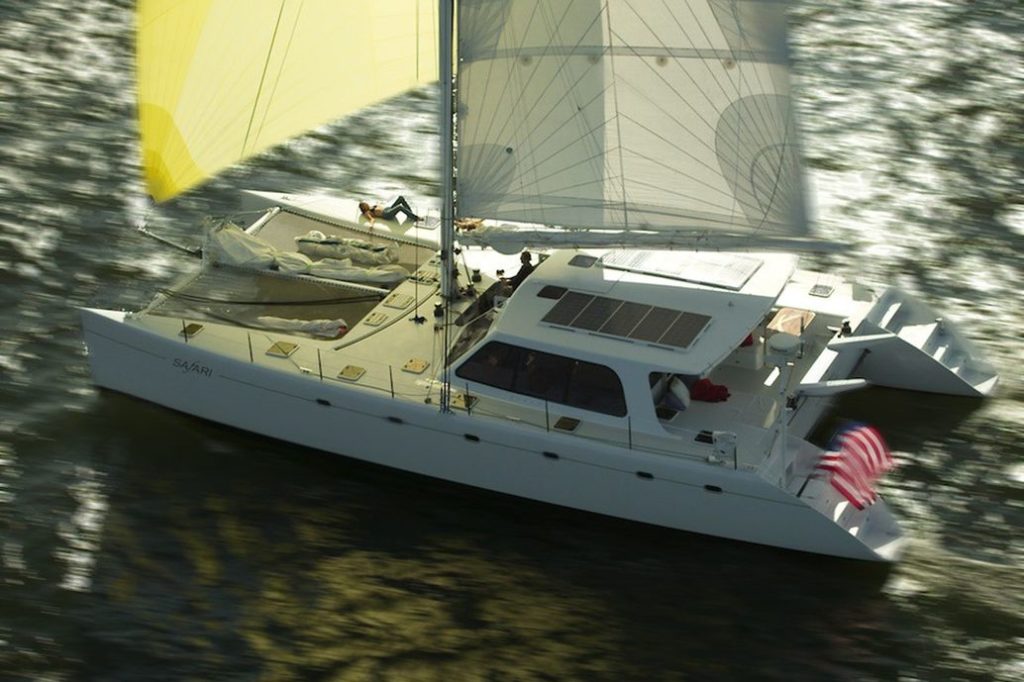
Built between 2000-2005, the Gunboat 62 firmly established the Gunboat brand: go-anywhere cats that applied race-boat technology to a world-cruising platform. Hull no. 1, Tribe, was built for company founder Peter Johnstone, who then spent a year-and-a-half cruising with his family, smiling all the way.
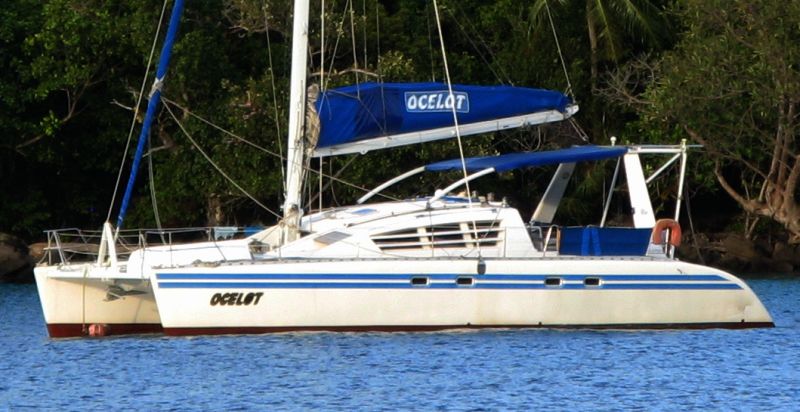
French builder Henri Wauquiez is best known for his long career building monohulls, but the Kronos 45 cat, which he launched in 1992, was ahead of her time. Classic lines, the aft “targa bar” over the cockpit, the louvered coach roof windows, even the distinctive stripes on her hull: the Kronos 45 remains timeless.
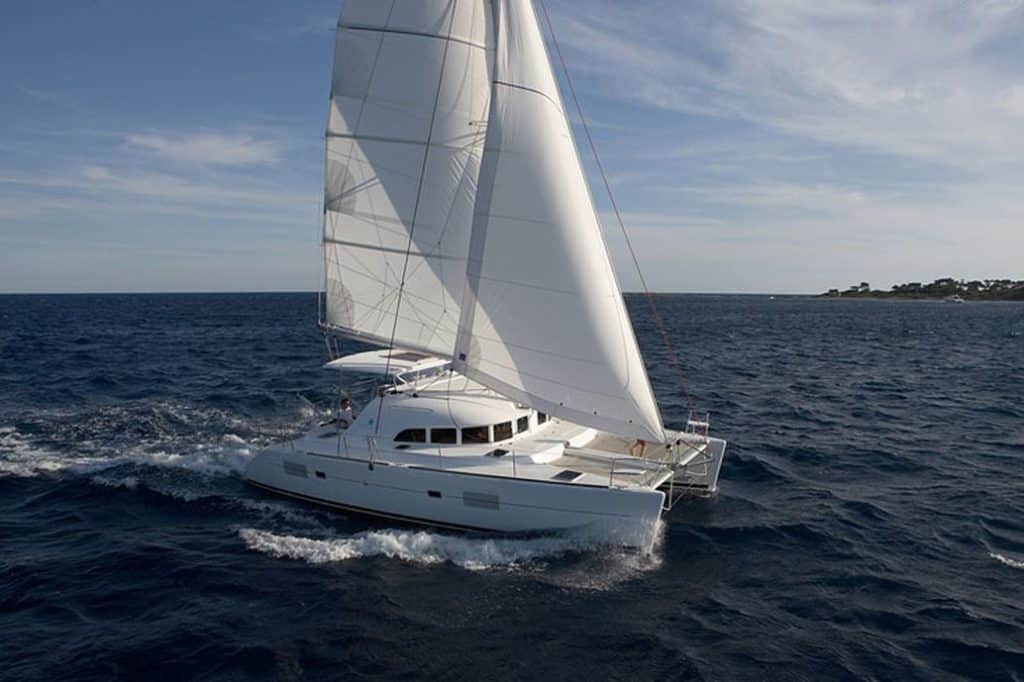
No roundup of cruising cats would be complete without several Lagoon entries, and the best of that impressive bunch might well be the Lagoon 380. Originally launched in 1999, and revered for its combination of quality, volume and performance, with over 740 boats built the 380 is still going strong.
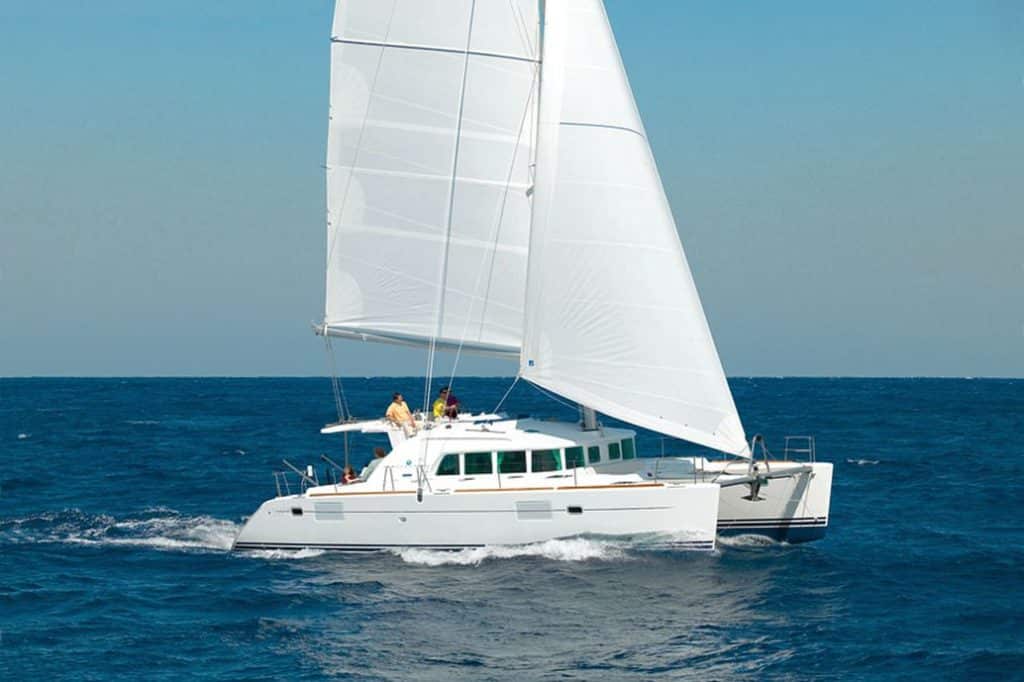
Launched five years after the breakthrough 380, the Lagoon 440 was an evolutionary design that featured a raised flybridge helm station, a unique “gullwing” configuration below the bridge deck, expanded windows in the hull and much more. With 400 boats built in a 6-year production run, the 440 was an unqualified success.
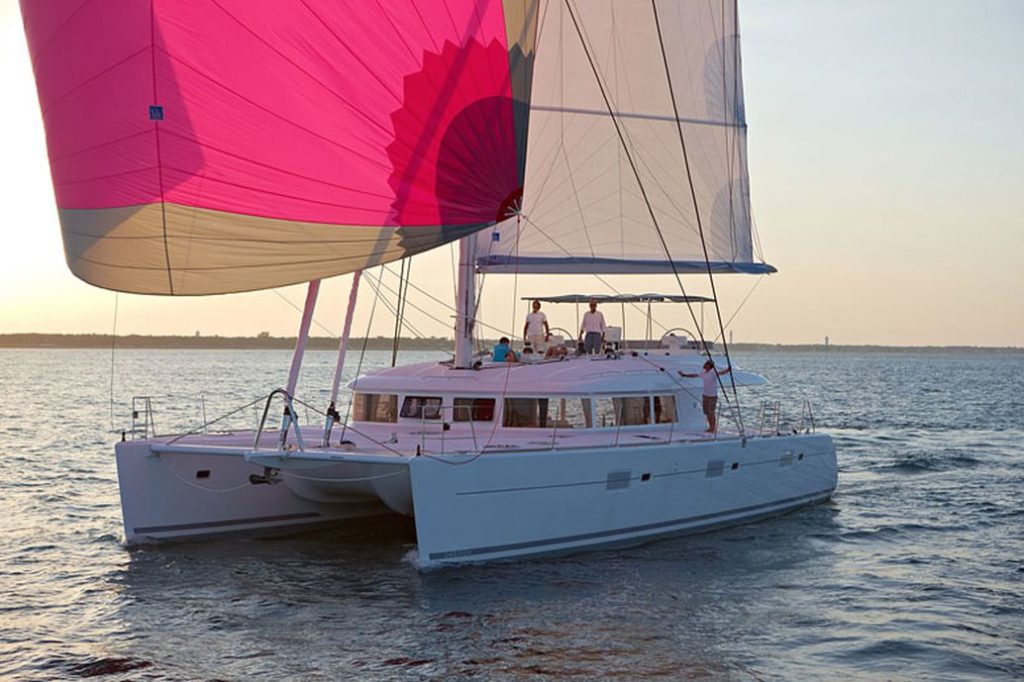
How big can a production cat, still operable by a short-handed crew, really be? The builders at Lagoon discovered that 62-feet hit a sweet spot in the marketplace, and have sold over 70 boats since its introduction in 2010. The centerpiece of this design is the sensational steering station atop the flybridge, with expansive views of the sea and sky.
Click here to see more cats from Lagoon.
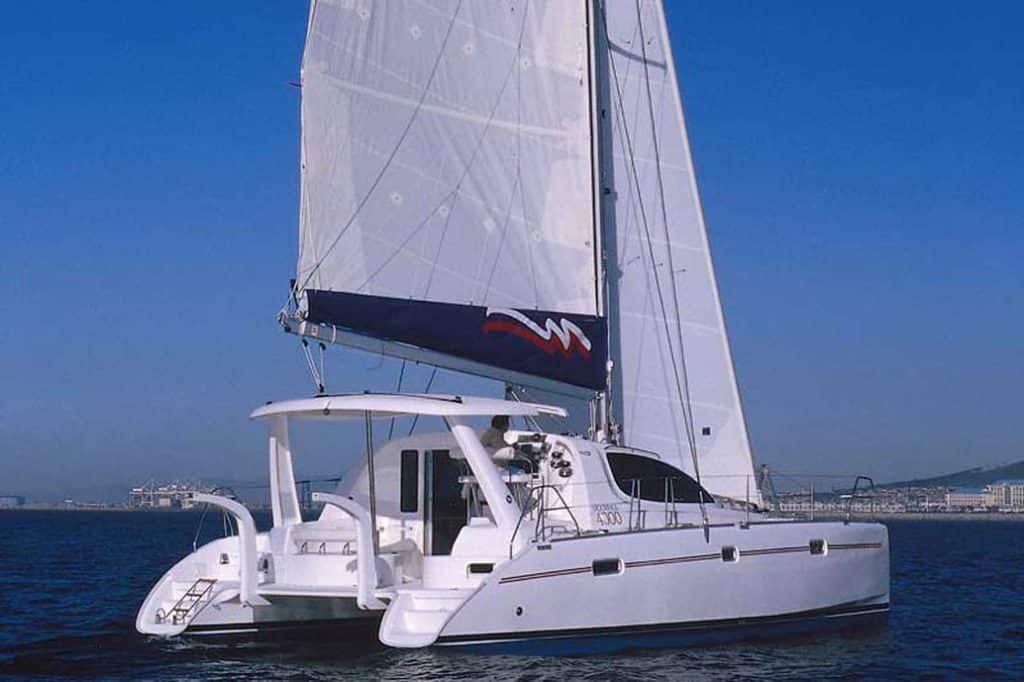
With an unmatched pedigree – designed by premier multihull naval architects Gino Morelli and Pete Melvin, built by the prestigious Robertson & Caine boatyard in South Africa, and commissioned by chartering giant The Moorings – the Leopard 40 was, perhaps unsurprisingly, Cruising World ’s Import Boat of the Year in 2005.
Louisiane 37
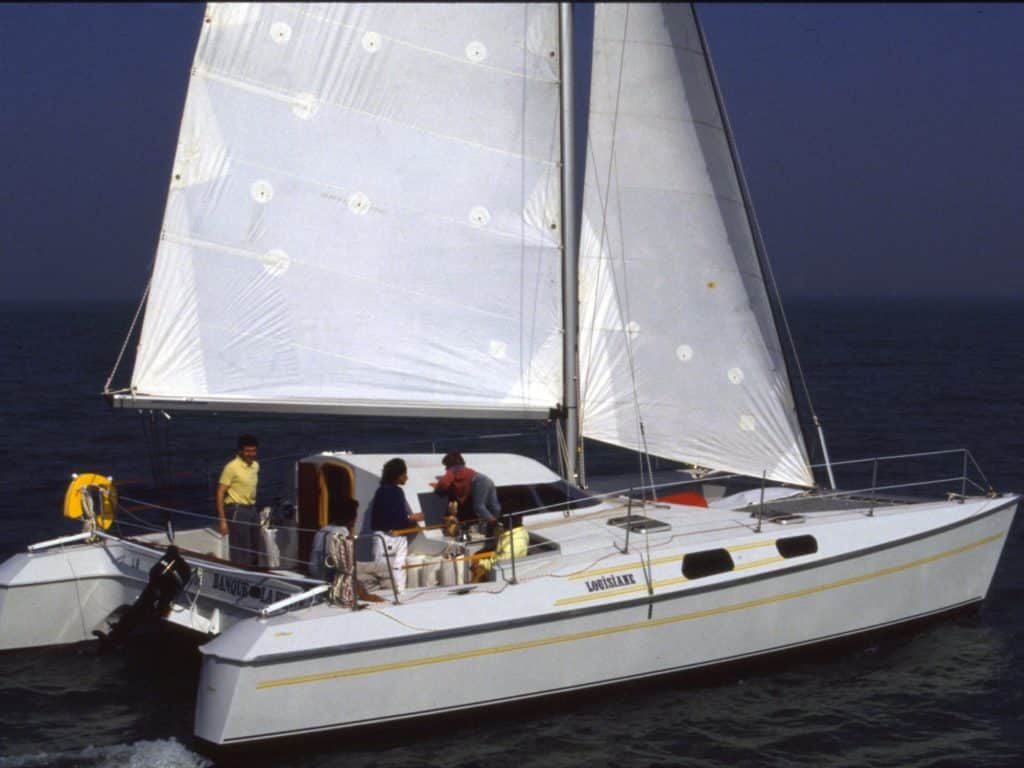
Based on the famous French racing cat Charente-Maritime, the Louisiane 37, designed by Joubert/Nivelt and launched by builder Fountaine-Pajot in 1983, was a light, fast liveaboard cruiser with full accommodations that represented a radical departure from the hefty British cats that preceded it.
Maine Cat 30
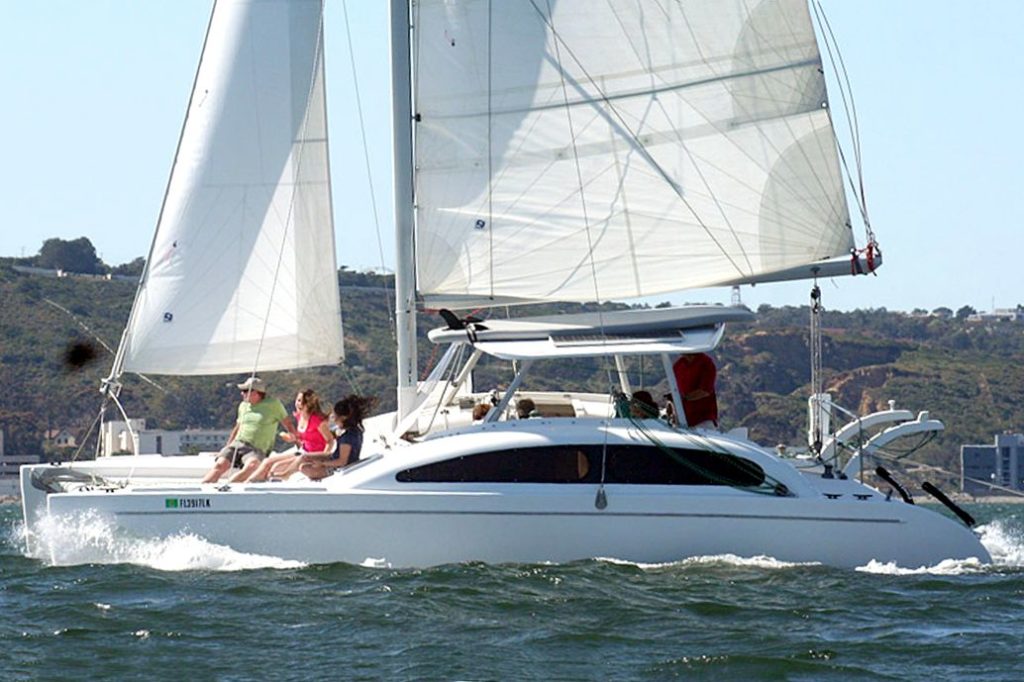
One of the more versatile and clever cats ever created, the central feature of the cool Maine Cat 30 is the open bridge deck/living room sandwiched between the hulls and canopied by a rigid, permanent hard top (the comfortable accommodations/ staterooms are stationed in the hulls). Ideal for a winter in the Bahamas but with the ability to sail offshore, it’s a boat for all seasons and reasons.
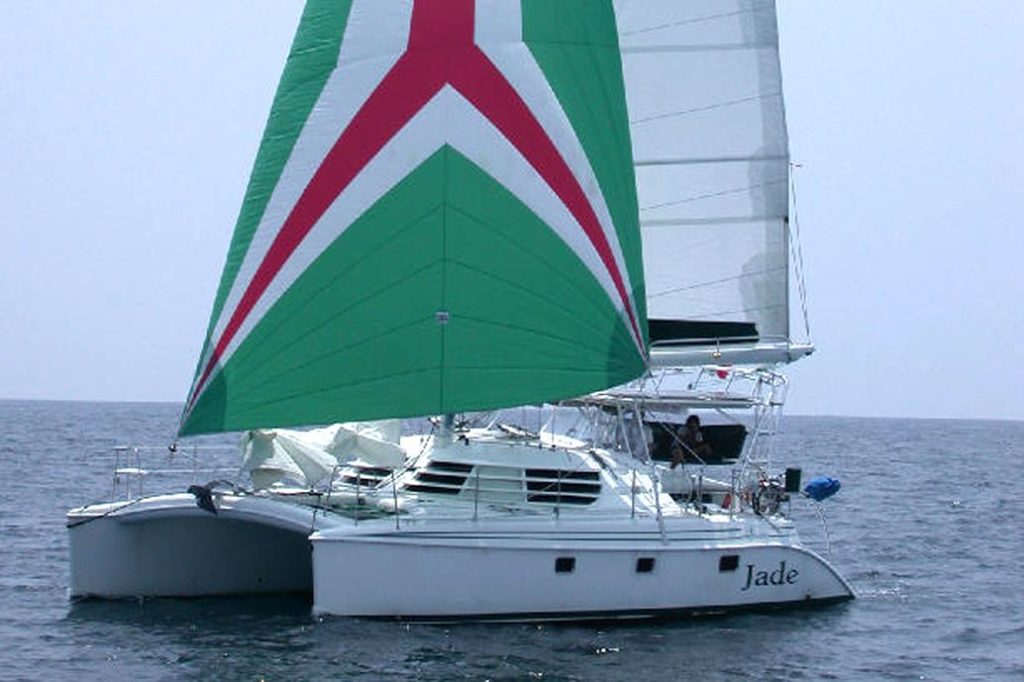
Built in Florida and beloved by the owners of the over 120 boats built during the company’s existence from 1993 to 2009, the Manta Catamarans range included 38-, 40- and 44-foot cats. For this exercise, however, we’re heralding the original Manta 42, which won the Best Value Overall prize in CW’s 2001 Boat of the Year contest.
Moorings 4800/Leopard 48
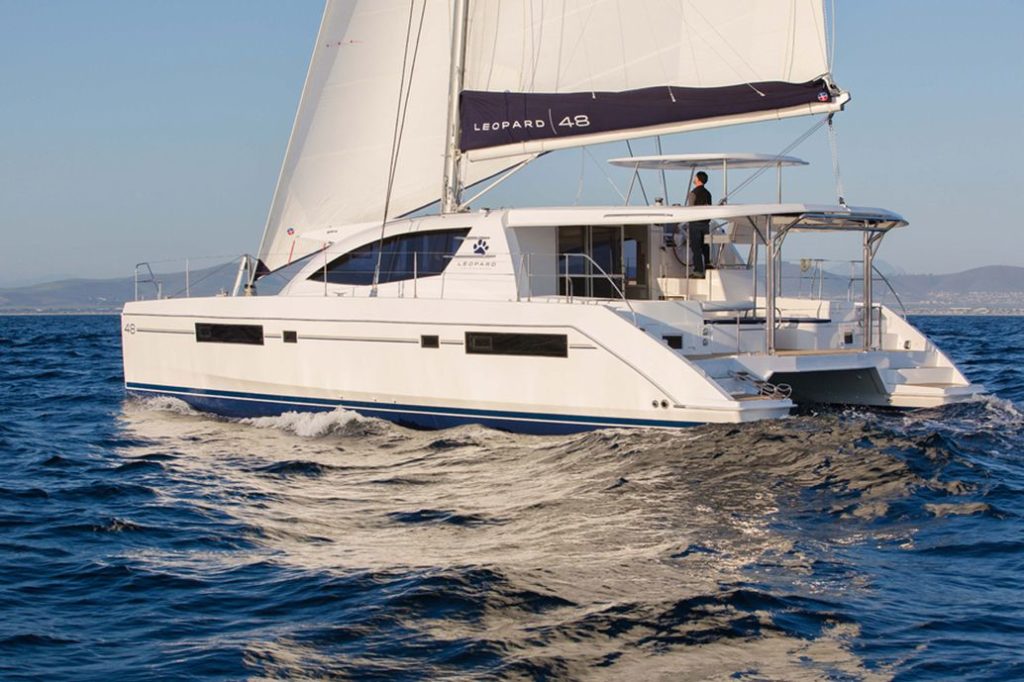
Another Leopard/Moorings collaboration built by the wizards at Robertson & Caine (though this boat was designed by fellow South African Alex Simonis), the Leopard 48 was another CW Boat of the Year winner with all the contemporary bells and whistles: forward cockpit, flybridge helm station and solid hardtop dodger, just to name a few.
Click here to read more about the Leopard 48, and click here to see more images.
Nautitech 441
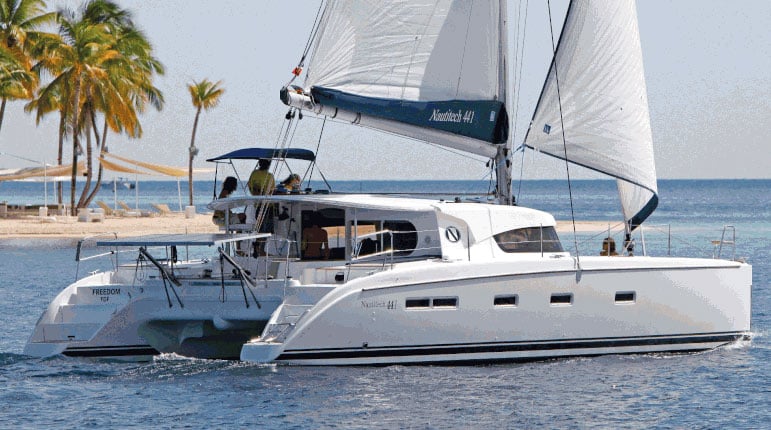
The Best Multihull Under 45 Feet: So said the CW judging panel in the 2013 Boat of the Year competition, regarding the Nautitech 441. But what makes this versatile platform so intriguing are the different helm set-ups. The 441 employs a single wheel, to starboard, ideal for solo sailors, while the 442 has a pair of helm stations aft.
Click here to see more Nautitech Catamarans.
Outremer 5X
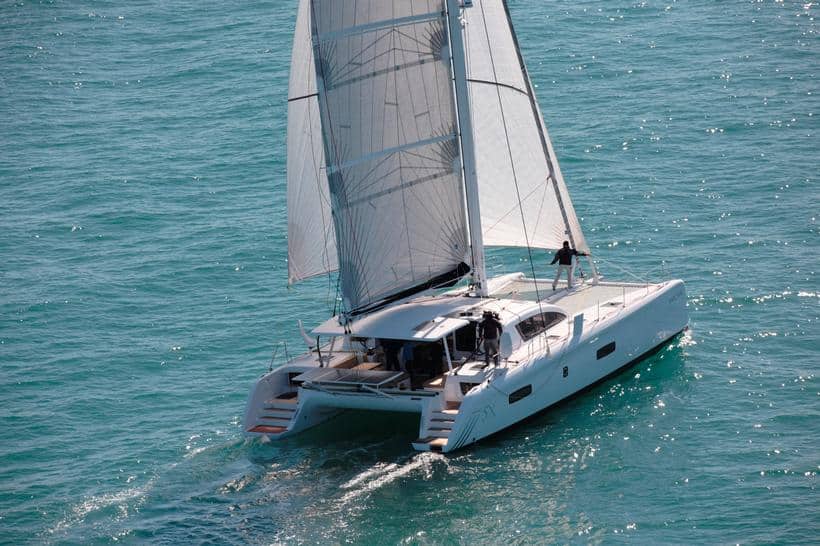
A state-of-the-art all-oceans cat that exemplifies how far multihull design has come, the 59-foot Outremer 5X was a winner on both sides of the Atlantic, taking top honors in the European Boat of the Year competition in 2013, and following up as the Best Full-Size Multihull in CW ’s contest a year later.
Click here to see more cats from Outremer.
St. Francis 50
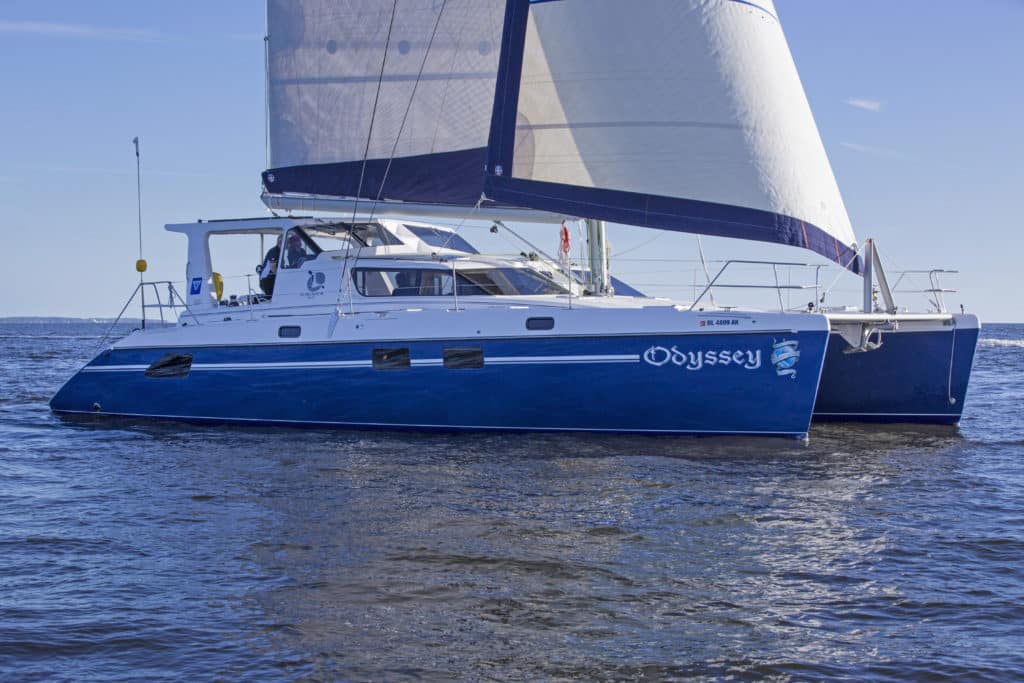
The flagship of the proud St. Francis line – built in South Africa since 1990 to designs by local legends Lavranos Marine Design – the St. Francis 50 is another “luxury cat” that shares much in common with an earlier 48-foot sister-ship, but packs even more payload into its roomier lines.
Click here to read more about the St. Francis 50
Seawind 1000
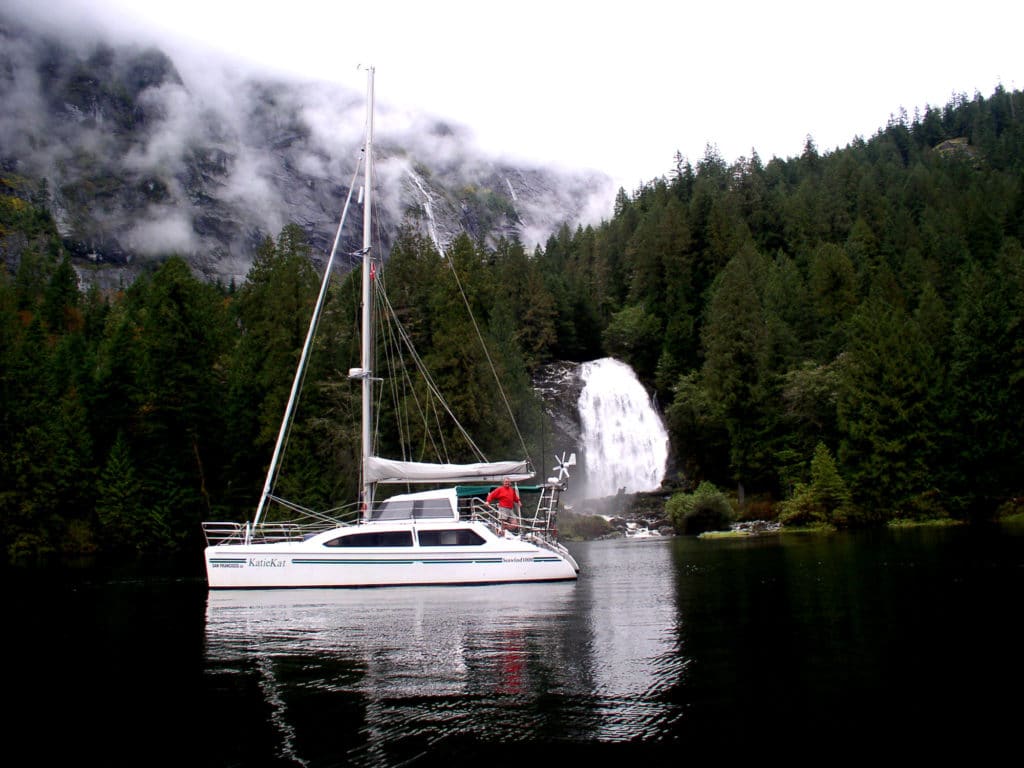
Founded by Aussie surfer and sailor Richard Ward in 1982, the 33-foot Seawind 1000 is easily the most popular cruising cat ever built in Australia (the company has since moved its manufacturing and management operations to Vietnam). Roomy and airy, these cats dot the coastline of eastern Oz.
Seawind 1160
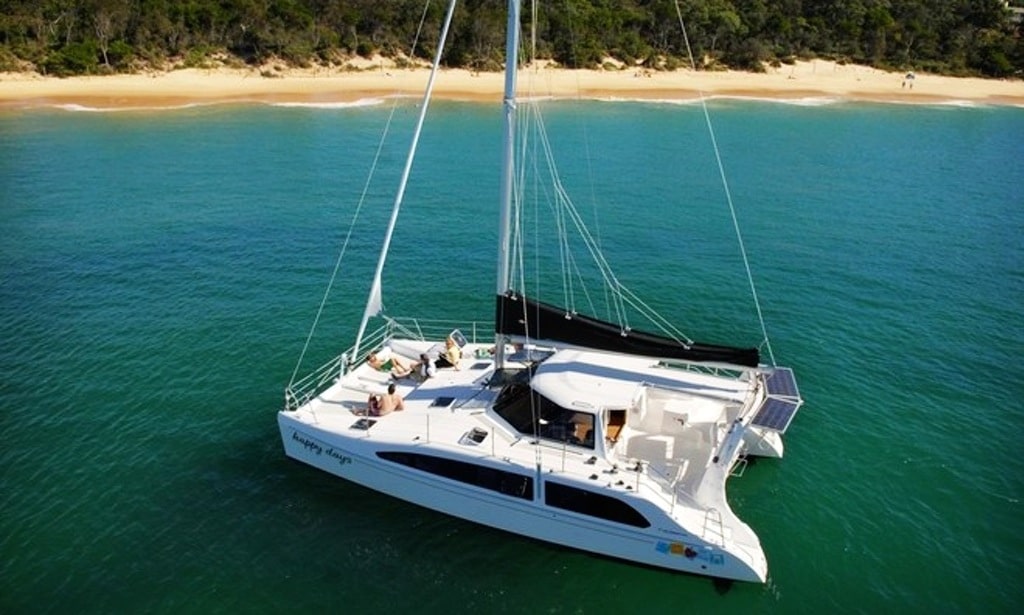
If the Seawind 1000 was a minimalist approach to cruising cats, the 38-foot Seawind 1160 is the flip side of the coin, a full-fledged long-range voyager. Among the reasons it was named CW ’s Most Innovative boat for 2007 is the unique “tri-folding” door that stashes overhead to open up the saloon and cockpit into a spacious living area.
Click here to read more about the Seawind 1160.
Sunsail 384
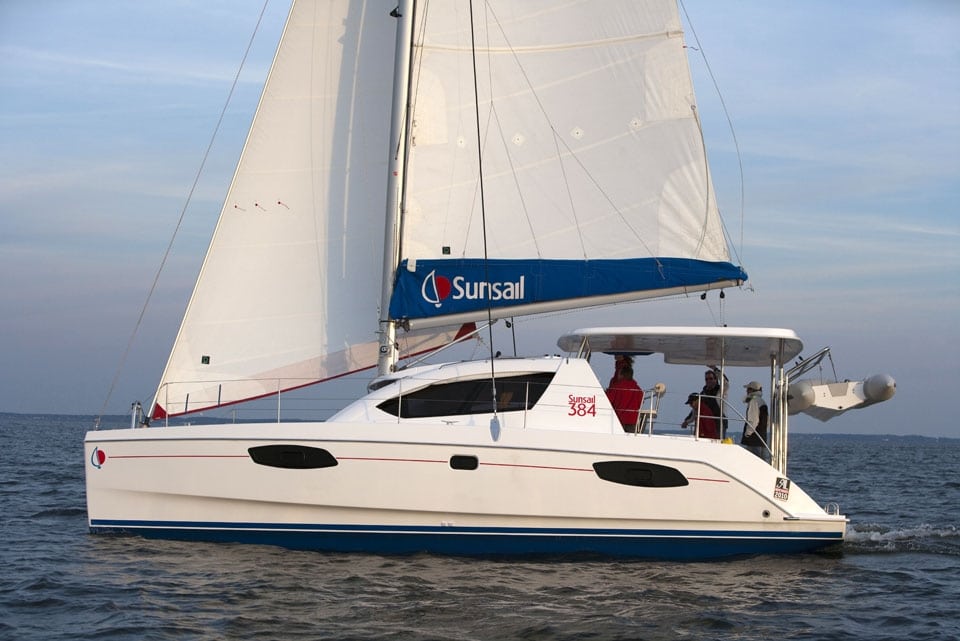
Every sailboat is a compromise, and in the case of the Sunsail 384 (also sold privately as the Leopard 38) that’s a good thing, because designers Morrelli & Melvin and builder Robertson and Caine got the balance just right with this relatively small catamaran. With four cabins, the 384 can carry the same size bareboat charter crowd as her larger siblings, but does so with a decided bounce in her step. Named CW’s Import Boat of the Year in 2010, you can gauge the success of the design by the grins on the crew as they barrel down Sir Francis Drake channel in the British Virgin Islands.
Victoria 67
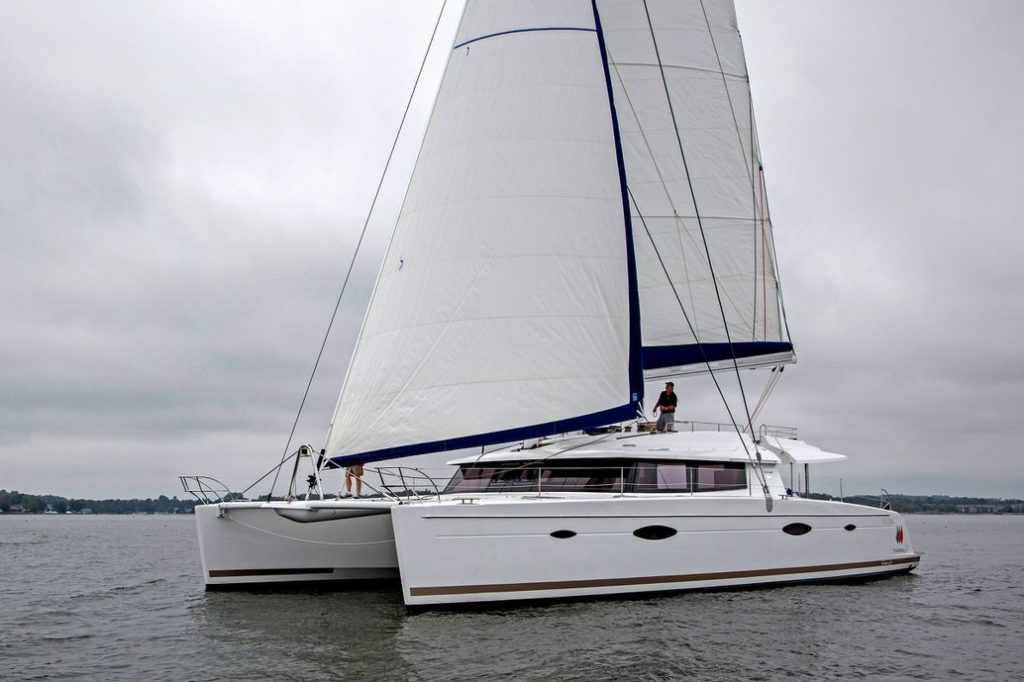
The French design office of Berret Racoupeau drafted the lines of Fountaine-Pajot’s new flagship, introduced in 2013, a magnificent world-girdling voyaging catamaran. Like other giant cats launched in recent years, the boat features a sensational upper deck with all sail controls, helm and lounging stations.
Click here to see more images of the Victoria 67.
Wharram Tanaroa
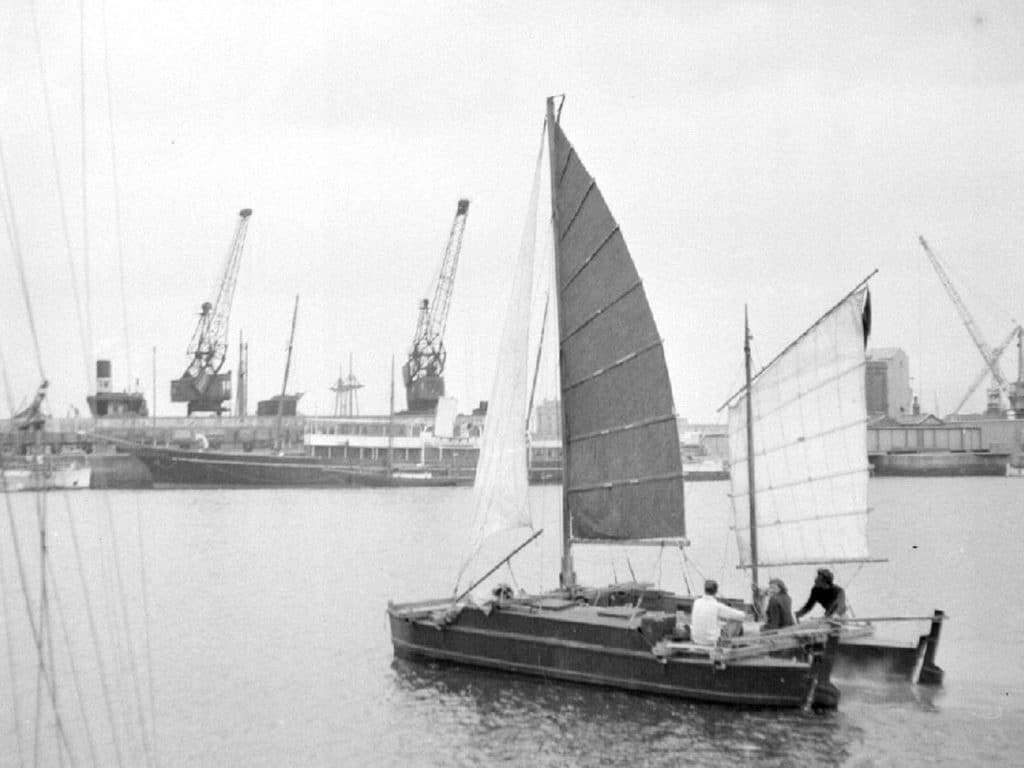
No list of influential multihulls would be complete without the work of James Wharram, and while Tangaroa wasn’t a production cat by any means, it showcases the British designer’s respect for ancient Polynesian craft. Wharram sailed this 23-foot-6-inch “double-hulled canoe” across the Atlantic in the 1950s, and sold countless plans for similar boats for decades afterwards.
- More: Boat Gallery , catamaran , multihull , Sailboat Reviews , Sailboats
- More Sailboats
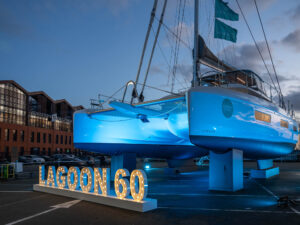
Lagoon 60 Prepares for World Premiere
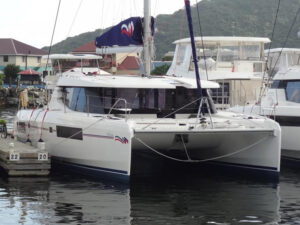
Now For Sale: Leopard 45
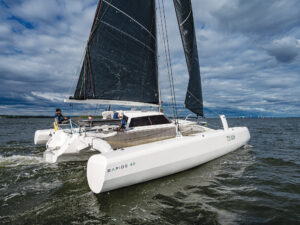
Sailboat Review: Rapido 40
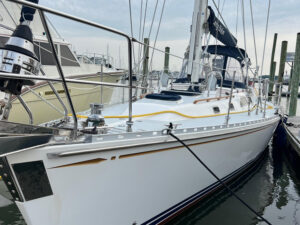
For Sale: 2002 Hylas 46
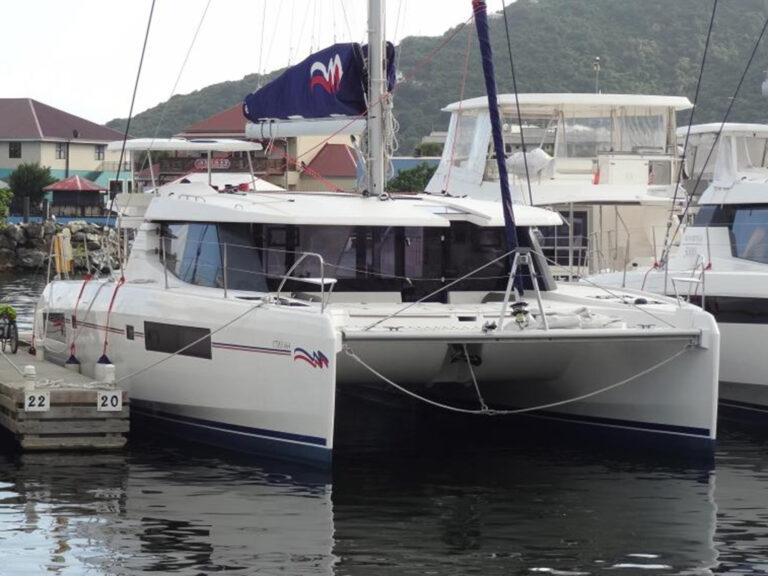
The Long Way Around

Sailing to the Land of Shrimp
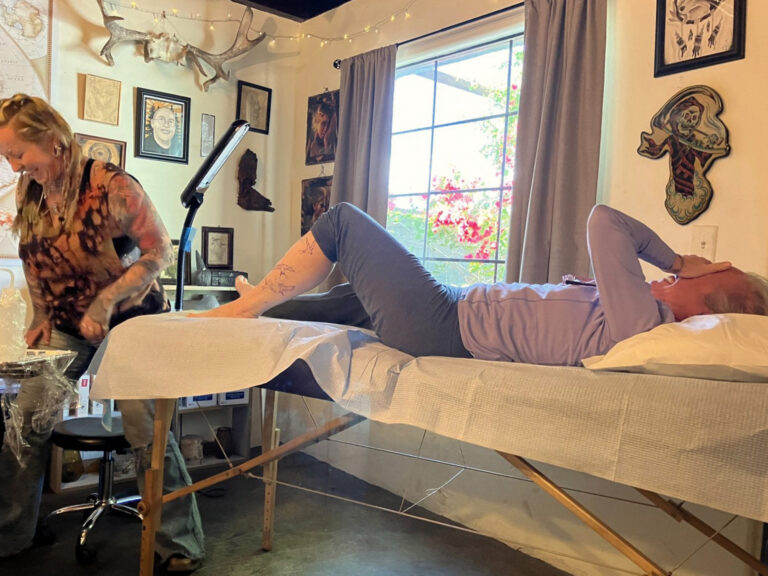
Swallow Tattoos and Sailors
- Digital Edition
- Customer Service
- Privacy Policy
- Email Newsletters
- Cruising World
- Sailing World
- Salt Water Sportsman
- Sport Fishing
- Wakeboarding

Choosing the Perfect Size Catamaran for Your World Sailing Adventure
Alex Morgan
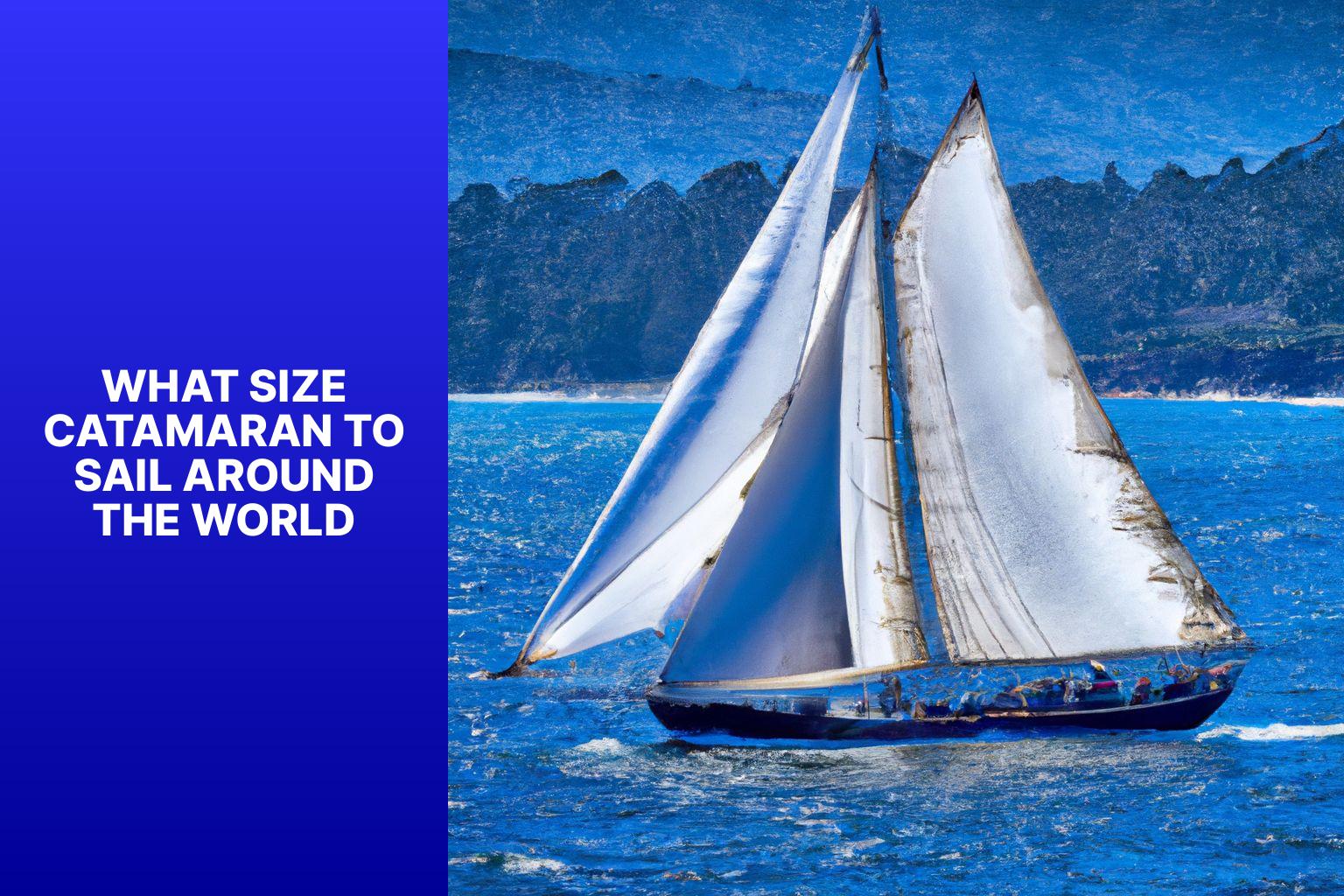
Sailing around the world is a dream for many adventurers, and choosing the right catamaran size is crucial for a successful and enjoyable journey. A catamaran, with its stability, spaciousness, and ability to navigate shallow waters, is an ideal choice for long-distance cruising. In this article, we will explore the factors to consider when selecting a catamaran size for sailing around the world and the options available. We will also discuss important features and considerations, including stability, storage capacity, sailing performance, crew requirements, and cost. personal considerations such as budget, sailing experience, comfort, and navigational plans will be taken into account. We will provide some valuable tips for preparing and sailing a catamaran around the world, including safety measures, navigational tools, provisioning, weather monitoring, and communication. Whether you’re a seasoned sailor or embarking on your first long-distance voyage, this guide will help you make an informed decision about choosing the right catamaran size for your global sailing adventure.
Key takeaway:
- Choosing the right catamaran size is crucial for sailing around the world. Factors like length, beam, draft, and displacement need to be considered.
- There are different size options available for catamarans, including small, medium-sized, and large ones, each with their own advantages and disadvantages.
- Features like stability, storage capacity, sailing performance, crew requirements, cost, and maintenance should be evaluated when selecting a catamaran size.
- Personal considerations such as budget, sailing experience, comfort, and navigational plans also play a significant role in determining the ideal catamaran size.
- Preparation for sailing a catamaran around the world involves safety equipment, navigational tools, provisioning, water management, weather monitoring, and communication.
Factors to Consider When Choosing Catamaran Size
When it comes to sailing around the world, choosing the right catamaran size is crucial. In this section, we’ll dive into the key factors to consider when making this decision. From the length and beam to the draft and displacement, each sub-section will uncover essential aspects that can impact your sailing adventure. So, let’s sail through these factors and discover the perfect catamaran size to conquer the open seas!
The length of a catamaran is important when choosing a vessel for sailing around the world. It affects the boat’s performance and functionality . Consider the table below that shows the different lengths of catamarans and their characteristics :
When considering the length of a catamaran, it is essential to factor in personal preferences and needs. A longer catamaran may offer more space and stability but might be harder to maneuver in tight spaces. On the other hand, a shorter catamaran may offer better maneuverability but have limited space for amenities and storage.
Let’s share a true story about catamaran length. John , an experienced sailor, chose a 45-foot catamaran for his journey around the world. The moderate length allowed him to comfortably accommodate his family while still offering ease of handling. He appreciated the balance between agility and living space that the 45-foot catamaran provided, making his sailing adventure enjoyable and fulfilling.
When considering the size of a catamaran for sailing around the world, it is essential to take into account the beam . The beam , which refers to the width of the catamaran measured from one hull to the other, plays a crucial role in the stability and living space of the boat.
Smaller catamarans generally have a smaller beam , resulting in less spacious living quarters and potentially reduced stability. They compensate by being more maneuverable, and they also have lower initial costs and maintenance requirements.
For those seeking a balance between living space and stability, medium-sized catamarans with a moderate beam are an excellent choice. They are easy to handle, offer a good combination of living space and stability, and come at a reasonable cost in terms of both purchase and maintenance.
Large catamarans, with their wider beams , provide generous living spaces and enhanced stability. They may be slightly less maneuverable compared to smaller and medium-sized catamarans. They generally come with higher initial costs and maintenance requirements.
By considering your priorities regarding living space, stability, maneuverability, and budget, you can determine the appropriate beam size for your catamaran when embarking on a journey around the world.
When selecting a catamaran size for sailing around the world, the draft becomes a crucial consideration. The draft pertains to the vertical measurement from the waterline to the deepest region of the hull, including the keels or daggerboards.
– Opting for a shallower draft proves advantageous for navigating shallow bodies of water, such as coastal areas , lagoons , and coral reefs . A catamaran with a draft ranging from about 2 to 4 feet proves fitting for these particular conditions.
– A moderate draft achieves a desirable equilibrium between stability and performance . Catamarans with drafts ranging from 4 to 6 feet demonstrate versatility and aptitude in a broad array of sailing conditions.
– A deeper draft confers benefits in terms of improved upwind performance and stability amid rough seas. Catamarans with a draft of at least 6 feet emerge as a superior choice for offshore passages and ocean crossings.
– The draft of the catamaran also exercises influence on anchoring possibilities. A shallower draft allows for access to more shallow anchorages, whereas a deeper draft might necessitate anchoring farther from the shore.
Historical records illustrate the evolution of catamaran drafts over time. Early catamarans possessed comparably shallow drafts suited for coastal cruising. Nonetheless, advancements in design and technology facilitated the adoption of deeper drafts, thereby enhancing stability and performance. Presently, catamarans offer diverse draft options that cater to various sailing preferences and destinations.
Displacement
When choosing a catamaran for sailing around the world, one important factor is displacement . Displacement refers to the weight of the water a catamaran displaces when floating.
Size of Catamaran Displacement
Small 10,000 to 20,000 pounds
Medium-sized 20,000 to 40,000 pounds
Large 40,000 to 60,000 pounds
The displacement of a catamaran affects its stability and how it handles waves and rough weather. A catamaran with higher displacement will generally have better stability and a smoother ride in challenging conditions.
It is important to note that higher displacement also means a larger and heavier catamaran, which can impact maneuverability and sailing performance. Smaller catamarans with lower displacement may be easier to handle and more nimble.
Ultimately, the choice of catamaran size and displacement depends on personal preferences, experience, and sailing goals. Factors such as budget, comfort, and navigational plans should be considered when making a decision.
Catamaran Size Options for Sailing Around the World
When it comes to sailing around the world, choosing the right catamaran size is essential. In this section, we’ll discuss the different catamaran size options available for this grand adventure. From small catamarans designed for maneuverability to medium-sized ones offering a balance of comfort and speed, and finally, large catamarans ideal for luxurious long-distance voyages. Join us as we explore the world of catamarans and find the perfect vessel for your nautical journey of a lifetime.
Small Catamarans
When considering small catamarans for sailing around the world, keep in mind:
– Length: Small catamarans range from 30 to 40 feet . These compact sizes make them easier to handle and maneuver in tight spaces.
– Beam: The beam, or width, of a small catamaran is usually around 15 to 20 feet . This provides stability and ample space for living and storage.
– Draft: The draft, or depth, of a small catamaran is typically shallow, ranging from 2 to 4 feet . This allows for navigation in shoal waters and easy anchoring.
– Displacement: Small catamarans have a lighter displacement compared to larger ones, typically ranging from 8,000 to 12,000 pounds . This allows for increased speed and agility.
One true story highlights the benefits of small catamarans . John and Jane sailed around the world on their 35-foot catamaran . The compact size of their small catamaran allowed them to access remote anchorages and explore hidden coves that larger vessels couldn’t reach. The shallow draft of their small catamaran also allowed them to navigate safely through coral reefs and shallow lagoons. The smaller size made it more manageable for just the two of them to handle all aspects of sailing. Their small catamaran provided them with comfort, ease of handling, and the ability to explore off-the-beaten-path destinations.
Medium-sized Catamarans
When selecting a catamaran of medium size, it is important to take into consideration various factors. These factors include:
Length: Medium-sized catamarans are typically between 40 and 50 feet in length. This size provides a good balance between spaciousness and maneuverability.
Beam: Medium-sized catamarans have a beam measurement of approximately 22 to 25 feet. This width ensures stability, which is essential for long-distance cruising.
Draft: The draft of medium-sized catamarans usually ranges from 4 to 6 feet. This shallow depth enables versatile sailing in different locations.
Displacement: Medium-sized catamarans typically weigh between 15,000 and 25,000 pounds. This weight range offers a harmonious combination of speed and comfort.
When making a decision on a medium-sized catamaran, it is crucial to consider your specific needs and preferences. Factors that should be taken into account include budget, living space requirements, and navigational plans. By thoroughly assessing these factors, you will be able to find a medium-sized catamaran that perfectly aligns with your sailing aspirations, no matter where in the world you wish to explore.
Large Catamarans
Large catamarans are the perfect choice for those looking to sail around the world. These magnificent vessels offer a plethora of advantages. They provide an abundance of living and storage space, ensuring utmost comfort during long journeys. Furthermore, large catamarans exhibit excellent stability even in rough seas, making them a safer option for extended offshore sailing .
Let’s take a look at a table that compares some key features of large catamarans :
Large catamarans are particularly suitable for individuals who prioritize space , comfort , and stability . It is crucial to consider the specific needs and preferences of the crew. For instance, a larger crew may be required to handle the size and complexity of a large catamaran .
Fun fact: Large catamarans often boast advanced navigation systems and modern amenities such as spacious cabins, lounges, and entertainment areas. These luxurious features provide sailors with an unparalleled experience while exploring the vast oceans of the world.
Catamaran Features and Considerations
When it comes to choosing the right catamaran for sailing around the world, understanding the key features and considerations is crucial. In this section, we’ll dive into the factors that can make or break your journey. From the stability that ensures a smooth ride to the storage capacity for all your essentials, we’ll cover it all. Plus, we’ll explore the catamaran’s sailing performance, crew requirements, and the cost and maintenance involved. Get ready to set sail with confidence!
Stability is important when choosing a catamaran for sailing around the world. A stable catamaran provides a comfortable and safe experience on long ocean passages. Here are some important points to consider:
1. Hull design: Look for catamarans with a wider beam for better stability. A wider beam offers a solid foundation and reduces the chances of capsizing.
2. Weight distribution: Proper weight distribution is crucial for stability. A well-balanced catamaran has evenly distributed weight across both hulls, ensuring stability at anchor and underway.
3. Center of gravity: The height of the center of gravity plays a significant role in stability. A lower center of gravity enhances stability, making the catamaran less prone to rolling in rough seas.
4. Bridge deck clearance: Bridge deck clearance is the distance between the bottom of the bridgedeck and the water. Sufficient clearance reduces the chances of ‘slamming’ when encountering waves, improving stability.
5. Wave-piercing bows: Some catamarans have wave-piercing bows that cut through waves instead of riding over them. This design can help enhance stability and reduce pitching in rough conditions.
Pro-tip: Find the right balance between stability and performance. While a highly stable catamaran is comfortable, it may sacrifice speed and maneuverability. Evaluate your sailing goals and prioritize stability accordingly.
Storage and Capacity
When considering storage and capacity on a catamaran, factors to take into account include:
- Storage Space: Evaluate the available storage space for belongings, provisions, and equipment.
- Cargo Capacity: Consider the maximum weight capacity for supplies, fuel, and water.
- Cabin Layout: Assess the number and size of cabins to ensure enough sleeping space.
- Deck Space: Consider the usable deck space for lounging, socializing, and storing equipment.
- Accessibility: Check if storage areas are easily accessible and secure against rough weather.
- Weight Distribution: Ensure even storage space distribution for stability and performance.
A true story highlights the importance of storage and capacity. A couple on a world sailing adventure underestimated their storage needs. The limited space caused inefficiency and frustration. This taught them the valuable lesson of considering storage and capacity for a smooth sailing experience.
Sailing Performance
Sail Area: The sail area of a catamaran greatly impacts its sailing performance, allowing for higher speeds and improved maneuverability in various wind conditions. The larger sail area provides better control and enhances the overall performance of the catamaran.
Hull Design: The design of the catamaran’s hull plays a critical role in optimizing its sailing performance. A sleek and streamlined hull reduces drag, enabling the catamaran to achieve faster speeds and increased efficiency during sailing.
Weight Distribution: Proper weight distribution is essential to ensure optimal sailing performance . A well-balanced catamaran with the correct weight distribution between the hulls maximizes stability and speed, ensuring smooth and efficient sailing .
Rigging and Sail Controls: The rigging and sail controls have a significant impact on the catamaran’s sailing performance. Efficient systems for adjusting sail shape, tension, and trim enable better control and enhance overall performance on the water.
Keel and Daggerboard: The keel or daggerboard on a catamaran provide stability and prevent lateral drift. The design and positioning of these components affect the catamaran’s ability to sail upwind and greatly influence its overall performance.
Fact: A well-designed and properly maintained catamaran can reach speeds of up to 25 knots or more , making it an ideal choice for those seeking exhilarating sailing performance on their journeys around the world.
Crew Requirements
When considering crew requirements for sailing a catamaran around the world, several factors need to be taken into account. These factors include experience, skills, physical fitness, teamwork, and emergency training.
A crew with sailing experience is important, especially for long-distance journeys. Crew members should have a good understanding of navigation, seamanship, and boat handling. Each crew member should possess the necessary skills for tasks like sailing, cooking, maintenance, and repairs. It is beneficial to have a diverse skill set within the crew.
Sailing around the world requires physical endurance , as crew members may need to perform physically demanding tasks, especially in challenging weather conditions or when handling sails. A harmonious and cooperative crew is essential for a successful voyage. Good communication, problem-solving skills, and the ability to work together as a team are crucial.
All crew members should be familiar with emergency procedures and have undergone appropriate safety training, including knowledge of life-saving equipment, man-overboard drills, and first aid. Ensuring that the crew meets these requirements contributes to a safe and enjoyable sailing experience around the world.
Cost and Maintenance
When considering the cost and maintenance of a catamaran for sailing around the world, keep in mind the following factors:
1. Initial cost: Catamarans can range in price from $100,000 to several million dollars, depending on size, brand, and condition.
2. Insurance: The cost of insuring a catamaran can vary based on factors such as boat value, navigational area, and owner’s experience.
3. Maintenance and repairs: Regular maintenance, including hull cleaning, engine servicing, and sail inspections, is required for catamarans. The cost of these tasks can add up over time.
4. Fuel: The cost of fuel for a catamaran can vary depending on the size and type of engines. Consider fuel consumption when budgeting for long-distance sailing.
5. Marina fees: Catamaran owners often have to pay mooring or berthing fees when docked in marinas. The cost can differ depending on location and facilities available.
Considering the cost and maintenance of a catamaran is crucial when planning to sail around the world. It is recommended to calculate a realistic budget that takes into account not only the initial purchase price, but also ongoing expenses. Research and obtain quotes for insurance, understand the cost of regular maintenance and repairs, and factor in fuel and marina fees to ensure a smooth and enjoyable sailing experience without any financial surprises.
Personal Considerations for Choosing Catamaran Size
When it comes to choosing the right catamaran size for sailing around the world, there are a few personal considerations to keep in mind. From budget and financing to sailing experience and skill level, comfort and living space, as well as navigational plans and destinations, each aspect plays a crucial role. So, let’s dive in and explore how these factors can influence the decision-making process and ensure a smooth and enjoyable voyage.
Budget and Financing
When selecting a catamaran for sailing around the world, it is essential to consider budget and financing. Here are some key factors to keep in mind:
1. Initial Cost: Take into account the total expense of buying a catamaran, including any customizations or upgrades.
2. Maintenance and Upkeep: Remember to think about the ongoing costs associated with maintaining and repairing the catamaran, such as regular inspections, hull cleaning, engine maintenance, and equipment replacement.
3. Insurance: Factor in the cost of insurance, which can vary based on the size and value of the catamaran, as well as your sailing experience.
4. Mooring and Marina Fees: Plan for the expenses related to docking the catamaran at marinas or moorings. Fees may vary depending on the location and duration of your stay.
5. Operating Costs: Set aside a budget for fuel, water, provisions, and other day-to-day expenses while sailing. Consider the length of your planned voyage and the destinations you intend to visit.
6. Financing Options: Take the time to explore different financing options, such as loans or lease agreements, to determine the most suitable and affordable way to acquire a catamaran.
Pro-tip: Prior to finalizing your budget, conduct thorough research on the used catamaran market. Purchasing a used catamaran can result in significant cost savings compared to buying a brand new one. Consider joining sailing forums or communities to gain insights from experienced sailors on how to optimize your budget and financing for your sailing adventure.
Sailing Experience and Skill Level
When selecting the appropriate size of a catamaran for sailing around the world, it is important to take into account your level of experience and skill when it comes to sailing. There are several factors to consider:
1. Previous sailing experience: It is crucial to assess your experience in sailing, including the types of boats you have sailed and the amount of time you have spent on the water. This will help determine the level of expertise needed to navigate a larger catamaran effectively.
2. Handling capabilities: Your ability to maneuver and handle a larger vessel needs to be taken into consideration. It is generally more challenging to handle larger catamarans, as they require advanced sailing skills.
3. Crew size and expertise: If you will be sailing with a crew, it is important to evaluate their experience and skill level as well. A larger catamaran may require a more experienced crew to manage the additional responsibilities that come with it.
4. Comfort level: Think about your comfort while sailing. Smaller catamarans are often more agile and easier to handle, especially in more challenging weather conditions.
It is crucial to objectively assess your sailing experience and skill level to ensure a safe and enjoyable sailing experience. Consider enrolling in sailing courses or gaining more experience before attempting to sail a larger catamaran around the world.
Comfort and Living Space
When considering the comfort and living space of a catamaran for world sailing, several important factors come into play. Cabin and common area size are crucial to ensuring a comfortable experience for everyone on board. It is important to find a catamaran with spacious cabins that can comfortably accommodate the number of people on board. The size of the saloon and cockpit should be taken into consideration for socializing and relaxing.
Layout and design also play a significant role in creating a comfortable living space on a catamaran. It is essential to look for a well-designed catamaran that maximizes space and provides separate areas for sleeping, dining, and lounging. Features such as multiple heads (bathrooms) and ample storage space should also be considered.
Ventilation and natural light are important for creating a comfortable environment on a catamaran. Good airflow is essential, so it is necessary to check for sufficient windows, hatches, and ventilation systems to keep the interior well ventilated and filled with natural light.
Stability and motion at sea are crucial for a comfortable sailing experience. A stable catamaran design provides a smoother ride and reduces the risk of seasickness. It is advisable to consider a catamaran with a wide beam and low center of gravity for enhanced stability and comfort while underway.
Comfort features greatly contribute to the overall enjoyment of a catamaran. Amenities such as a spacious galley, comfortable seating areas, and a well-equipped entertainment system enhance comfort and relaxation.
Personal preferences should also be taken into account when choosing a catamaran for comfort and living space. Some individuals may prioritize a larger master suite, while others may value outdoor living areas like a spacious flybridge or aft deck.
Ultimately, choosing the right catamaran size for comfort and living space depends on factors such as the number of people on board, personal preferences, and budget. Seeking advice from experienced sailors and visiting and inspecting different catamaran models can help in finding the one that best meets individual needs.
It is important to remember that comfort and living space are crucial for enjoying a journey around the world on a catamaran. Taking the time to assess requirements and finding a catamaran that offers the ideal balance of comfort and functionality is essential for a successful sailing adventure.
Navigational Plans and Destinations
When considering navigational plans for sailing around the world, it is important to take into account factors such as distance, weather conditions, and amenities at ports. When creating your navigational plans, make sure to consider the following key points:
– Distance: It is crucial to determine the length of your journey and plan your route accordingly. Take into consideration the travel time between destinations and ensure that you have enough provisions for the duration of the trip.
– Weather conditions: Research the weather patterns in the areas where you plan to visit. Make note of storm seasons or extreme weather conditions in order to avoid any risks.
– Ports and marinas: Identify the ports and marinas along your route that can accommodate the size of your catamaran. Make sure that they have the necessary facilities and services such as fueling stations, repair facilities, and provisions.
– Attractions and activities: Consider the attractions and activities available at each destination. Choose destinations that align with your interests, whether it be pristine beaches, diving or snorkeling opportunities, or cultural experiences.
– Cultural considerations: It is important to take into account the local culture and customs of the destinations you plan to visit. Show respect for protocols and regulations in order to have a positive experience.
Pro-tip: It is advisable to keep a flexible itinerary and be open to adjusting your navigational plans if needed. Adaptability can enhance your overall sailing experience around the world.
Tips for Preparing and Sailing a Catamaran Around the World
Preparing and sailing a catamaran around the world requires meticulous planning and attention to detail. In this section, we’ll discover valuable tips that can enhance your journey. We’ll cover essential aspects such as safety and emergency equipment, navigational tools and charts, provisioning and water management, weather monitoring and predictions, and communication and connectivity. From ensuring your safety to optimizing your resources, we’ll provide insights to make your catamaran adventure a success.
Safety and Emergency Equipment
When sailing a catamaran around the world, it is vital to prioritize the safety and well-being of the crew by ensuring the presence of essential safety and emergency equipment on board. Here are some crucial items to consider:
- Life jackets: Each crew member should have a properly fitting, easily accessible life jacket in case of an emergency, ensuring their personal safety.
- First Aid Kit: A well-stocked kit containing bandages, antiseptics, and medications is indispensable for promptly addressing injuries or illnesses while at sea.
- EPIRB: An emergency position-indicating radio beacon (EPIRB) functions as a distress signal device, enabling swift alerting of rescue services to your precise location during an emergency situation.
- Fire extinguishers: Strategically placing fire extinguishers on the catamaran allows for efficient management of onboard fires, ensuring the safety of the vessel and its occupants.
- Flares: Hand-held and parachute flares serve as crucial signaling devices for seeking assistance when in distress on the water.
- Emergency rations and water: It is of utmost importance to have an ample supply of emergency rations and potable water on board to sustain the crew during prolonged emergencies or unexpected loss of supplies.
Always remember that prioritizing safety is paramount while sailing. Possessing proper safety and emergency equipment significantly enhances the ability to handle emergencies successfully.
In 2013, the Vendée Globe yacht race witnessed a harrowing incident involving sailor Alex Thomson , whose catamaran collided with an unidentified submerged object, resulting in its capsize. Fortunately, Thomson’s meticulous adherence to safety protocols and the presence of necessary emergency equipment proved crucial. He promptly activated his EPIRB, wore a life jacket, and safely abandoned the sinking vessel. By being prepared and utilizing the available safety and emergency resources, Thomson was ultimately rescued by a passing ship and managed to survive the ordeal. This true account serves as a poignant reminder of how proper safety measures and the presence of appropriate emergency equipment are indispensable when embarking on sailing journeys.
Navigational Tools and Charts
Navigational Tools and Charts play a crucial role in sailing a catamaran. They ensure safe and efficient navigation, helping sailors plot courses, track positions, and avoid hazards. Here is a table showing the essential navigational tools and charts:
Charts are essential visual references for sailors, providing detailed information about coastlines, water depths, and navigational aids. Sailors should carry appropriate charts for their sailing area. Common chart types include:
Pro Tip: Regularly update charts and ensure the reliability of navigational tools to maintain accuracy and improve safety during your catamaran journey.
Remember, proper use of navigational tools and charts contributes to a successful and enjoyable sailing experience.
Provisioning and Water Management
One crucial aspect of sailing a catamaran around the world is provisioning and water management . It is essential to plan and prepare adequately for a smooth journey.
– Create a detailed list of necessary provisions , including non-perishable food items , cooking ingredients , and toiletries . – Take into account dietary restrictions and preferences when stocking up on food supplies. – Consider the storage space available on the catamaran and utilize it effectively for provisioning. – Prioritize long-lasting and easily storable food items to minimize the need for frequent resupply. – Keep track of expiry dates and rotate food supplies regularly to maintain freshness and prevent spoilage.
– Estimate the amount of freshwater required for the voyage, considering the number of crew members and the duration of the journey. – Install efficient water storage tanks and consider implementing a watermaker to generate freshwater from seawater. – Monitor water usage throughout the journey, promoting responsible consumption to conserve valuable freshwater resources. – Familiarize yourself with water treatment techniques to ensure the safety and quality of the onboard water supply. – Plan for potential contingencies by carrying additional jugs of freshwater or researching freshwater sources at various destinations.
Proper provisioning and water management are vital for the success of a catamaran journey around the world. By carefully considering and planning for these factors, sailors can ensure they have the necessary resources for their voyage and enjoy a safe and comfortable experience.
Fun Fact: A typical crew of four will require approximately 2-3 liters of freshwater per person per day for drinking and cooking during a long-term sailing trip.
Weather Monitoring and Predictions
Weather monitoring and predictions play a vital role in navigating a catamaran around the world. It is crucial to stay updated about weather conditions to ensure safe navigation.
To achieve this, it is important to regularly check weather forecasts from reputable sources such as meteorological agencies or weather routing services. These forecasts provide valuable information on wind patterns, storm systems, and ocean currents.
Equipping yourself with onboard weather monitoring systems is also essential. These systems provide real-time data on important factors such as wind speed , atmospheric pressure , and sea surface temperature . By having access to this information, you can make informed decisions regarding route planning and avoid adverse weather conditions.
Utilizing advanced technology is another key aspect of effective weather prediction. By utilizing advanced weather prediction models and satellite imagery, you can anticipate and track weather patterns. This knowledge allows you to plan sailing routes accordingly, avoiding heavy storms or dangerous weather conditions.
Having redundancy in receiving weather information is also critical. It is advisable to have backup means such as satellite phones or long-range radios in case of equipment failure or limited connectivity.
Seeking professional advice is highly recommended. Consult experienced sailors or weather experts who specialize in oceanic weather conditions. Their knowledge and expertise can provide valuable insights and guidance.
It is important to remember that weather conditions at sea can change rapidly. Therefore, prioritizing safety and adjusting the route if necessary is crucial. By closely monitoring weather patterns and making informed decisions, you can minimize risks and enjoy a smooth sailing experience around the world.
Here’s a fun fact: Sailors have relied on weather signs and natural indicators since ancient times to predict weather conditions. These indicators include observing clouds , wind patterns, and animal behavior .
Communication and Connectivity
When sailing a catamaran around the world, reliable communication and connectivity are crucial for staying connected with the outside world and ensuring safety. Cellular and satellite communication systems play an important role in staying connected, even in remote areas. These systems allow for voice calls , text messages , and internet access .
A working VHF radio and a valid operator’s license are essential for communication with other boats, marinas, and emergency services. On top of that, having Wi-Fi and internet access on board allows sailors to stay connected with family and friends, access weather updates, and perform online research. Navigation systems , including GPS , chart plotters , and radar systems , are also necessary for safe navigation and efficient communication with other vessels.
In case of emergencies, it is important to have emergency beacons such as EPIRBs and SARTs on board. These devices can send distress signals and help search and rescue teams locate the boat. Having a satellite phone as a backup communication device is advisable if cellular networks are not available or unreliable.
Having reliable communication and connectivity systems on a catamaran ensures that sailors can stay in touch with loved ones, receive important updates, and call for help if needed during their journey around the world.
The perfect size catamaran for sailing around the world is between 37 to 47 feet long.
- ✅ Smaller catamarans have limited living space and cargo capacity, while larger ones are more expensive and difficult to handle.
- ✅ Catamarans shorter than 30 feet usually do not have cabins and are not suitable for open sea sailing.
- ✅ A catamaran needs to be well-equipped and have enough space for a crew and provisions for ocean-crossing voyages.
- ✅ Catamarans between 40 and 45 feet are the average size for ocean-crossing and offer more space and amenities.
- ✅ Catamarans have a high freeboard, reducing the risk of being washed over by large waves.
Frequently Asked Questions
What is the ideal size of a catamaran to sail around the world.
The recommended size range for a catamaran to embark on an around-the-world voyage is typically between 37 to 47 feet long. This size provides a good balance between living space, cargo capacity, and manageable handling.
Are smaller catamarans suitable for sailing around the world?
Smaller catamarans can still be used for world cruising if you adopt a minimalist lifestyle and stay light with your equipment and supplies. They have limited storage space for necessary provisions such as food and water.
Are larger catamarans better for long-distance voyages?
While larger catamarans offer enhanced levels of comfort and amenities, handling a bigger boat requires more skill and may require additional crew. Expenses increase with boat length, and bigger boats may face extra charges for services and marina slips.
What are the advantages of sailing around the world in a catamaran?
Some advantages of catamaran circumnavigation include speed, comfort in rough weather, safety, extra storage space, room for more passengers, larger living spaces, and a shallow draft, which allows for easy beaching and access to shallow waters.
How do catamarans compare to monohull sailboats for circumnavigation?
Catamarans are generally considered a better choice for circumnavigation compared to monohulls due to their stability, spaciousness, and comfort in rough weather. It’s important to note that the ideal choice ultimately depends on individual needs and preferences.
Where can I find catamarans for sailing around the world?
You can find catamarans suitable for sailing around the world through various sources such as boat shows, catamaran manufacturers, online listings, and yacht brokerage firms like Simpson Marine. They offer new and preowned yachts and catamarans for all budgets and usage plans, along with services like yacht management, design, and refit.
About the author
Leave a Reply Cancel reply
Your email address will not be published. Required fields are marked *
Save my name, email, and website in this browser for the next time I comment.
Latest posts

The history of sailing – from ancient times to modern adventures
History of Sailing Sailing is a time-honored tradition that has evolved over millennia, from its humble beginnings as a means of transportation to a beloved modern-day recreational activity. The history of sailing is a fascinating journey that spans cultures and centuries, rich in innovation and adventure. In this article, we’ll explore the remarkable evolution of…

Sailing Solo: Adventures and Challenges of Single-Handed Sailing
Solo Sailing Sailing has always been a pursuit of freedom, adventure, and self-discovery. While sailing with a crew is a fantastic experience, there’s a unique allure to sailing solo – just you, the wind, and the open sea. Single-handed sailing, as it’s often called, is a journey of self-reliance, resilience, and the ultimate test of…

Sustainable Sailing: Eco-Friendly Practices on the boat
Eco Friendly Sailing Sailing is an exhilarating and timeless way to explore the beauty of the open water, but it’s important to remember that our oceans and environment need our protection. Sustainable sailing, which involves eco-friendly practices and mindful decision-making, allows sailors to enjoy their adventures while minimizing their impact on the environment. In this…
RetireFearless
Best Catamarans To Sail Around The World
Sailing the world on a catamaran is a dream for many, but it can be hard to know where to start. So, what are the best catamarans to sail around the world?

October 17, 2023
This article may contain affiliate links where we earn a commission from qualifying purchases.
It's no secret that sailing the world is a bucket list item for many people. But between the cost and the logistics, it can feel impossible to make this dream a reality.
The Lagoon 42 is known for its comfortable interiors and large outdoor spaces. The Astréa 42 from Fountaine Pajot is another great option for those looking for a spacious boat. Finally, the Nautitech 44 is a great choice for those who want a catamaran with all the bells and whistles.
Sailing the open seas on a catamaran is a dream for many people. There is something about the tranquility and freedom of being out on the water that just calls to us. If you have ever dreamed of sailing around the world, now is your chance. In this article, we will discuss some of the best catamarans to sail the high seas.
We spent countless hours researching the best catamarans for sailing around the world. We considered factors like price, comfort, and space in our decision-making process. In the end, we narrowed it down to three boats that we believe are the best of the best.

Table of Contents
1. Lagoon 42
The Lagoon 42 Catamaran is a sailing vessel that is designed for both comfort and performance. The catamaran features two hulls that are connected by a central platform, which provides ample space for both relaxation and recreation. The Lagoon 42 is also equipped with a large sail, which makes it ideal for both long-distance cruising and racing.
In addition, the catamaran is equipped with a state-of-the-art navigation system, which ensures that the vessel remains on course even in the most challenging conditions. As a result of its impressive design and capabilities, the Lagoon 42 Catamaran is one of the most popular sailing vessels on the market today.
This catamaran is designed for cruising and features a large main salon, four en-suite staterooms, and plenty of outdoor living space. The vessel features a large aft deck, which is perfect for entertaining or relaxing in the sun. In addition, the catamaran has a flybridge, which provides ample space for sunbathing or enjoying the views. With its sleek lines and modern design, the Lagoon 42 is sure to turn heads when out on the water.
The Lagoon 42 is constructed with a high-quality fiberglass hull and deck. The hull is designed to provide both strength and durability, while the deck is built for comfort and style. In addition, the catamaran features an aluminum beam that runs along the length of the vessel, which adds to its overall strength and stability.
The interior of the Lagoon 42 is both stylish and functional. The main salon features a large dining table, comfortable seating, and plenty of storage space. The galley is equipped with all of the amenities that you would need for long-term cruising, including a refrigerator, stove, oven, and microwave. The four staterooms are spacious and feature en-suite bathrooms, which provide added privacy and convenience.
One of the best things about the Lagoon 42 Catamaran is that it provides a comfortable and enjoyable ride no matter what the conditions are like. Whether you're sailing in calm waters or rough seas, you can be confident that this vessel will provide a smooth and stable ride. Additionally, the catamaran's large sail makes it easy to catch the wind and reach high speeds.
When it comes to performance, the Lagoon 42 does not disappoint. This catamaran is designed to provide a smooth, stable ride, even in rough conditions. The vessel is also equipped with a powerful engine, which allows it to reach speeds of up to 20 knots. In addition, the Lagoon 42 features a self-tacking jib and furling mainsail, which make it easy to sail and maneuver. As a result of its impressive performance, the Lagoon 42 is a popular choice for both racing and cruising.
While the Lagoon 42 comes standard with many features that will appeal to luxury boat buyers, there are also some drawbacks to consider. For example, the price of this catamaran can be quite high, especially if you opt for all of the available extras. Additionally, because it is a larger boat, the Lagoon 42 can be difficult to handle if you are not an experienced sailor.
Our Two Cents
If you are looking for a luxurious and feature-rich catamaran, the Lagoon 42 should definitely be at the top of your list. This vessel offers everything that luxury boat buyers could want, including ample space, a sleek design, and impressive performance. However, keep in mind that the Lagoon 42 comes with a hefty price tag. Additionally, make sure that you have the necessary experience to handle this catamaran before making your purchase.
- Price: $450,000-$650,000
- Length: 42 ft
- Displacement: 26455 lbs
- Fuel Tank Capacity: 79.3 gals
- Engine power: 45 Hp
- Luxurious and feature-rich
- Sleek design
- Spacious interior
- Impressive performance
- Difficult to handle if you are not an experienced sailor.
2. Fountaine Pajot Astréa 42
The Fountaine Pajot Astréa 42 is a luxury catamaran that was unveiled at the 2018 Cannes Yachting Festival. The Astréa 42 is the latest model in Fountaine Pajot's Astrea range of catamarans, and it features a number of upgrades from the previous model. The most notable changes include an increased overall length of 42 feet and a wider beam of 25.6 feet. The Astréa 42 also has an improved layout, with a more spacious cockpit and flybridge. The catamaran is powered by twin Volvo Penta engines, and it has a maximum speed of 27 knots. The Astréa 42 is available in three different layouts, and it can accommodate up to 10 guests.
One of the best things about the Fountaine Pajot Astréa 42 is its spaciousness. The boat has a wide beam, and this makes it feel very roomy both inside and out. There is plenty of space in the cockpit for relaxing or entertaining, and the flybridge offers even more room to enjoy the views. The Astréa 42 also has a large swim platform, which is perfect for swimming or fishing. Another great feature of this catamaran is its fuel efficiency. The Volvo Penta engines are very efficient, and they help to keep operating costs down.
The Fountaine Pajot Astréa 42 is a luxurious catamaran that is perfect for both families and couples who are looking for a sophisticated vessel that can take them on the vacation of a lifetime. The Astréa 42 has been carefully designed with both comfort and style in mind, and its build quality is second to none. The hulls are made from GRP (glass reinforced plastic), and the deck is constructed from teak, which gives the boat a beautiful natural finish. The Astréa 42 is also equipped with a state-of-the-art satellite navigation system and a wireless internet connection, making it easy to stay connected even when you're out at sea.
Like any boat, the Fountaine Pajot Astréa 42 has its pros and cons. One of the main advantages of this catamaran is its size. The Astréa 42 is significantly larger than most monohulls, and this makes it perfect for families or groups of friends who want to enjoy plenty of space on their boat. Another great thing about the Astréa 42 is its fuel efficiency. The Volvo Penta engines are very efficient, and they help to keep operating costs down. One of the drawbacks of this catamaran is that it doesn't have a lot of storage space. This can be an issue if you're planning on going on a long cruise, as you may need to bring along extra supplies. The boat is quite large, and this can make it difficult to dock in some marinas.
The Fountaine Pajot Astréa 42 is a very stable boat, and it performs well in both calm and rough conditions. The hulls are made from GRP (glass reinforced plastic), which makes the boat very strong and durable. The keels are also quite deep, which provides good stability even in strong winds. The Astréa 42 is equipped with twin Volvo Penta engines, and these provide plenty of power for cruising at high speeds. However, the boat does use a lot of fuel when running at full speed, so it's important to keep this in mind if you're planning on going on a long cruise.
Is the Fountaine Pajot Astréa 42 the perfect catamaran for cruising? It depends on what you're looking for in a boat. If you want a large and spacious catamaran that is perfect for families or groups of friends, then the Astréa 42 is a great option. However, if you're looking for a smaller and more fuel-efficient boat, then you may want to consider another option. Overall, the Fountaine Pajot Astréa 42 is a well-built and stylish catamaran that is perfect for those who are looking for a luxurious vessel to take them on the vacation of a lifetime.
- Price: $450,000-$700,000
- Length: 41 ft 4 in
- Displacement: 27999
- Fuel Tank Capacity: 124.2 gal
- Engine Power: 2x30 HP
- Fuel efficient
- Great aesthetics
- Modern amenities
- Limited storage space
- Uses a lot of fuel at high speeds

3. Nautitech 44
The Nautitech 44 Catamaran is a vessel designed for both pleasure and utility. Though its initial purpose was to be a comfortable live-aboard cruising catamaran, it has since been used in a variety of different ways. The Nautitech 44 Catamaran is easily recognizable by its twin hulls, which provide both stability and ample space. It is this stability that makes the catamaran ideal for fishing, as well as other activities that require a steady platform.
In addition to its utility, the Nautitech 44 Catamaran is also known for its comfort and luxury. The vessel features large windows and an open layout, providing panoramic views and plenty of natural light. It also includes a spacious flybridge, perfect for relaxing in the sun. Whether you're looking for a vessel to take you on an adventure or simply wanting to enjoy the good life, the Nautitech 44 Catamaran is sure to please.
The Nautitech 44 Catamaran is a popular choice for both experienced sailors and first-time boat owners. Its twin-hull design provides exceptional stability, making it ideal for cruising in rough waters. The spacious deck and cockpit are perfect for entertaining, and the well-appointed interior features plenty of storage and comfortable accommodations.
The Nautitech 44 Catamaran is powered by twin 40 horsepower engines. It also includes a 110-volt generator, making it ideal for extended stays at anchor. The catamaran has a fuel capacity of 105 gallons and a water capacity of 210 gallons. It also features a holding tank for waste. The Nautitech 44 Catamaran is designed for both speed and comfort. Its hull shape and twin engines allow it to reach speeds up to 20 knots. However, its cruising speed is more typically around 12 knots. This makes it perfect for those who want to enjoy the scenery while still having a good time on their journey.
This yacht is designed to perform well in a variety of conditions, thanks to its twin hulls and powerful engines. In calm waters, the Nautitech 44 Catamaran slices through the waves with ease, making it a great choice for cruising. When the winds pick up, the catamaran's stability and sharp handling come into play, making it a great choice for racing. The boat's sails are also designed to maximize performance in different conditions, with large mainsails that provide plenty of power in light winds and smaller headsails that help the boat tack quickly in strong winds. Whether you're sailing in calm waters or racing in windy conditions, the Nautitech 44 Catamaran is a great choice.
The Nautitech 44 Catamaran is a great choice for a variety of customers. Thanks to its stability and comfort, it is perfect for those who want to use it as a live-aboard vessel. Its spacious flybridge and well-appointed interior make it ideal for entertaining, while its twin-hull design makes it perfect for fishing or other activities that require a steady platform. The catamaran's sails are also designed to maximize performance in different conditions, making it a great choice for both racing and cruising.
The Nautitech 44 Catamaran is a well-built vessel. It features a fiberglass hull and deck with an aluminum frame. The catamaran also includes stainless steel hardware and composite materials in its construction. This results in a vessel that is both strong and lightweight. The Nautitech 44 Catamaran is also designed for easy maintenance. Its hulls are gel coated for durability, and the boat's rigging is designed to be easily accessible.
The Nautitech 44 Catamaran is a well-constructed vessel that will provide years of enjoyment. Thanks to its fiberglass hull and deck, aluminum frame, and stainless-steel hardware, the catamaran is both strong and lightweight. Additionally, the gelcoat hulls are easy to maintain. The boat's rigging is also designed for easy accessibility, making it a great choice for those who want to spend more time sailing and less time working on their vessel.
The Nautitech 44 Catamaran features a spacious and well-appointed interior. The catamaran includes three double staterooms, each with its own private head. The salon is bright and airy, thanks to its large windows and sliding glass door. The galley is well-equipped, with plenty of storage and counter space.
The Nautitech 44 Catamaran's interior is designed for comfort and convenience. Thanks to its three double staterooms, the catamaran can comfortably accommodate up to six people. Each stateroom has its own private head, providing added privacy and convenience. The salon is bright and airy, making it a great place to relax or entertain guests. The galley is well-equipped, with plenty of storage and counter space.
The Nautitech 44 Catamaran is an excellent choice for those in the market for a new vessel. It is well-built, features a variety of high-quality materials, and is designed for easy maintenance. Additionally, the catamaran's sails are designed to maximize performance in different conditions, making it a great choice for both racing and cruising. If you're looking for a catamaran to sail around the world, the Nautitech 44 Catamaran should definitely be at the top of your list.
- Price: $550,000-$850,000
- Length: 44.19 ft
- Displacement: 22712 lbs
- Fuel Tank Capacity: 105 gal
- Engine Power: 2x40 Hp
- Lightweight and strong
- Easy to maintain
- Spacious and well-appointed interior
- Can carry up to 11 passengers
- Low fuel tank capacity
Recent Articles

What Size Sailboat Can One Person Handle?

How To Tie A Sailboat To A Mooring Ball Ring

What Is The Ideal Wind Speed When Sailing?

How To Use a Sailboat Winch

Things You Need To Liveaboard a Sailboat

Types of Sailboat Keels
I'm Michael Moris. I've been sailing my whole life, and it has taken me to places I never imagined. From the Caribbean to Europe, from New Zealand to South America - there's nowhere that hasn't felt like home when you're on a boat!

Trending Articles

How Far Is Havana From Miami By Boat?

Yachting Vs Sailing

Who Is Sailing Doodles?
Subscribe To Our Newsletter
Thank you! You're signed up for our free newsletter!
Oops! Something went wrong while submitting the form
About Our Team
We are a publishing team of licensed Nursing Home Administrators, Nurses, Assisted Living Directors, Health Professionals, Gardeners, and individuals with vast experience with senior living and activities.

©2024 Retire Fearless. All rights reserved.
We can be reached via email at [email protected]
Retirefearless.com is a participant in the Amazon Services LLC Associates Program, an affiliate advertising program designed to provide a means for sites to earn advertising fees by advertising and linking to Amazon. This site also participates in other affiliate programs such as CJ, ClickBank and more, and is compensated for referring traffic and business to these companies.
Facebook Pinterest

Best Liveaboard Bluewater Catamarans

Last Updated by
Daniel Wade
August 30, 2022
Catamarans are known for seaworthiness, but what sets a run-of-the-mill recreational cat from a full-blown liveaboard blue water cruiser?
The best production blue water cruising catamarans are the Manta 42, the Lagoon 42, the Leopard 45, the Lagoon 450, and the Prout 45. These vessels have excellent living accommodations and great sea keeping abilities.
In this article, we’ll cover five of the best liveaboard cruising catamarans, along with what sets them apart from similar vessels. Additionally, we’ll go over what to look for in a catamaran that functions both as a home and an offshore adventure cruiser.
We sourced the specifications listed in this article directly from boat design guides and the manufacturers themselves.
Table of contents
Characteristics of Liveaboard Cruising Catamarans
Generally speaking, blue water catamarans that are suitable for offshore cruising and living aboard are between 40 and 50 feet in length. Some well-designed catamarans between 25 and 39 feet in length can also be used.
A good liveaboard cruising catamaran should have adequate berthing and galley facilities, along with an enclosed cockpit. Catamarans without enclosed cockpits, especially smaller vessels, aren’t spacious enough in the hull to accommodate good liveaboard facilities.
As far as cruising is concerned, the best Bluewater catamarans are designed for durability and seaworthiness. A vessel’s sea keeping abilities rely on more than just smoothness and speed. These vessels should be water-tight in key locations, positively buoyant, and equipped with all the right extras.
Factors that Increase Catamaran Seaworthiness
There are several additions that manufacturers commonly include with sea-going blue water catamarans. These include water-tight hatches, radar units, a backup generator, and a berth close to the cockpit.
The latter is particularly important, as the captain and crew need to be able to grab the controls in the event of a nighttime emergency.
Other add-ons, such as automatic winches and controls, are extremely beneficial to blue water catamarans. These devices allow the sails to be controlled remotely without the crew needing to walk on deck.
Cruising Catamaran vs. Bluewater Catamaran
Fundamentally, cruising catamarans and ‘blue water’ catamarans are one and the same. When companies classify a catamaran as a ‘cruising’ catamaran, they usually do so because of a few notable design features.
These include cruising accommodations such as large-capacity water tanks, large fuel tanks, onboard power supplies (like a generator and a battery bank; sometimes solar panels), and long-distance communication systems. Radar is another perk, and it’s available on most cruising catamarans.
Best sea-going Liveaboard Catamarans
We searched the market, researched specifications, and listened to the owner’s opinions to find the best sea-going catamarans on the market.
These vessels are also spacious and comfortable enough to live aboard, both at sea on extended voyages and in a marina. Here are our top picks.
1. Manta 42
The Manta 42 is a well-known and popular cruising catamaran with a reputation for seaworthiness and exceptional comfort for its size. This vessel, while on the smaller end for cruising catamarans, is quite seaworthy and handles well in all conditions.
The Manta 42 is powerful—it has a large sail area for its size, which gives it incredible speed in both low and high wind conditions.
The Manta 42 has an unconventional design feature that makes it stronger than the competition—and technically, more seaworthy than many larger and fancier catamarans. The feature we’re referring to is the Manta 42’s fixed crossbeam, which is stronger than typical designs.
The Manta 42’s interior is really well-designed and ideal for living aboard. The hulls feature large berthing areas, and the center cockpit area features a full-size marine galley and sitting areas. This vessel is popular with families, as there’s plenty of room for parents and one or two kids.
2. Lagoon 42
Here’s another 42-foot cruising catamaran with exceptional seaworthiness, shallow draft, and spacious accommodations. The Lagoon 42 is a modern and advanced sailing catamaran with numerous cruising features, such as a self-tacking jib and a flybridge.
This model has extensive sleeping capacity. Standard versions can sleep up to 12 adults, which is much more than many catamarans in the 40 to 45-foot range. The vessel also features four separate heads, which ensures privacy for guests and family members.
This vessel is designed for comfort, and therefore it's a bit beefier than some slimmer and less spacious models. It’s a heavy boat with a 25-foot beam, and it has excellent sea keeping abilities.
The primary drawback of the design is that its size and hull shape limits speed. But this isn’t as big of an issue on long voyages, and it’s still much faster than an equivalently-sized monohull.
3. Leopard 45
This premium catamaran is a bit larger and more comfortable than the vessels we’ve discussed so far. It’s a luxury catamaran with everything you’d expect for the half-million-dollar price point.
This vessel shines on the open water where it can let out its sails and stretch its legs. The vessel is lightning fast in the right conditions, and it has an astounding 700-gallon fuel capacity for when the wind isn’t blowing. You can sail it, motor it along, or do both at the same time for even greater speed.
From the factory, the Leopard 45 sleeps around 12 adults at its maximum capacity or four couples in separate staterooms—each with its own bathroom and shower. The center cockpit is also quite spacious, and the vessel can be navigated from the flybridge above the central living area.
4. Lagoon 450
Here’s another 45-foot catamaran that comes from one of the world’s most respected catamaran builders. Lagoon, which is currently producing several catamaran models, is known for its high-quality material choice and construction.
The Lagoon 450 is a flybridge sailing catamaran. Its design is based on the best-selling Lagoon 440—a slightly smaller model that proved itself over years of use and countless miles sailed between owners. And though it’s only 45 feet long, this catamaran is massive both inside and out.
The vessel is fast and nimble, and it has excellent sea keeping qualities. Below decks, the surprisingly wide hulls have room for full-size staterooms both fore and aft. But what the Lagoon 450 is known for is its deck space. There’s a ton of room on the decks for hanging out, living activities, and entertaining guests.
The center cockpit of the Lagoon 450 is like something out of a luxury condo. The styling is impetuous and airy, and there’s more than enough room to prepare a full meal for ten people or more. The settee can double as a sea cabin, with more than enough room for a small crew.
5. Prout 45
Here’s a sleek and fast catamaran that’s a superior choice for cruising and living aboard. The Prout 45 debuted in the 1990s and was a huge success.
Impressively, over 2,000 individual Prout 45 cruising cats were eventually produced. That’s a lot for a production catamaran—especially a large 45-foot model with a hefty price tag.
This sea-going catamaran has unconventional features, including pointed monohull-like bows and a nearly flush cockpit.
The interior arrangement of the vessel is unconventional as well, but many owners eventually learn to prefer it. For example, oddities include a galley in one of the hulls instead of the center, where catamarans often keep such facilities.
This is a fast cruising catamaran with a very shallow draft. Three feet six inches of draft, to be precise.
This means that the Prout 45 is ideal for sailing in shallow locations, such as around tropical coral reefs and in areas known for sandbars. The draft of this vessel is much closer in depth to that of a 20 to 25-foot displacement monohull than to a full-size 45-foot catamaran.
Related Articles
I've personally had thousands of questions about sailing and sailboats over the years. As I learn and experience sailing, and the community, I share the answers that work and make sense to me, here on Life of Sailing.
by this author
Best Sailboats
Most Recent

What Does "Sailing By The Lee" Mean?
October 3, 2023

The Best Sailing Schools And Programs: Reviews & Ratings
September 26, 2023
Important Legal Info
Lifeofsailing.com is a participant in the Amazon Services LLC Associates Program, an affiliate advertising program designed to provide a means for sites to earn advertising fees by advertising and linking to Amazon. This site also participates in other affiliate programs and is compensated for referring traffic and business to these companies.
Similar Posts

Affordable Sailboats You Can Build at Home
September 13, 2023

Best Small Sailboats With Standing Headroom
December 28, 2023

Best Bluewater Sailboats Under $50K
Popular posts.

Best Liveaboard Catamaran Sailboats

Can a Novice Sail Around the World?
Elizabeth O'Malley
June 15, 2022

4 Best Electric Outboard Motors

How Long Did It Take The Vikings To Sail To England?

10 Best Sailboat Brands (And Why)
December 20, 2023

7 Best Places To Liveaboard A Sailboat
Get the best sailing content.
Top Rated Posts
Lifeofsailing.com is a participant in the Amazon Services LLC Associates Program, an affiliate advertising program designed to provide a means for sites to earn advertising fees by advertising and linking to Amazon. This site also participates in other affiliate programs and is compensated for referring traffic and business to these companies. (866) 342-SAIL
© 2024 Life of Sailing Email: [email protected] Address: 11816 Inwood Rd #3024 Dallas, TX 75244 Disclaimer Privacy Policy
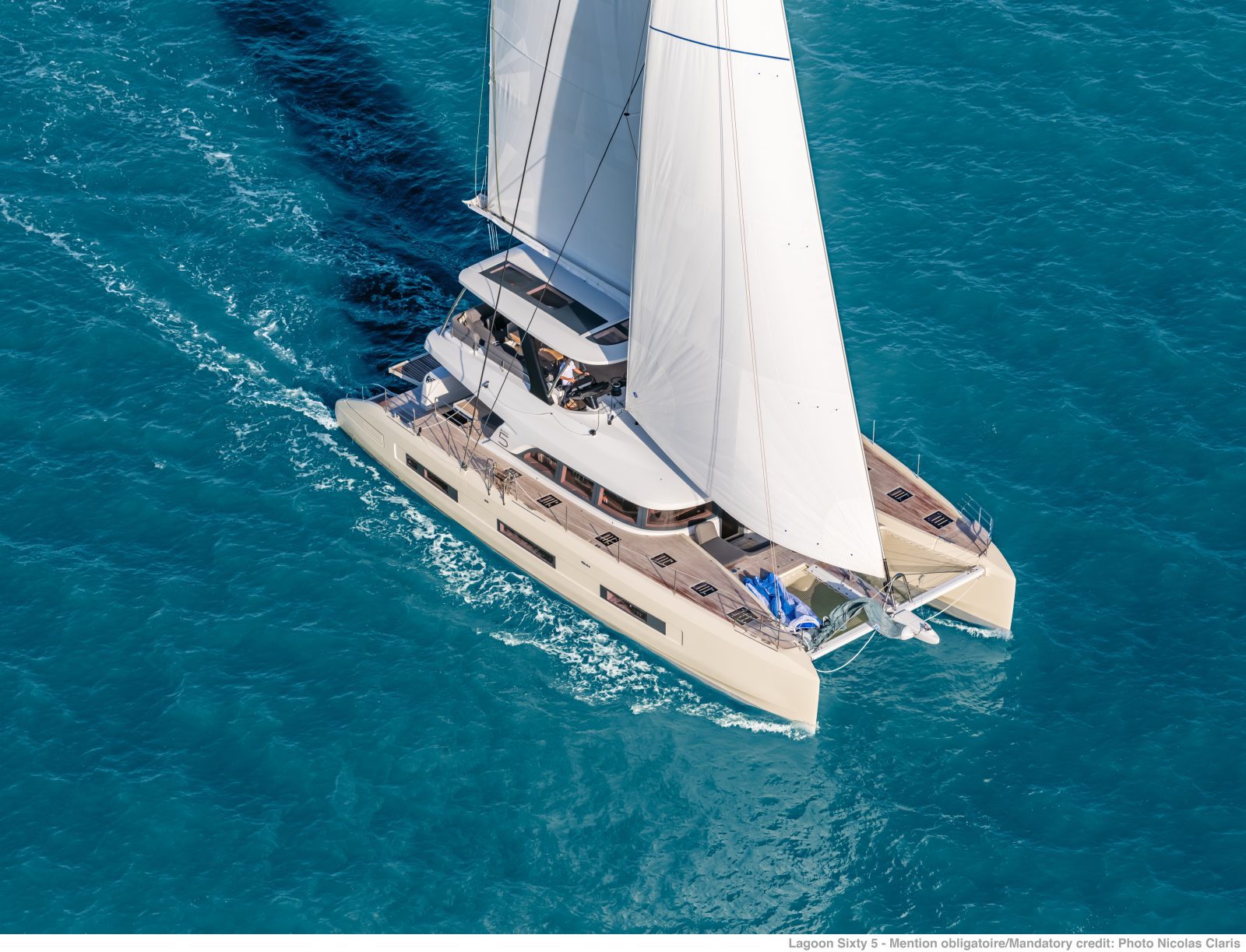
- Nautor Swan
- View Stock Boats
- Yachts for sale
- Sell your yacht
- Superyachts
- Yacht Management
- Our Services
- Pre Delivery
- After Sales
- Spare Parts
- Langkawi Yacht Registry
- Accessories
- Water Toys Digital Brochure
- 5 Top Yachting Pointers
- Boating Trends
- Broker Stories
- Buying a Yacht in Asia
- Cook Eat Repeat
- Experts Sharing
- Female Force Focus
- In The Spotlight
- Lagoon Cruising Stories
- Owner Stories
- Sell My Yacht In Asia
- Port Dickson
- Our History
- Private VIP Tour
- Our Partners
- Sustainability
- E: [email protected]
- T: +852 2555 8377

- After Sales Service
- Langkawi International Yacht Registry
- Yacht Services
- Beginners’ Guide
- Yachting Lifestyle
- Behind the Scenes
- Sell my Yacht in Asia & Beyond
- Exploring Asia

- Yachts for Sale
- Yachts Available Now
- Sell Your Yacht
- Digital Brochure

What Size Catamaran Can Sail Around The World?
Although it is possible to undertake a long voyage with almost any size catamaran, the recommended minimum sized catamaran to embark on an around-the-world voyage is around 30 feet in length which includes just enough space for a cabin and storage space for long-term provisions. A better option, reported as being the best-sized vessel for such a voyage, is 45-50 feet with widened hulls that afford the crew a better level of comfort with features such as multiple bathrooms, private cabins, and separate cooking and dining sections. Leaning towards the upper-sized catamarans for around-the-world voyages, the maximum size is 55-60 feet which offers significantly enhanced levels of comfort.
Can you sail a catamaran around the world?
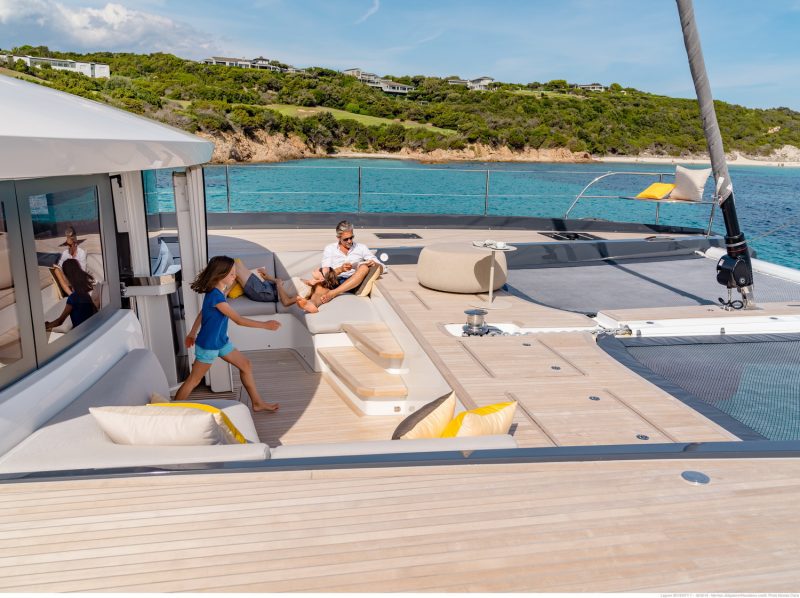
As touched upon above, the answer to the question “Can you sail a catamaran around the world” is yes you can but traveling in comfort can make all the difference and bigger is generally better. This is not to say that smaller vessels do not have what it takes to deliver a trouble-free voyage around the world, but levels of comfort must be considered for trips of a long duration.
Cataman features
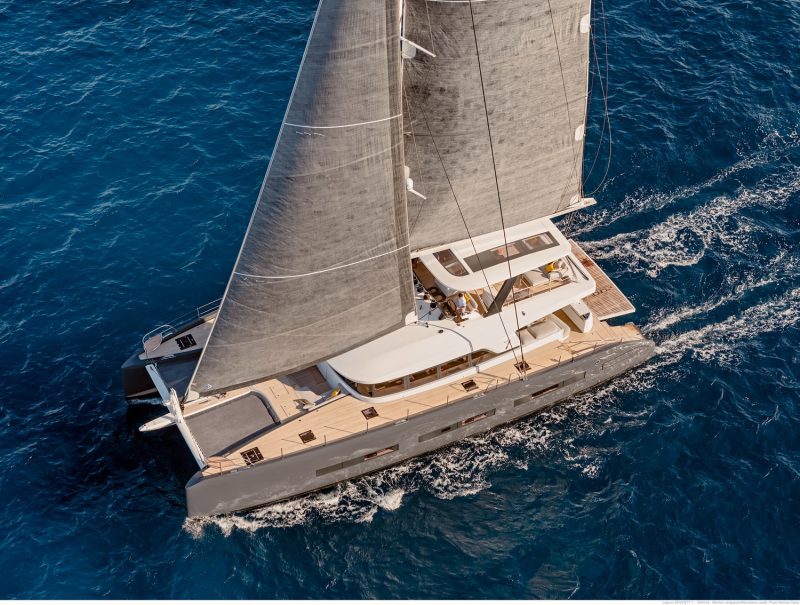
Freeboard : Cruising catamarans,the type best suited to world circumnavigation, have a high freeboard, which means that the decks are situated relatively high above the water which mitigates most of the risk of being washed over by large waves.
Cabin: Cruising Catamarans boast a large cabin space consisting of between 2-4 staterooms, a covered cockpit, and standing headroom throughout. This contrasts with smaller catamarans which may have a cockpit of some description and minimal accommodations but aren’t designed for long voyages.
Speed: Catamarans are, by cruising standards, very fast, with an average cruising catamaran reaching speeds of 20 knots and more in perfect conditions. The superior speed not only reduces the time spent travelling from A to B but also enables the Captain to avoid bad weather and also reduces the amount of provisions that need to be stored onboard as they can be replenished more regularly.
Comfort and Stability: Catamarans are well known for their stability and exceptional handling characteristics in comparison to traditional sailboats, this is particularly beneficial in rough weather.
Storage Space: Another great benefit of using a catamaran for a circumnavigation is the extra space in comparison to single-hull vessels of a similar size. The average cruising catamaran can accommodate at least 8 people and still leave plenty of space for storing food, emergency supplies, and personal items.
Safety: The extra stability of a catamaran contributes significantly to the safety of the vessel. The two hulls mean that catamarans are extremely difficult to capsize even in the roughest of weather conditions. In the rare event that the catamaran does capsize it will float just as effectively, making it a viable life raft in a worst-case scenario.
Larger Living Area: As a feature of their design, cruising catamarans boast a relatively large living area between the two hulls. This space usually contains a galley and a large sitting/dining area. For sailors on long voyages, this type of space can provide an area of relaxation and respite from crewing obligations at least for a while.
Shallow Draft: Due to their design, catamarans don’t need an extended keel and a benefit of this design is that they draw only minimal amounts of water making them perfect for shallow waters. Another benefit of the design is that they are easy to beach, making them the perfect solution for island hopping during the voyage.
Are there any cons to sailing a catamaran around the world?
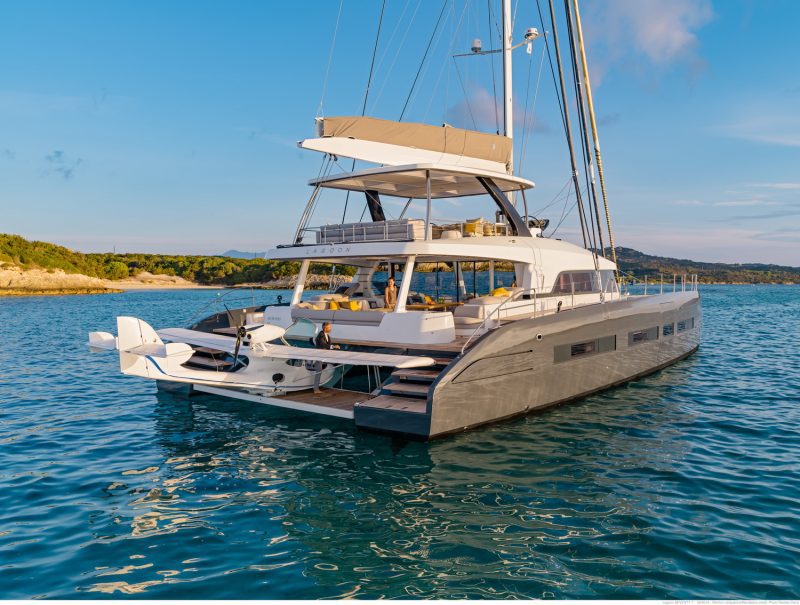
Although the positives of using a catamaran for a circumnavigation of the world far outweigh any negatives, it’s important to note some of the possible disadvantages of the vessel. These potential issues should, of course, be addressed at the planning stage.
- Size Limitations at Marinas: Although the size of a cruising catamaran presents zero issues when out on the open sea, some issues can occur when it comes to accessing marinas. Although boat design is firmly positioned in the 21 st century the same can’t be said about many marinas across the world which are not designed for doublewide boats. Prior planning and advice from the professionals at Simpson Marine can perhaps negate any potential docking headaches.
- Structural Deficiencies: Although extremely rare and virtually unheard of by reputable and established yacht brokers, the design of a catamaran can make it vulnerable in certain places, specifically where the hulls meet the frame. To reiterate, the vast majority of catamarans are well built using quality components and tested extensively before they are sold or chartered.
The Verdict – Are catamarans the best choice for a global circumnavigation?
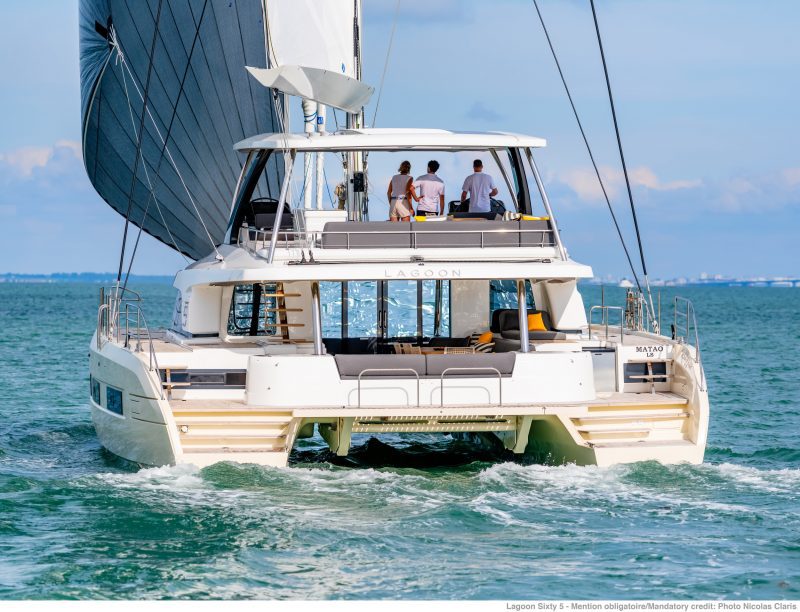
As you can see from the numerous advantages detailed above, a catamaran is the ideal choice of vessel for an around-the-world voyage. With key benefits including enhanced safety, comfort, speed, and stability there are few places you can’t go with a catamaran.
If you are a confident and experienced sailor there’s no reason why you can’t start making plans today. Ensure your planning is as thorough as possible and get acquainted with the destinations you will be visiting as well as local maritime regulations and entry requirements.
If you need help purchasing or chartering a catamaran don’t hesitate to get in touch with Simpson Marine , Asia’s leading new yacht sales , brokerage , and service company. We are partnered with the world’s leading yacht brands including Aquila Power Catamarans , Sanlorenzo , Fairline , and others, and offer new and preowned yachts and catamarans for all budgets and usage plans. In addition to sales, we also specialize in luxury yacht charters, yacht management, design, and refit. Our head office is in Hong Kong with regional offices in Thailand , Malaysia , Singapore , China , Indonesia , and Taiwan . Contact your local office or alternately refer to the contact information at the top of the page.
Enquire about this news
- Hidden Country
Similar News
28th December 2023
Exploring the Benefits of Joining a Yacht Club Before and After Buying
27th December 2023
Yacht Buying for Retirement: Things to Consider for a Leisurely Life at Sea
27th September 2023
Lagoon Unveils Details of New Model Lagoon 60 in Cannes
News, Events & Offers
NEWSLETTER SIGN-UP
How can we help.
© Simpson Marine Limited 2024. All rights reserved. Site by Alt
- Privacy & Cookie Policy
Newsletter Sign-up
- First name *
- Last Name *
- Location Please select a location... Afghanistan Albania Algeria American Samoa Andorra Angola Anguilla Antarctica Antigua and Barbuda Argentina Armenia Aruba Australia Austria Azerbaijan Bahamas Bahrain Bangladesh Barbados Belarus Belgium Belize Benin Bermuda Bhutan Bolivia Bonaire, Sint Eustatius and Saba Bosnia and Herzegovina Botswana Bouvet Island Brazil British Indian Ocean Territory Brunei Darussalam Bulgaria Burkina Faso Burundi Cambodia Cameroon Canada Cape Verde Cayman Islands Central African Republic Chad Chile China Christmas Island Cocos Islands Colombia Comoros Congo, Democratic Republic of the Congo, Republic of the Cook Islands Costa Rica Croatia Cuba Curaçao Cyprus Czech Republic Côte d'Ivoire Denmark Djibouti Dominica Dominican Republic Ecuador Egypt El Salvador Equatorial Guinea Eritrea Estonia Eswatini (Swaziland) Ethiopia Falkland Islands Faroe Islands Fiji Finland France French Guiana French Polynesia French Southern Territories Gabon Gambia Georgia Germany Ghana Gibraltar Greece Greenland Grenada Guadeloupe Guam Guatemala Guernsey Guinea Guinea-Bissau Guyana Haiti Heard and McDonald Islands Holy See Honduras Hong Kong Hungary Iceland India Indonesia Iran Iraq Ireland Isle of Man Israel Italy Jamaica Japan Jersey Jordan Kazakhstan Kenya Kiribati Kuwait Kyrgyzstan Lao People's Democratic Republic Latvia Lebanon Lesotho Liberia Libya Liechtenstein Lithuania Luxembourg Macau Macedonia Madagascar Malawi Malaysia Maldives Mali Malta Marshall Islands Martinique Mauritania Mauritius Mayotte Mexico Micronesia Moldova Monaco Mongolia Montenegro Montserrat Morocco Mozambique Myanmar Namibia Nauru Nepal Netherlands New Caledonia New Zealand Nicaragua Niger Nigeria Niue Norfolk Island North Korea Northern Mariana Islands Norway Oman Pakistan Palau Palestine, State of Panama Papua New Guinea Paraguay Peru Philippines Pitcairn Poland Portugal Puerto Rico Qatar Romania Russia Rwanda Réunion Saint Barthélemy Saint Helena Saint Kitts and Nevis Saint Lucia Saint Martin Saint Pierre and Miquelon Saint Vincent and the Grenadines Samoa San Marino Sao Tome and Principe Saudi Arabia Senegal Serbia Seychelles Sierra Leone Singapore Sint Maarten Slovakia Slovenia Solomon Islands Somalia South Africa South Georgia South Korea South Sudan Spain Sri Lanka Sudan Suriname Svalbard and Jan Mayen Islands Sweden Switzerland Syria Taiwan Tajikistan Tanzania Thailand Timor-Leste Togo Tokelau Tonga Trinidad and Tobago Tunisia Turkey Turkmenistan Turks and Caicos Islands Tuvalu US Minor Outlying Islands Uganda Ukraine United Arab Emirates United Kingdom United States Uruguay Uzbekistan Vanuatu Venezuela Vietnam Virgin Islands, British Virgin Islands, U.S. Wallis and Futuna Western Sahara Yemen Zambia Zimbabwe Åland Islands
Help us serve you better, please tell us more about your interests:
- Yacht Management & Service
- Choose your Brand -- select a Manufacturer -- Sanlorenzo Bluegame Fairline Nautor Swan Axopar Aquila Highfield Water Toys Seabob Lagoon Beneteau Sailboats Beneteau Motorboats CNB
- Phone This field is for validation purposes and should be left unchanged.
Keyword search
7 Best-Known Routes for Sailing Around the World (with Maps)
Route planning is among the most crucial bits of preparation, especially when it comes to circumnavigation. This article will give you seven of the most commonly used routes for sailing around the world. Some routes have been sailed many times by many people, others are obscure or even dangerous.
- The Fast Route - for the minimum time
- The Pleasure Route - for the maximal pleasure
- The Traditional Route - the road most taken
- The Arctic Route - for the rough ones
- The Dangerous Route - without regards for piracy
- The Cheap Route - with a budget in mind
- The Coast Lover's Route - never going far from the coast
Since circumnavigation is quite a complex matter, let's go through this list one by one below.
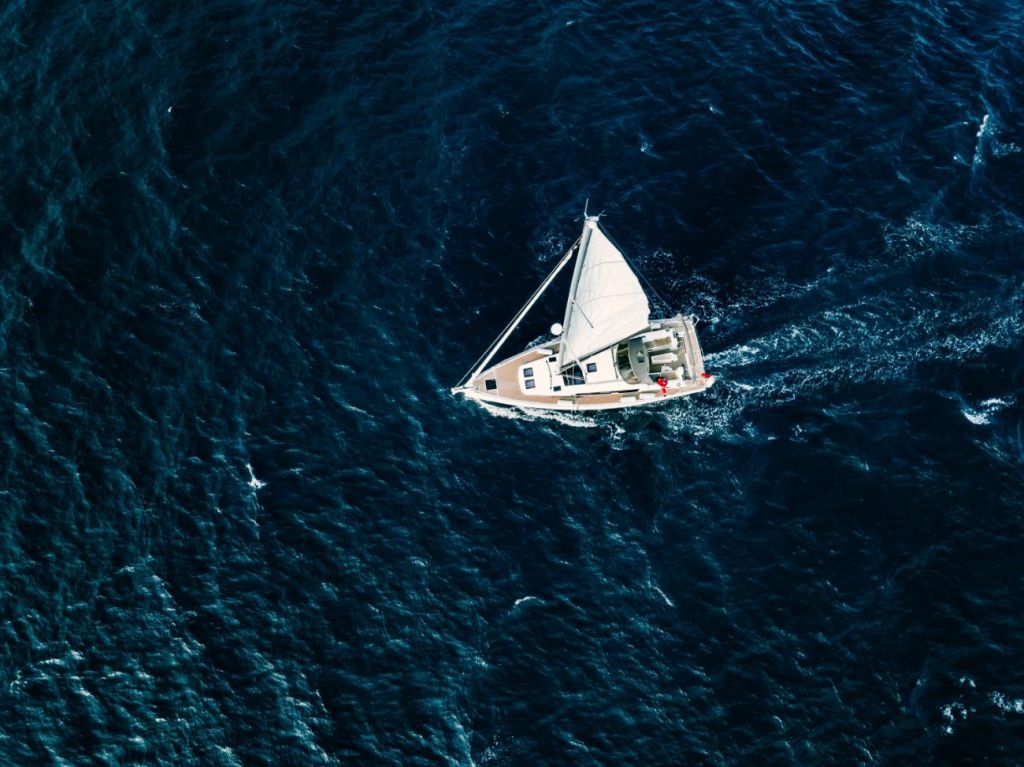
On this page:
How to choose a route for you, route for speed, the pleasure route, the traditional route, the arctic route, the dangerous route, the cheap route, the coast lover's route.
What route you will take depends on what kind of journey you are looking for. If the goal is to do it in the least amount of time possible, you will be choosing a different path than if you don't care about time and put emphasis on sightseeing.
Similarly, if safety and convenience are at the top of your priority list, you will choose a route that might differ greatly from that of a person ready to spend more on security and cut corners through tricky territories.
If you have specific locations in mind, you will take turns that are, logistically speaking, quite impractical, while if efficiency is what you want, there are certain places it would make little sense to visit.
And finally, if you are after comfort, you will avoid some bumpy places and times of the year, as opposed to somebody who won't mind venturing into the corners of the oceans that require a hell of a warm jacket.
There is no right or wrong answer here; don't feel some approaches are better than others. Just look at what you want from the journey, read through this article, and then choose what best suits you.
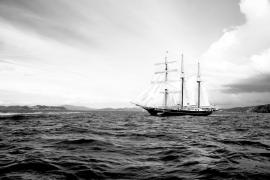
21 Places to Avoid Sailing Around the World (In Order)
Let's kick this off with a racing spirit. This is the route taken by those competing in Vendée Globe, a circumnavigation race. It takes a bit under three months...
...that is if you are a racer and so is your boat. If you are a cruiser kind of person, it will take more time, but the point is that this route is as straightforward as it gets.
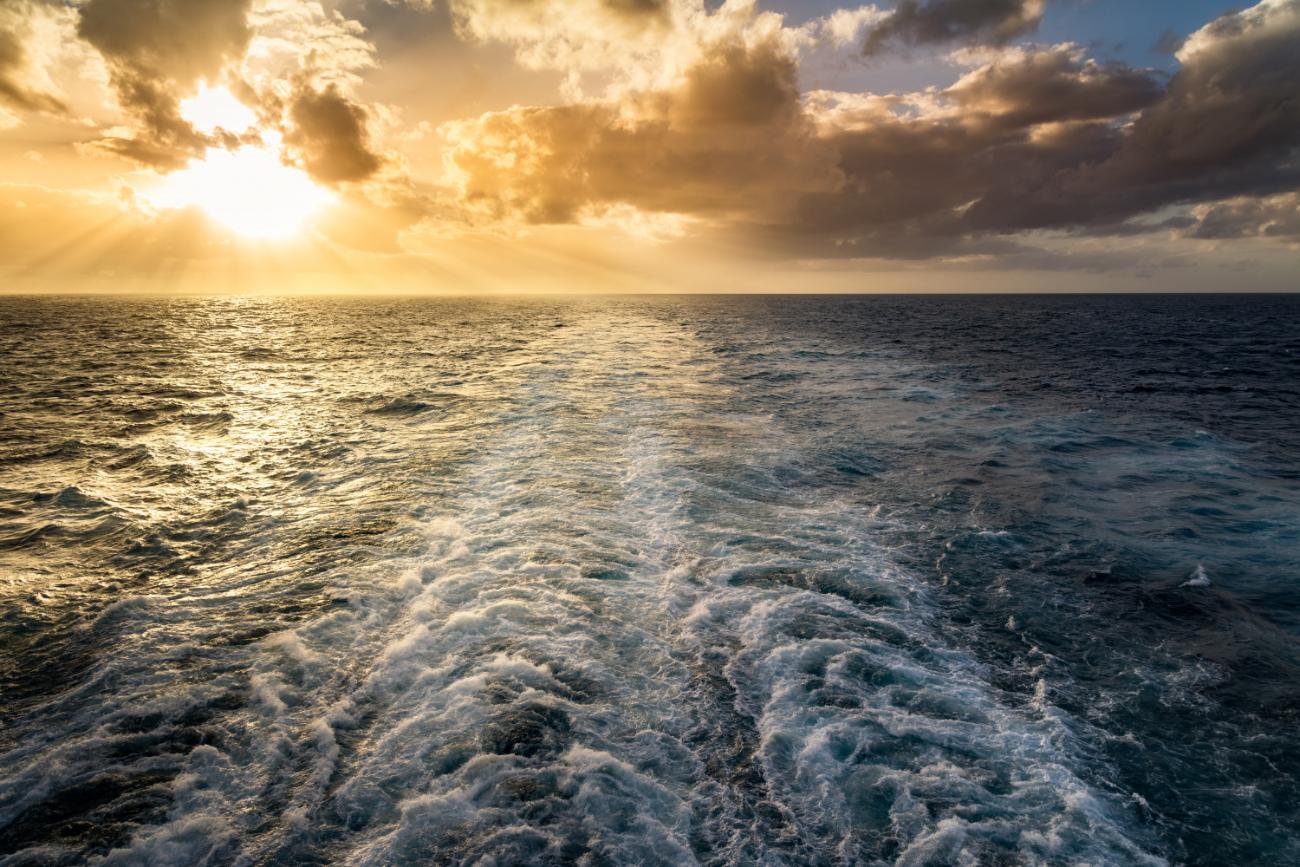
So what waypoints does it touch? Vendée globe racers start in France, then head down towards the Cape of Good Hope, circle Antarctica as close as the rules allow, and after getting to Cape Horn, head up to France again.
Of course, based on where you start from, your route might differ. But the idea is as follows:
- head south towards the Southern Ocean
- sail around Antarctica through the Southern Ocean
- after reaching the point where you met the Southern Ocean for the first time, head back up
The Southern Ocean is not a breeze, the cold waters mixing with the warmer ones coming from the north, plus the danger of icebergs, as well as the cold temperature, isn't how your typical holiday dream looks. That being said, it's up to you how close to Antarctica you will want to be when going around it.
This route doesn't touch down at any land, so you must be prepared for months on the sea as far as provisions, spares and mental capacity goes. Of course, this is variable, you can easily make landfall in Azores, South Africa, South Australia, or South America, and some of the South Pacific islands, if you need to. Either way, it is demanding logistically, so be sure to have your checklist in check .
It is among the most straightforward routes. Not just because it is probably the shortest one or the fastest one, but all the hassle with visas, check-ins, going through canals, and other lengthy land creatures' business will be foreign to you.
If you make it through the Southern Oceans unharmed, you will certainly have one hell of a story to tell.
Now let's go on the opposite side of the specter.
Let's suppose you theoretically have unlimited time. Instead of doing things quickly and efficiently, you want to take it at a leisurely pace while admiring all that there is to see.
This route will begin and end in the Mediterranean, but that's just because that's where I am based, sailing-wise. Wherever else you are, just pick the point of the route closest to you and begin there.
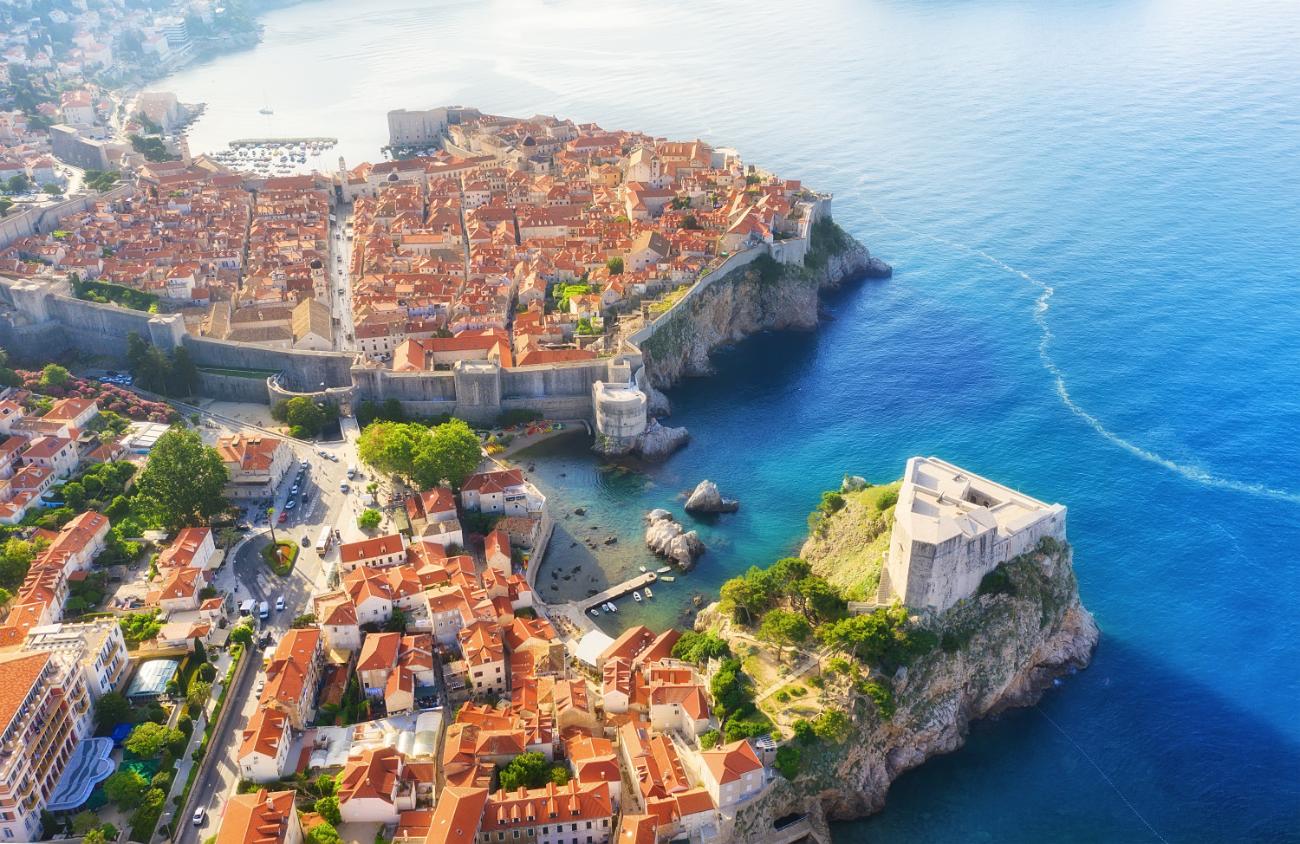
We will begin in Croatia, because it has beautiful shores and islands, travel around Greece with even more islands, the south around Italy, through Gibraltar. After that:
- head south to the Azores
- west to the Caribbean and through the Panama Canal
- west to Hawaii
- south to French Polynesia
- west to New Zealand, then Australia and Papua New Guinea
- northwest to Indonesia, Philippines, Vietnam, Thailand, India
- south to Madagascar, then along the African coast to Cape of Good Hope
- north to the Azores and then through Gibraltar back home
This route takes time since it aims to explore all it can even remotely touch. It's not just that the route is long, because the aim is to visit pretty places. You might also find yourself having to wait months at some places for the bad weather season to clear before you can make your next crossing. Have a look at our article about things to think about when planning for a long trip .
Because of that, this route is more demanding when it comes to planning, visa hassle, check-in research, more ports and anchors, more provisions planning. Also, your boat will need to be a solid liveaboard , since you will spend so much time on it. Logistically, it will be demanding.
But for all that hassle, you will literally get to see the world. You will visit many fantastic cultures, get to taste the cuisines from all over, and the long times waiting for the winds to calm down will be spent on exploring the place you are 'stuck' at.
What more does one need...
...except perhaps some middle ground. Now that we've been to two extremes, let's look at something in the middle: the route most commonly taken when circumnavigating.
It is rather similar to the Pleasure Route above except for skipping the Mediterranean, Pacific, and Southeast Asian stops.
Thus it goes as follows:
- From Europe, head south to the Azores
- west to Australia
- west to Cape of Good Hope
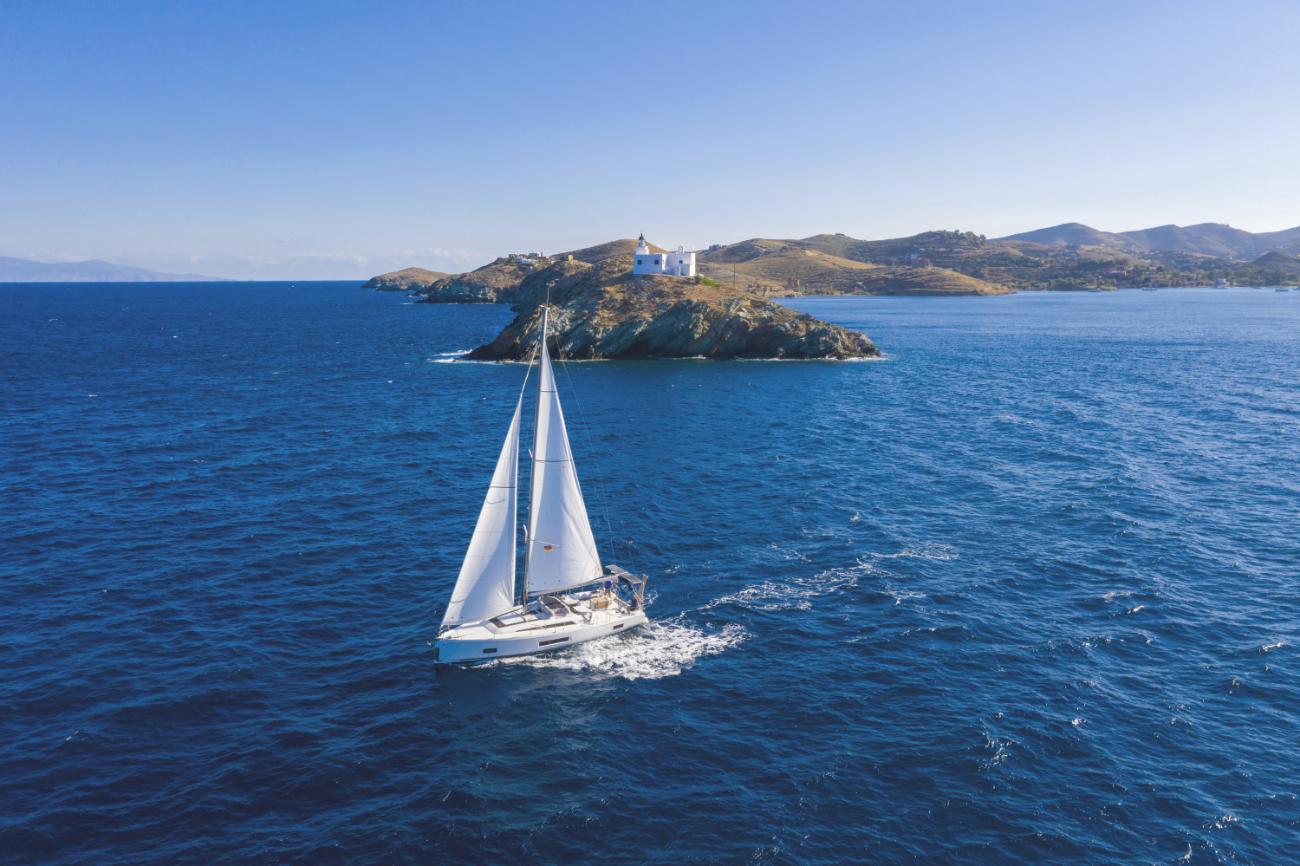
This route accomplishes the circumnavigation while stopping at beautiful places but doesn't necessarily explore everything that happens to be around. Its strong suit is the variability. If you like the Caribbean, you stop and cruise around there. If Australia excites you, you do the same there. If you want to see Madagascar, well, it will be almost on your way. And so on.
It has been a traditional route to take because it is relatively painless and does not go through any hazardous areas.
It has been traveled by many before you, so there is a lot of info floating around if you want to do your research on specific parts of the journey.
On its own, it has a lot of long legs where you will not see anything but the ocean on the horizon. So for those of you who mind this, you gotta make it your own, customize it a bit, so that you spend more time at places that you like.
This planning really is important. Some of those legs can't be made during certain seasons if you want to be careful, so to make sure you don't get stuck somewhere you don't particularly like, you should plan well.
With that, let's get crazier.
For those who want to do things the hard way. Perhaps you really like the scenery, perhaps you want to test yourself, or maybe you've done every other passage, and now it is time for the icy one.
There is a circumnavigation route that leads through regions so far up north you mostly don't encounter them even on a map. Because why would you look up there.
Now I don't know how long this article will survive on the internet, but note that this route is rather climatically contextual. Given enough time, it might freeze over and become unavailable.
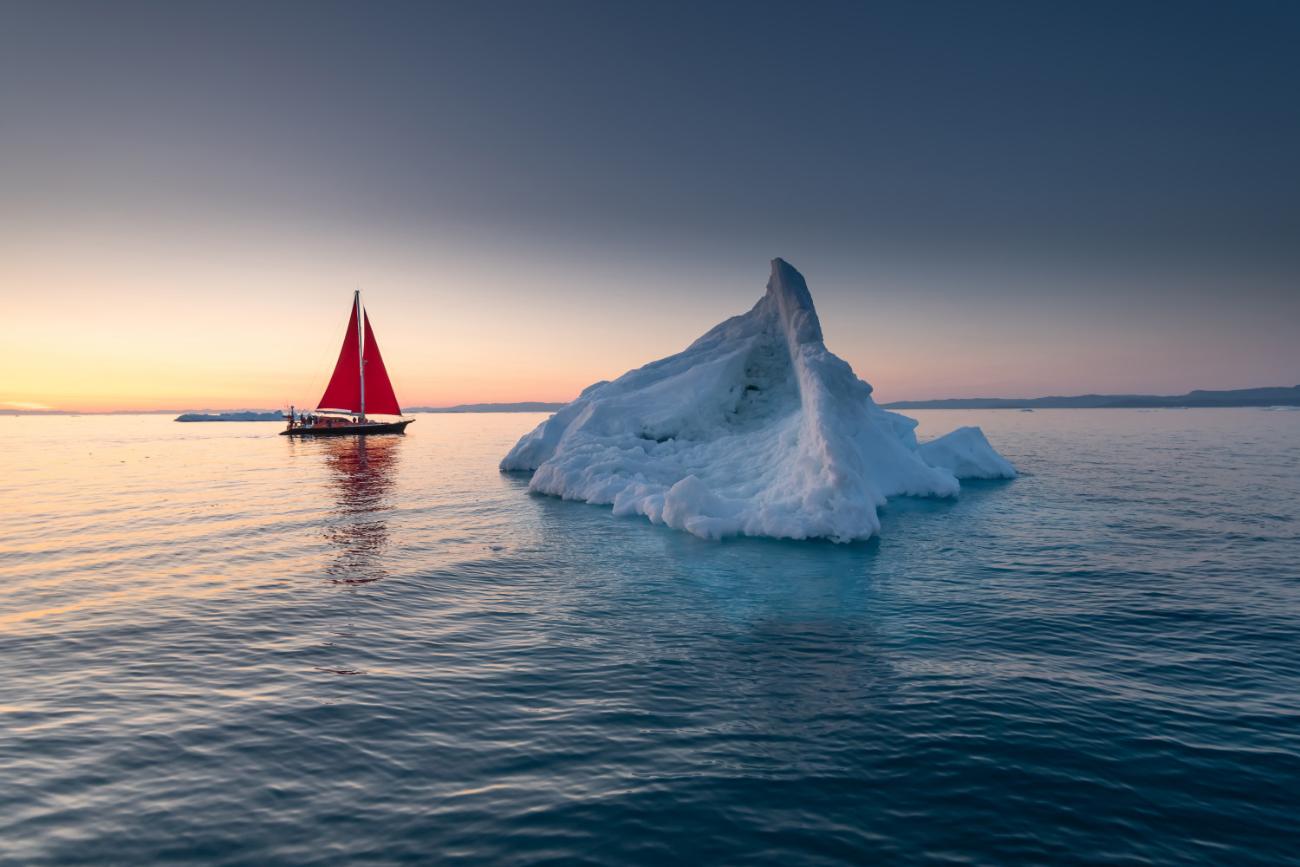
For me, it would begin in one of the northern ports of Norway and then:
- continue west to Iceland
- west to the south of Greenland and then up its western coast to the Baffin Bay
- south of Devon Island and through the archipelagos to Beaufort and Chuchki Seas
- west along the northern coast of Russia under the Lyakhovsky Islands
- west under the Yuzhny Island to the Barents Sea and back to the north of Norway
To this, you will have to add the most straightforward route north from wherever you are to any point on the route above.
Cold. Thus this requires clothing, equipment, and a boat that can withstand the polar temperatures along with chunks of ice floating around.
How much more adventurous can you get? Circumnavigation has been accomplished by plenty of people. This, not so much.
With the above, the major sailing routes have been covered. So what follows are mostly variations. Important ones, though.
Imagine this one mostly as the Traditional Route, except with a few twists. One of them leads through the Gulf of Aden, the Red Sea, and the Suez Canal.
Why take it? Because if you look on the map, you will see that when going from the general direction of Australia or Southeast Asia west, meaning you are probably aiming for the Azores or further for the Caribbean, it will save you a lot of time.
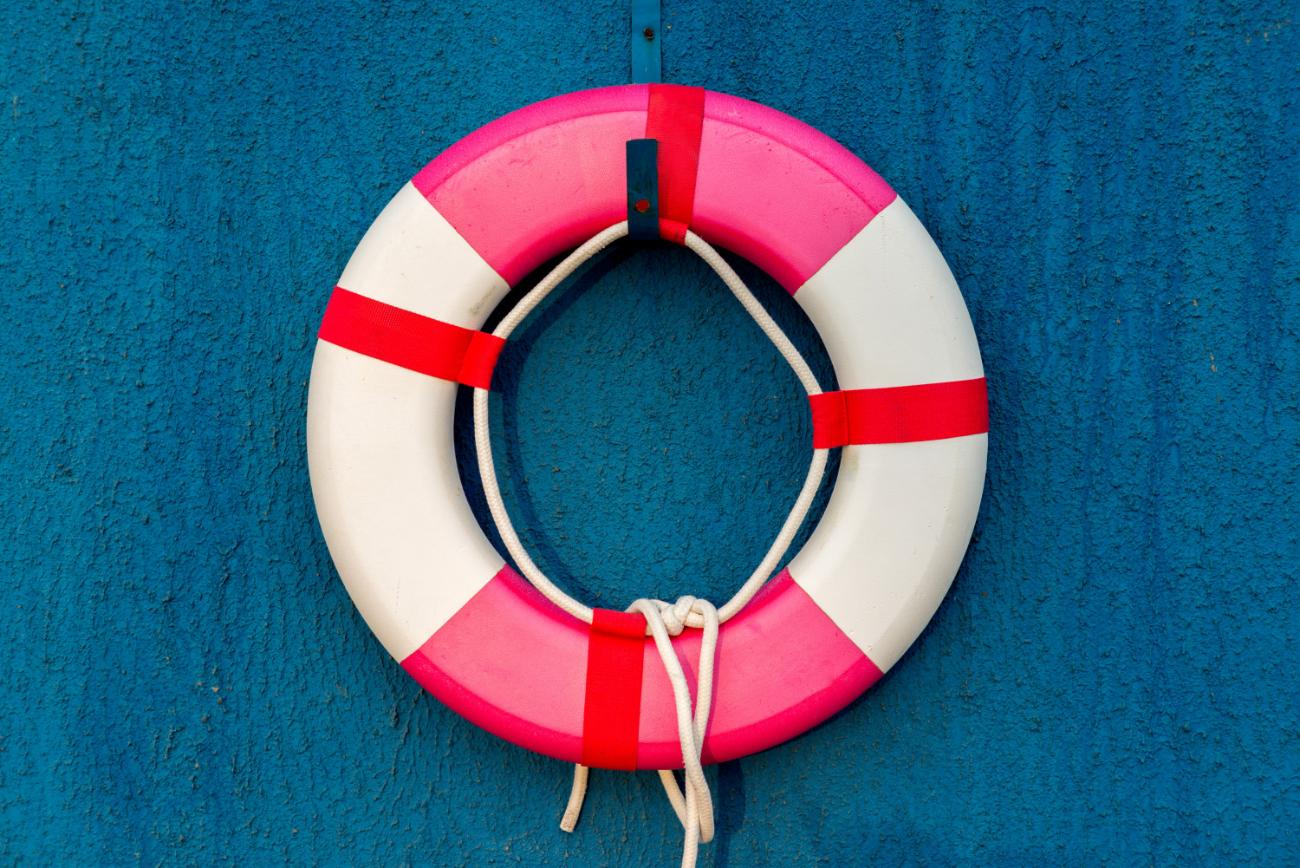
Money, not so much. You will have to pay for security. Because although you will save yourself the long southern route around the whole continent of Africa, which is nearly a 10,000-mile detour, you will have to go through the aforementioned areas that are famous for piracy and require professional armed company if you want to be on the safe side.
Not that it hasn't been done without it, but you know… Furthermore, many insurances won't cover you there since the risks are just too high.
Similarly, the area around Malaysia and the Philippines, which you might encounter during your Southeast Asia travels, bears the same story. No coverage by many insurances for piracy reasons.
Then again, exploring Southeast Asia while avoiding these regions means a few detours and no-go zones.
So if you want to explore the world on your sailboat and don't mind the risk, add these to your route plans.
Obviously, the risk or costs related to security. You will find plenty of sailors arguing that there is no real danger unless you are a cargo ship or a kidnapping worthy target. You will also find plenty who would rather travel in a fleet through there. And plenty who would never set sail towards those places.
Then there is the insurance issue.
With Suez, the upside is the saved time as well as not having to go around the treacherous South African cape waters.
With the Philippines and Malaysia, it's the convenience of being able to go wherever you want to in one of the most beautiful regions worldwide.
See this one as a variant of the Traditional Route and the Pleasure Route.
Some places are cheaper than others. And some places straight up make very little sense to go to.
Going through the Panama Canal is at least a $1,300 expense. Or, there are countries, like Ecuador, where check-in can cost you a $1,000 fee. And last but not least, prices of resources, like food, vary too. The Caribbean is famous for its steep prices in the provisions area.
The prices change, so it would not be bulletproof to give you a precise circumnavigation route exclusively through cheap places. Still, the moral of the story here is that when planning your route, do have a look at the local prices when it comes to check-ins and visas, food and various passes.
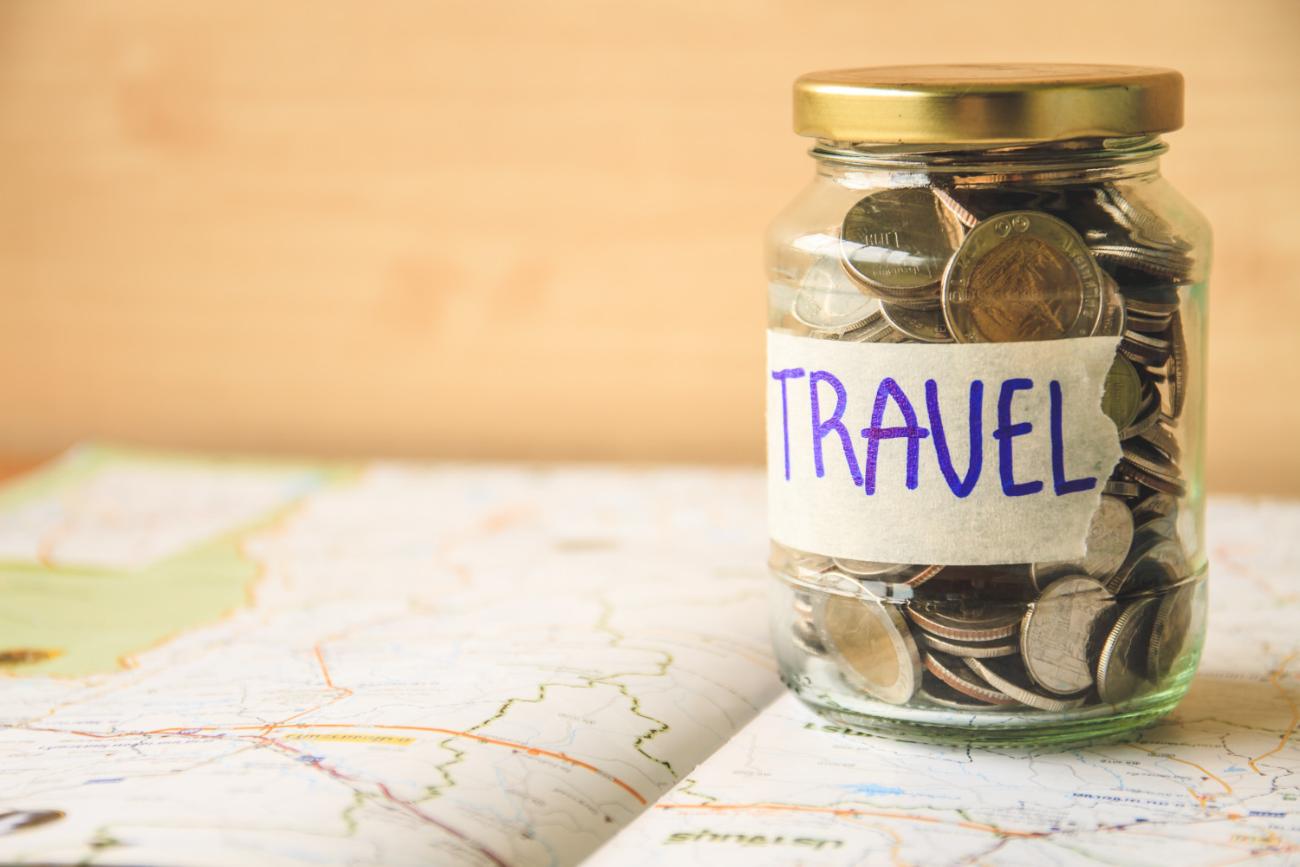
The result should be a route you are comfortable with financially. Avoiding the Panama Canal means a detour around the whole of South America, so it rarely pays off. Avoiding Ecuador, on the other hand, won't hinder your progress and save you money. Stocking up on food before getting into the Caribbean is also a sound logistical choice - unless you plan to stay for longer than your stocks can take you.
Saving money can mean detours, inaccessibility of various places, and more thought put into logistics. So it can result in a less elegant route.
On the other hand, being smart about it can result in a much lower bill overall.
Let me start this one by admitting that I don't believe anybody will actually take this route in its entirety, as delineated here. But it serves as an inspiration to those who are perhaps a bit unsure or simply like to combine two different sailing styles.
Some like to cross vast oceans and love to see nothing but the horizon for months. And then some like to stick to coastal waters for most of their journeys. Nothing wrong with that; at least it gives you something to look at any given moment.
And then there is the benefit of relative safety, a port or an anchorage close by most of the time, the ability to resupply whenever you like, to pick up and drop off people, and last but not least the lack of need for a really ocean-worthy boat and equipment.
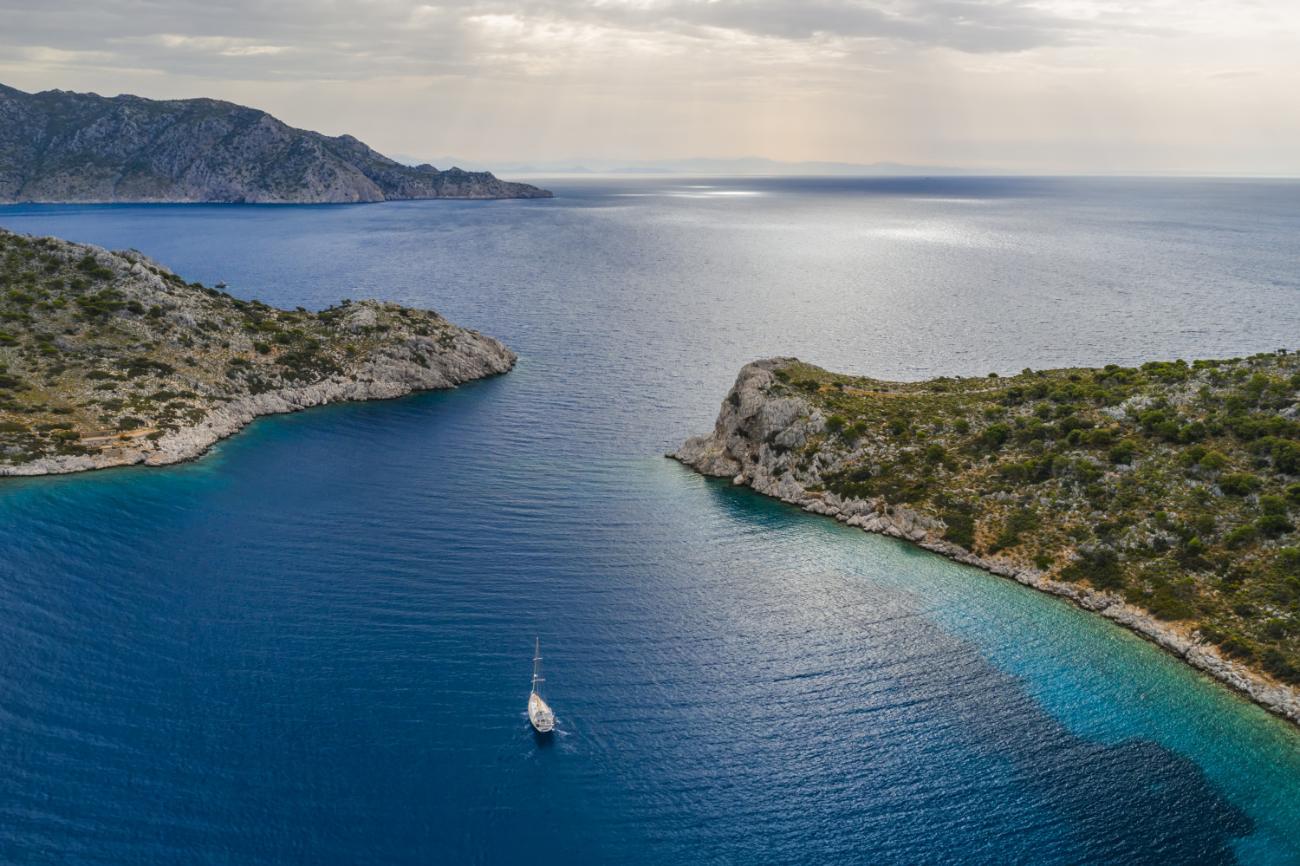
I'm talking about the coastal cruiser's dream of circling all the world's continents, whereby effectively circumnavigating the globe. Eventually. This is the longest route ever.
The idea is pretty simple. You can go around the world sticking to the coast with no crossings, except for the Norwegian Sea and a few short stretches in Southeast Asia.
Or, if you feel up to it (and want to avoid the freezing northern places), you can cross the Atlantic, the Pacific and keep close to the coasts otherwise.
As mentioned in the beginning, not many will actually take this entire route. But it is not uncommon for circumnavigators to have weeks or months where they do exactly this - stick to the coast and enjoy the country.
Lots and lots of time and resources are needed.
You will constantly be checking into countries and solving visas.
Understand the required paperwork for sailing the world This is an article on the topic of check-ins and paperwork, so have a read through it Read up on global licenses
Some areas are arguably less hospitable than others - the coast of Yemen as an example. So you might want to skip a few.
You don't need a proper ocean exploring boat - an island-hopping model will suffice. Many of the modern ones are capable of long crossings if needed here and there.
You don't need as much equipment as power, water, food, and all that jazz will be available most of the time.
The logistics will suddenly become a whole lot easier. Fewer provisions planning, less spare parts planning, broken stuff won't be a disaster… you get the point.
This is the true world tour.
I liked your article; it raised a lot of good points. I think the article could have benefitted from some maps.
I also think that, throughout the article, you have confused the Canary Islands or Madeira with the Azores. The Azores are not south from Gibraltor or France or Europe. They are 1/3 the way across the Atlantic Ocean, almost due west from Lisbon. The Canaries are south from Gilbrator, France and Europe and most people turn west there for the Caribbean.
Again, I liked the article.
Best wishes.
Leave a comment
You may also like, 41 sailboat cruising essentials for long trips.
In this post I list the items you are unlikely to have if you have never done bluewater or long-term cruising before. There are some essential safety product and …
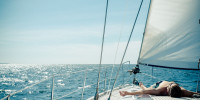
Everything You Need to Sail Around the World (by an expert)
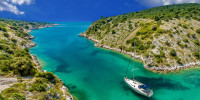
How Long Does it Take to Sail Around the World?
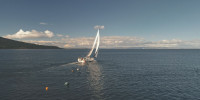
The Safest Sailing Routes Around the World (Which to Avoid)

How Big Should a Sailboat Be to Sail Around the World?
Own your first boat within a year on any budget.
A sailboat doesn't have to be expensive if you know what you're doing. If you want to learn how to make your sailing dream reality within a year, leave your email and I'll send you free updates . I don't like spam - I will only send helpful content.
Ready to Own Your First Boat?
Just tell us the best email address to send your tips to:

What Size Catamaran to Sail Around the World

Table of Contents
Anyone who knows you says this trip is already long overdue. The ocean is calling out to you and has been for a long time now. You’re more than ready to sail the seven seas. In fact, you’re virtually dying to do so. But first, you need to pick out a catamaran — moreover, one that is the correct size not merely for getting you around the world, but also for serving all your needs, wants, and goals on your trip.
You need to find the catamaran that will make all your trouble worth it. This seems simple enough, but as you begin your search, you quickly discover that there are so many (too many) options out there. Now you’re probably wondering, “Which size is right for me?” and “How do I figure this out?” In this article, we will break down how to choose what size catamaran to sail around the world with.
Some consider catamarans sized at 35 feet to 45 feet to be the best for ocean sailing. Many consider 45 feet to be the sweet spot when it comes to picking out a catamaran for trips around the world.
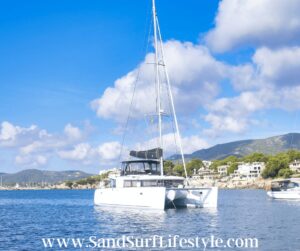
1) Basic comfort, speed, and circumnavigation of the vessel.
2) The amount of “cargo” you’ll have on the catamaran — in other words, the essential stuff needed in order to actually make your catamaran run, how many passengers will be on board, what it is you plan to do while on board, which items will be involved in making this happen, and how much space will be required for these activities.
3) Your budget in regards to catamaran size and, even more importantly, safety.
4) The actual measurements of the catamaran: 20 feet to 30 feet, 35 feet to 45 feet, and 50 feet to 60 feet being among the most popular sizes.
As we already stated before, the best catamaran size for a journey around the globe varies on a case-by-case basis. It depends entirely on your needs, wants, and intentions while out at sea. Nonetheless, the most important thing for everyone — new and seasoned sailors alike — to recognize while settling on a catamaran size is that it is never too early to consider anything and everything that might play a role on your trip. Every little thing matters, and the sooner you factor something in, the better you can plan for your voyage. This should also optimize the amount of fun you’ll have while on board.
Remember — it’s always better to be overprepared for the ocean than underprepared for it. Being underprepared while at sea can be the difference between life and death or, in less hazardous situations, the time of your life and utter, lasting misery.
The overall goal is generally to have a safe and successful experience while sailing your catamaran around the world. Of course, what counts as a successful trip will always vary from person to person, sailor to sailor, and passenger to passenger.
That’s why we went ahead and made you this little list — to make your intentions and, therefore, your catamaran size selection process — just a tiny bit easier. Ask yourself the following:
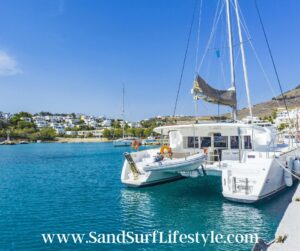
The ocean covered?
The places visited?
The company on board?
The memories made?
The knowledge gained?
The time spent on the water, and with the natural world?
The experience of actually steering a vessel through the sea, one of nature’s greatest miracles?
A combination of the above?
None of the above?
Think about it. Really take your time. Once you have a clear, honest idea of why you might want to sail a catamaran around the world, write it all down on a piece of paper. These notes will be your best friend while you read through this article and, eventually, decide on the appropriate vessel for your journey.
Initial Factors to Consider When Settling on a Catamaran Size
Primary items to consider when deciding on the size of your catamaran include basic comfort, speed, and circumnavigation.
For example, yes — the smaller, cheaper catamaran can carry a certain amount of people. But can it do so comfortably? Or will you and your passengers pay the price? We’ll get into this in more detail in just a moment. First, let’s talk about the speed of your catamaran. It’s all related — we promise.
When it comes to determining size, one must consider speed as well. Large, overloaded boats can move too slowly — but smaller ones can, too. This is where the shape of the boat comes into play. Boats with longer shapes and builds are absolutely your friends when selecting a catamaran — regardless of the size, you wind up going with. Not only are these better for speed, but they also come highly recommended by experts for circumnavigation and cargo purposes — the latter of which we will get into in more detail in the next section.
Regarding circumnavigation — what fun is sailing a catamaran if you can’t control it? Your ability to guide your catamaran should always be the top priority. Anything that seems to complicate or hinder this is something you should immediately rule out when deciding on a vessel.
How long does it take to learn how to sail? Find out here .
The relationship between catamaran size and essential “cargo”.
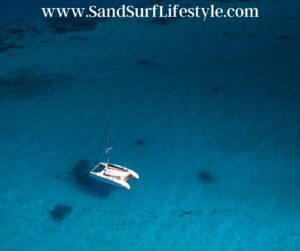
But there are other types of “cargo” as well. Necessary supplies, recreational items, the number of human beings, and how much space passengers will need while on board also matter — significantly.
For starters, ask yourself while you settle on a size for your catamaran whether you will have enough room for all the necessary supplies. Be honest with yourself. Longer, slower trips take more time and, therefore, require more of them. No matter what, you’ll need these items — food, water, first aid, medications, hygiene products, and other essential, rather heavy, and bulky supplies — while on board.
Additionally, if there are plans for fun and recreation while sailing — which, let’s be honest, there probably are — then you’ll need to ensure your vessel has the capacity for all of that as well. We’re talking furniture, sports stuff, audio equipment, and more. This aspect may seem like it should be an afterthought, but we promise you — it shouldn’t be. Be sure to keep it in mind while shopping around. What point is there to sailing around the world if you feel deprived, bored, or full of regret the entire time anyway? Make sure you have everything you’ll want and need before setting sail.
Furthermore, and as we already mentioned before, passenger “cargo” is also a thing. It’s vital that your catamaran have enough capacity for humans not only to survive but to travel comfortably.
Is this sail around the world all work with little to no play or human company? Then you won’t need as much room. The more likely scenario, however, is that you and the other people on board are looking to have fun — and therefore require adequate space to do so. This is a different type of “cargo,” but one that should be adequately considered throughout the selection process.
Similarly, imagine acquiring all the recreational items and loading them on board only to start sailing and discover that there isn’t even any room to use them all. Recreational, social, and even essential activities require the room in which to do them. Therefore, it’s important to have an idea ahead of time regarding what activities might be taking place on board. This will help you determine just how large of a vessel you need, as well as the shape of it.
What’s the point in sailing a catamaran around the world if you even can’t carry the things or people you need to make the trip worthwhile anyways?
Determining Catamaran Size in Relation to Your Budget
Of course, one of the most important considerations when deciding on a catamaran size is your budget. Larger catamarans with more features will cost more money upfront, yes. Nevertheless, the payoff regarding comfort, efficiency, practicality, and enjoyability while on board — as well as mandatory supplies you’ll need to carry on your travels and maintenance the vessel may eventually need — might make the investment worth it.
More importantly, safety is never worth skimping on, especially when it comes to sailing through the ocean over an extended period of time. If a smaller, simpler model is more affordable for you, just make sure it serves all your purposes, and that the lower price you’re paying is only in regards to the size of the catamaran. Paying less for a smaller vessel should not equal a higher risk factor while on board. Safety is key, and therefore, nonnegotiable.
The Best Catamaran Size(s) for Sailing Around the World
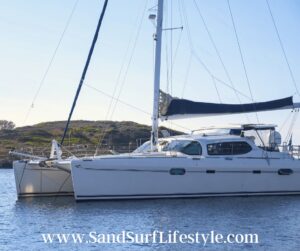
Some consider catamarans sized at 35 feet to 45 feet to be the best for ocean sailing. Many even consider 45 feet to be the sweet spot when it comes to picking out a catamaran for trips around the globe.
This isn’t to say that smaller vessels aren’t also an option. Catamarans sized at 25 feet to 30 feet are far more affordable — though, again, boats in this size range do tend to be more uncomfortable and less convenient. They also have less capacity. However, it is still possible to sail around the world in a catamaran sized within this 25 feet to 30 feet range.
Conversely, very large vessels are also doable. Catamarans in the 50 feet to 60 feet range absolutely do exist and are available for interested parties. However, they are extremely expensive. They are very much intended for those seeking total luxury while ocean sailing.
Again, a catamaran ranging between 35 feet and 45 feet should absolutely do the trick — for comfort, efficiency, space, and more importantly, function. These will get you around the world, and happily at that.
Either way, don’t forget that the size and price of your catamaran aren’t everything. Shape, safety, and circumnavigation are equally, if not more, important when it comes to ocean sailing.
Related Questions
What kind of recreational activities are popular while sailing? Depending on the length of the trip, people may want to do anything from eating fine cuisine to drinking and dancing, to sipping coffee and reading books, to even just tossing a basketball around. It just depends on the passengers on board.
Is a faster catamaran a better catamaran? Not necessarily. It just depends on how much time you want to spend at sea, and whether your trip is more about efficiency or luxury, and land time or water time. Just keep in mind that more time at sea means you’ll need more supplies and, therefore, more capacity for storing them.
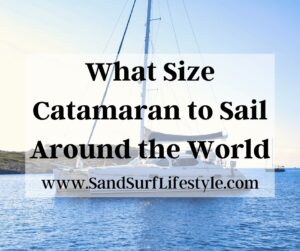
Please note: This blog post is for educational purposes only and does not constitute legal or medical advice. Please consult a legal expert or medical professional to address your specific needs.
Aloha! My name is Shawn and I Love the Beach and Ocean! From surfing to beach sports to boating and fishing I like it all. More importantly, I Love the people I get to meet who also share a passion for the sand and surf. Living and growing up near the ocean my heart has always been connected to the beach and its lifestyle. I wish to share my experience with those around the world. Mahalo (Thank You) for visiting and enjoy your stay here on my site!
Recent Posts
Most Useful Surfboard Bags for Travel
As an Amazon Associate, I earn from qualifying purchases.As a passionate surfer, there's nothing more exciting for me than going on a new trip to find the perfect wave in faraway places. However,...
Best Surfing Cameras for Capturing Epic Rides
As an Amazon Associate, I earn from qualifying purchases.It's my love, my escape, and my way of life. And getting pictures of those epic times is just as important to me as riding the waves. So,...
- Motorcycles
- Car of the Month
- Destinations
- Men’s Fashion
- Watch Collector
- Art & Collectibles
- Vacation Homes
- Celebrity Homes
- New Construction
- Home Design
- Electronics
- Fine Dining
- Les Marquables de Martell
- Mira Villas
- Panther National
- Reynolds Lake Oconee
- Wynn Las Vegas
- 672 Wine Club
- Sports & Leisure
- Health & Wellness
- Best of the Best
- The Ultimate Gift Guide
- This New 131-Foot Superyacht Concept Brings High Architecture to the High Seas
Miminat debut yacht design is by no means short on style.
Rachel cormack.
Digital Editor
Rachel Cormack's Most Recent Stories
Isa unveils a trio of sleek new superyachts, wider yachts is debuting a 92-foot hybrid catamaran at the venice boat show—here’s a first look.
- Share This Article

Miminat is diving into the marine industry.
Related Stories
- A Maine Cybertruck Owner Had No Idea Some People Would Hate His Truck So Much
- Tesla’s Cybertruck Inspired This New Solar-Powered Trailer
- Custom Line Just Unveiled a New 127-Foot Superyacht in Venice--and We Got a First Look

Having worked on a myriad of residential and hospitality projects over the past few years, Miminat is adept at creating elegant interiors with contemporary decor, sculptural furniture, and statement lighting. K features all of the above and a sleek, stylish exterior. In contrast to the Japanese design influence, the vessel will reportedly display the finest Italian craftsmanship. As the studio puts it, K is “not only a vessel for art, but a masterpiece in and of itself.”
With an interior volume of approximately 300 GT, K offers a spacious interior with five cabins. The owner’s suite is positioned on the main deck, while a VIP and three doubles sit on the lower deck. The crew quarters are also located on the lower deck. Back on the main deck lies a salon with a Japanese-inspired lounge, a bar, and a dining area with a 10-seater table. A spiral staircase leads to a spacious upper deck with a helm and alfresco dining area.
K also offers luxurious hangouts forward and aft. The two-level aft deck centers around a singular infinity pool that waterfalls from one level to the next, while the bow is equipped with a plush lounge and firepit.
Miminat says “various engine options” will give K a maximum speed of 25 knots and a cruising speed of 16 knots. It is hard to imagine the yacht will be overly practical in tumultuous waters—especially given her scant hardtop, hull cutouts, and exposed aft deck—but, hey, at least she’ll look pretty.
Click here to see all the photos of K.

Rachel Cormack is a digital editor at Robb Report. She cut her teeth writing for HuffPost, Concrete Playground, and several other online publications in Australia, before moving to New York at the…
Read More On:
More marine.

Killer Whales Sunk a 50-Foot Sailing Yacht in the Strait of Gibraltar

This New 394-Foot Custom Superyacht Will Be the Largest Amels Yet

Culinary Masters 2024
MAY 17 - 19 Join us for extraordinary meals from the nation’s brightest culinary minds.
Give the Gift of Luxury
Latest Galleries in Marine
K superyacht in photos.

Meet ‘Home,’ the Sleek 164-Foot Superyacht That Starred in ‘Below Deck’
More from our brands, people, profit and planet: crystal international group shares net zero vision 2050, pbr goes live with cbs sports, dr. phil’s merit street media, ‘scénarios’ review: cannes premieres a short completed by jean-luc godard the day before his death, and also a film about the making of it, christie’s website still down hours before evening sales, causing concerns, the best yoga mats for any practice, according to instructors.

Sports | ‘Over-the-top’ Worrell 1000 catamaran race…
Share this:.
- Click to share on Facebook (Opens in new window)
- Click to share on X (Opens in new window)
e-Pilot Evening Edition
- Virginia Tech
- Other Colleges
- Sports columnists
Sports | ‘Over-the-top’ Worrell 1000 catamaran race starts Sunday in Florida, set to finish in Virginia Beach

The Worrell 1000 is an offshore long-distance catamaran sailboat race that starts on the shores of Hollywood, Florida, at 10 a.m. Sunday. Sailors will log countless hours over 12 legs that span more than 1,000 miles over the water up the East Coast until the finish line. Racing is scheduled to conclude on the afternoon of May 24 in Virginia Beach.
“It was an East Coast race to begin with,” said Randy Smyth, at the helm of Virginia Beach’s Team Rudee’s boat for the second consecutive race. He has competed in eight previous Worrell 1000s, winning six.
“It kept getting so much press coverage locally — each little town would cover it. Then, a lot of the sailing magazines would cover it. So no matter where you were in the world you lived, you could read about it. It was a story about an event you didn’t have to race in to understand that it’s an over-the-top kind of race. It’s built up that reputation. For anybody that races a beach catamaran and wants a full adventure, this is it.”
Rich history
Over the years, the race has had a tumultuous history. It started as a bet between bar owners and brothers Michael and Chris Worrell, transformed from its original continuous format to daily checkpoint races, and then went into hiatus for 17 years starting in 2002.
This year’s event will be the third time it’s been run in its current format by the Worrell 1000 Reunion Race organizing authority, a 501c3 non-profit, having just three boats compete when it was resurrected in 2019.
“We thought we were going to have five boats, but we only ended up with only three,” said Beverly Simmons, the Worrell 1000 communications director. “It didn’t matter. We had to prove to the world that it could be done.”
That race brought teams from Australia, Florida and Texas, and it again caught the world’s attention. It was scheduled to be held again in 2021, but was postponed for a year due to the COVID-19 pandemic. In 2022, 13 teams from six countries competed. Twelve teams finished, and the last was dismasted on the final leg.
This year will be the 23rd running of the race during its 50 years of existence. Twelve teams are again vying for bragging rights with competitors from all over the world, including Australia, France, Germany, the Netherlands and the United States. Smyth and teammate Dalton Tebo will be the crew representing the aforementioned local entry, Team Rudee’s, which finished second in 2022. There is also an entry from North Carolina, Team Outer Banks, comprised of Hardy Peters and James Eaton.
Aside from respect, the teams are also seeking the Ron Anthony Memorial Perpetual Trophy for course record, which is held by Jamie Livingston and Brian Lambert of Team Alexander’s on the Bay, set in 2002 with a time of 71 hours, 32 minutes and 55 seconds.
‘The clock’s always ticking’
Smyth explained that the Worrell 1000 is not a regatta in the sense where there are multiple races and a team’s score is based on its placement in those races, so a couple of bad finishes won’t be the end-all. It’s a race based on cumulative time.
A team can win 11 of the 12 legs, but if it doesn’t finish a single leg, then that team won’t have completed the entire race. Or if a team wins a number of early legs and then goes six hours behind on a subsequent leg because of going the wrong direction, that can have a huge adverse effect on its total time. It’s much like how the Tour de France is run, which both Simmons and principal race officer John Williams offered as a comparison.
“Every minute counts because the clock’s always ticking,” Smyth said. “You never know how much time you’ll need at the finish to do well, so that puts pressure on all the teams to always be racing. There’s never a moment when you’re up two minutes on a competitor and thinking I’m going to beat him. No, you’re thinking I need to make this three minutes because every minute counts.”
Smyth, who is also a National Sailing Hall of Fame inductee and an America’s Cup participant and winner aboard Stars & Stripes in 1988, said all the beach catamarans in the race are in the Formula 18s class. A catamaran is a multihull design boat with two pontoons at the waterline with a trampoline for a deck. The Formula 18s distinction signifies that the boats have all the same parameters — same length (18 feet), same sail area and same weight, which also factors in the weight of the two crew members, food and water and safety equipment.
But various manufacturers can build boats with different designs that look and perform differently, which makes for a class that evolves — similar to how auto racing works. With the boats all having similar performance expectations, it’s the skill of the crew and weather and nature conditions that determine the race results.
‘We know there are going to be stories’
“Every day is so different,” Smyth said. “Florida is a wide beach, so you just go straight to the finish line. Once you get past that, the Georgia coast where there’s a whole bunch of islands or Cape Lookout, Cape Fear and Cape Hatteras, there’s a lot more navigation involved. And some of the longer legs end up being night legs if it isn’t that windy the day of. A lot of the testing for the teams quite often is when you get further up the course closer to the finish line.”

Smyth said each leg averages about 70 miles — a substantially long race for a beach catamaran.
“What really takes you out on the Worrell 1000 is the fact that it’s not a one-day race. Each day is cumulative body damage,” Smyth explained. “Day 2, you’re a little more tired, and then Day 3 and so on. So when you’re dealing with the surf and the shoals around Cape Fear and further when our bodies are tired, that is the test the Worrell 1000 gives you — each day is a little more difficult as you get closer to the finish.”
Things like submarines and marine life can also be unexpected obstacles. Smyth recalled one year a shark hitting the daggerboard (underwater fin that keeps either of the pontoons stable) of a boat he was on and creating a hole in the hull, so the boat started to sink.
Navigating through rough surf on starts and finishes, where boats can break rudders and even tip over, represents even more perils on the water. In 23 tries, every team reaching the finish line has happened just four times.
“We don’t know what the stories are going to be, but we know there are going to be stories,” Smyth said. “You don’t know until you get there that day whether the shoals or sandbars have moved and how you’ll get through them. There’s all kinds of treachery and ways that things can go wrong out there — you can’t put a location in your GPS and get all the answers.”
And although it’s a competition, there’s still a strong sense of community and camaraderie among all the teams. Most of the teams are friends outside of racing. Simmons said the race committee and organizing authority won’t let teams compete if they don’t personally know them or if their credentials to race can’t be vetted by the tight sailing community.
“In 2022, Team Great Britain had a collision at the start and they went over. Every single batten in their main sail was broken,” Simmons said. “They limped to shore. Every single crewman from all the teams magically appeared with tools, sail tape and new battens. And within 15 minutes, they were back out on the course. That’s the spirit of this race.”
And it’s that idea — the spirit of the closeness of the competitors — that keeps the fire burning that is the Worrell 1000 race.
“There were some events that tried to emulate what had been done in the past, but they weren’t coming to Virginia Beach. None of them stuck. It’s just not the same,” Williams said. “There’s a recognition worldwide that this is a one-of-a-kind event. There’s nothing else like it.
“It’s this 1,000 miles that crosses the beautiful beaches of Florida, the graveyard of the Atlantic and the Outer Banks and finishes in the idyllic setting of Virginia Beach. That’s why we get so much international attention and participation.”
More in Sports

Sports | Prestigious U.S. Mid-Amateur Championship will finally bring Evan Beck closer to home for major event

Former Boise State offensive lineman commits to Old Dominion

SUBSCRIBER ONLY
Sports | tides’ coby mayo hits injured list; connor norby returns.

Brunswick Academy overcomes Greenbrier Christian in VISAA Division III softball final
Trending nationally.
- Cambridge couple stranded in Brazil with premature newborn say they are stuck in ‘bureaucratic morass’
- Scottie Scheffler arrested at PGA Championship for traffic violation, returns to course hours later
- Ben Affleck spotted staying at separate home amid Jennifer Lopez split rumors
- ABC’s ‘Golden Bachelorette’ is 61-year-old Maryland grandmother
- Preakness 2024: From Mystik Dan to Uncle Heavy, get to know the eight horses in the field
Yachting World
- Digital Edition

The 10 modern and updated golden rules for line handling
- Rachael Sprot
- May 16, 2024
Yachtmaster Instructor and co-founder of Rubicon 3 Adventures, Rachel Sprot takes a look at line handling and brings you her top 10 modern rules

They say that most accidents happen in the home, and I’d hazard a guess that the same is true for sailing. Of the accidents I’ve witnessed over the years, a significant proportion have been in port, often while mooring. It’s a time when the crew are starting to relax, the seasickness has vanished and the bar’s in sight. Meanwhile, the skipper is focused on the manoeuvre.
We often underappreciate the hazards involved in mooring. As the size of yacht increases, particularly above 45ft, it’s essential to upskill our line handling, and that of our crew. Last issue we looked at line handling techniques while under sail, this issue we’ll look at coming alongside, berthing, and other critical moments. The good news is that safe line handling isn’t complicated: with a healthy respect for the hazards involved and a few golden rules, it should be easy to make the transition to larger vessels safely.
It may sound counterintuitive, but if you’ve got novice crew on board it’s essential to teach them how to tie up while you’re still tied up. Taking time to demonstrate where to stand, how to lasso a cleat, and how to make off a line or surge it, is one of the best investments you can make.
Once you’ve done this, find a big, empty berth and come alongside a couple of times to ensure that everyone understands the procedure, it will pay dividends in the end.

With higher topsides, stepping off becomes harder – particularly on icy or slippery pontoons. Photo: Rachael Sprot
2 Surging a line
Using the warps, such as a midships line, is an effective way to bring a large boat alongside, but it needs both sensitive use of the throttle and sensitive line handling. The person stepping ashore needs to know how to surge the line, rather than snubbing it, and the person on the helm needs to work with them. In strong winds this can be the difference between coming safely alongside, or causing damage.
3 Heaving lines
As the lines get bigger and heavier, and the topsides get higher, stepping ashore with warps becomes harder.
Throwing a heavy line is difficult: if you get enough momentum to launch the line, you risk sending yourself with it. I’ve come close to this myself and seen it happen to another skipper (it did wonders for crew morale, though little for his own!). Throwing a few loops of the line, and not the whole coil, is the trick for short distances, but it will only cover a few metres.
“If there’s one essential skill the crew of large yachts need,” notes large classic yacht skipper, Jim Thom, “it’s using the heaving line.”

Coiling long warps and lines is heavy work. Photo: Rachael Sprot
While most medium-sized cruising yachts won’t carry a dedicated heaving line, they often have a throwing line in a bag, which will do the same job.
Practising on the dock first saves embarrassment under pressure and could be the difference between pulling off a manoeuvre first time, or having to come around again.
If you’re receiving a heaving line, holding out an arm on the side you want it thrown will help direct the line in the right direction, but away from your face.
<h2<4 Lassoing
If you’re not met by the marina staff, your crew need to be able to secure a line to the dock themselves.
Topside height has increased considerably in recent years, and where we might once have expected a crewmember to be able to step off a 50-footer, it’s increasingly unrealistic. Nigel Rennie has witnessed several accidents over his decades as an RYA examiner. Three Yachtmaster candidates left exams in an ambulance having slipped on pontoons and suffered serious injuries, and several more missed the pontoon entirely and ended up in the water.
“When I’m teaching a course these days,” he said, “I always teach lassoing.” To lasso a cleat, throw a bight of line wide enough to ensure that it encircles the cleat, and then bring in the slack.

Use your hip when coiling lines to help support the weight. Photo: Rachael Sprot
5 Coiling lines
Line coiling is an art. A well-coiled line isn’t just nice to look at though, it’s also a safety issue. There are times when you need to rig lines in a hurry, such as having engine failure in a confined space or needing a tow. Lines need to come out of the locker ready to use, not tangled among the buckets and fenders.
Coiling big, heavy lines is hard work though, and the larger the yacht, the longer it takes. Skippers can encourage good habits by allowing time to stow the boat properly before heading out of port. Using a winch, rather than your arm, to coil the line around makes it easier, or flaking it into a figure of eight on deck. To finish it off without finishing off your biceps, hold the body of the coil between the crook of your arm and your hip, while you wrap the tail around it.

Unambiguous communication between the bow and the helm is vital for safe line handling. Photo: Paul Wyeth
6 Communication
Effective communication is particularly important on a large yacht where the controls are a long way from where the load is applied. Agree terms in advance and explain what you mean by each phrase. Danny Watson, skipper of Challenge 72, Catzero, insists that crew repeat back the instruction: “Slip the bow line,” should be answered with “Slipping the bow line,” and then “Bowline slipped.” The bow is too far away from the helm to see what’s going on, and the foredeck team are the skipper’s eyes forward.
Article continues below…

An expert guide to safe line handling at sea
Boats may have nine lives, but a sailor is not supposed to have nine fingers. Every year, however, we hear…

A complete guide to high latitude sailing (and avoiding icebergs)
I’ve just returned home from skippering 59º North’s Farr 65 Falken from Annapolis, Maryland, to Isafjordur in north-west Iceland. We…
Loading or unloading a line at the wrong time can be dangerous. A line should never be loaded without ensuring the people handling it are ready. If you’re going to drive onto a midships spring, explain this in advance and make a final check that hands are clear before engaging gear.
The language we use matters too. Sail training skipper Emily Caruso pointed out that “Make it off” sounds very similar to “take it off”. Unfortunately, it has completely the opposite effect to the one you want when you’re trying to secure a boat in a cross wind!
“Taking time to get the right lines in place can prevent a lot of rushing and mis-handling,” said Helen Walker, skipper of expedition yacht, Zuza, “then all the safety aspects can be adhered to without extra pressure and confusion.” With planning and preparation novice crew can be safely involved in deck operations, without it they’re more likely to be sidelined or injured.

Taking time to get the right lines in place can prevent a lot of unnecessary rushing when the time comes to deploy them. Photo: Paul Wyeth
8 Loose Ends
“Always ensure you can dump the line from on board if needed,” said John Wetton, Yachtmaster Instructor, “don’t put bowlines on cleats on board.” Having the loose end of the line on the dock means you’ve ceded control to those on shore who may, or may not, have understood instructions. If you’ve still got line on board you’ve still got options, such as easing, or releasing the line. There are times when you need to abort a manoeuvre or abandon a snagged line and depart the dock without it.
There is a story – possibly apocryphal – of a sailing school that almost lost a yacht when a line snagged. They were springing off a flimsy finger berth in a French marina, but when the line caught they were already making way. The rope was secured by a locking hitch with no way to release it. As the line came taut it ripped the pontoon off. Chaos ensued as they dragged the errant pontoon on a leash around the marina before eventually colliding with it and holing the hull. True or not, a line snag at a critical moment can have major consequences and being able to release it is key.

Cleats on the deck or pontoon can be hazardous – keep hands well clear when slipping lines. Photo: Paul Wyeth
Cleats may look benign, but they can be dangerous. A few years ago the Hamble Inshore Lifeboat deployed to a woman who’d lost three fingers on a pontoon in the river. She’d been trying to hold on to a mooring line which was only around half the cleat. The manoeuvre had gone wrong, and under pressure she held onto the warp rather than letting go. It’s easy for hands to be sucked towards a cleat, especially if the vessel is in strong wind or tide. A safe distance of half a metre or more should be maintained and crew need to understand the importance of friction in giving them control.

Always ensure you can dump a line from the boat so crew onboard retain control and have options. Photo: Paul Wyeth
10 Complacency
The best lesson I came across was from an old school friend. She’s not a sailor, but she does watch the Below Deck reality TV show which follows superyacht crew working aboard charter yachts. “Have I seen Episode 6, Season 2?” she enquired.
Below Deck isn’t the first place I’d seek instruction in seamanship, but this episode captures a terrifying accident. Deckhand Ashton Pienaar stands on the wrong side of the tender towing line as it pays out. His ankle is caught in a bight of line which drags him over the side. Disaster is only averted by the cameraman who stops filming to release the tow setting the six-tonne tender, and Pienaar, free before he loses a limb or drowns.
It’s not only novices who are hurt by poor line handling, professional seafarers can become complacent too. We’re all guilty of relaxing our guard when it comes to line handling, but good technique keeps everyone safe and models best practices for those around you.
If you enjoyed this….
Yachting World is the world’s leading magazine for bluewater cruisers and offshore sailors. Every month we have inspirational adventures and practical features to help you realise your sailing dreams. Build your knowledge with a subscription delivered to your door. See our latest offers and save at least 30% off the cover price.
Orcas have sunk another vessel off the European coast. Why won't they stop ramming boats?
The orcas are at it again: for the seventh time in four years, a pod of whales has sunk a boat after ramming it in Moroccan waters off the Strait of Gibraltar.
The 15 metre-long yacht Alborán Cognac, which carried two people, encountered the highly social apex predators at 9am local time on Sunday, Spain's maritime rescue service said.
The passengers reported feeling sudden blows to the hull and rudder before water started to seep into the sailboat. It is not known how many orcas were involved.
After alerting rescue services, a nearby oil tanker took them onboard and carried them to Gibraltar, a British overseas territory on Spain's southern coast.
Nothing could be done to save the sailboat, which drifted and eventually sank.
It's the latest incident in what has become a trend of hundreds of interactions between orcas and boats since the "disruptive behaviour" was first reported in the region in May 2020.
The origin of this new behaviour has baffled scientists, though the leading theory suggests this "social fad" began as a playful manifestation of the whales' curiosity.
Where have orcas interacted with boats?
The latest data from the Atlantic Orca Working Group (GTOA), an organisation that contributes to the animals' conservation and management, shows that there have been at least 673 interactions since 2020.
GTOA defines interactions as instances when orcas react to the presence of approaching boats with or without physical contact.
The map below shows the highest numbers of encounters from April to May 2024 took place off Spain's southern coast in the Strait of Gibraltar (red zones), with some lesser activity in surrounding areas (yellow zones).
A 2022 peer-reviewed study published in the Marine Mammal Science journal found the orcas in these areas preferred interacting with sailboats — both monohulls (72 per cent) and catamarans (14 per cent) — with an average length of 12 metres.
A clear pattern emerged of orcas striking their rudders, while sometimes also scraping the hulls with their teeth. Such attacks often snapped the rudder, leaving the boat unable to navigate.
"The animals bumped, pushed and turned the boats," the authors of the report said.
Adding this week's encounter, there have been seven reported cases of orcas damaging a boat so badly that it has sunk, though the people onboard were rescued safely each time.
In June 2023, a run-in with the giant mammals in the Strait of Gibraltar forced the crew competing in The Ocean Race to drop its sails and raise a clatter in an attempt to scare the approaching orcas off.
No-one was injured, but Team JAJO skipper Jelmer van Beek said that it had been a "scary moment".
"Three orcas came straight at us and started hitting the rudders," he said.
"Impressive to see the orcas, beautiful animals, but also a dangerous moment for us as a team ... Luckily, after a few attacks, they went away."
After analysing 179 videos and photos of these types of interactions, which lasted on average 40 minutes, researchers concluded there was no reason to classify the events as intentionally hostile behaviour.
"The behaviour of orcas when interacting with boats is not identified as aggressive," they said.
"One of their main motivations has been identified as competition with boats for speed."
Still, the researchers of the study admitted they were not sure what triggered the novel behaviour in 2020.
"We are not yet certain what the origin of these interactions is, but it is still suspected that it could be a curious and playful behaviour," they wrote.
"[The behaviour] could be self-induced, or on the other hand it could be a behaviour induced by an aversive incident and therefore a precautionary behaviour."
Are the same orcas responsible for these incidents?
Out of around 49 orcas living in the Strait of Gibraltar, GTOA researchers found a total of 15 whales from at least three different communities participated in the unusual interactions with boats between 2020 and 2022.
Most of those that engaged with greater intensity were juveniles, though it's unclear if others have since joined the group.
These giant mammals, which belong to the dolphin family, can measure up to eight metres and weigh up to six tonnes as adults.
The director of the Orca Behaviour Institute, Monika Wieland Shields, has said there is no evidence to prove the theory these whales were seeking vengeance against humans for a past trauma.
"While I'm sure it feels like an attack for the people on board, for the whales themselves, it really looks more like play behaviour," she said.
"There's something intriguing or entertaining to them about this [boat rudder] mechanism and they're just showing a lot of curiosity about it."
Ms Wieland said it's likely this new behaviour spread through the population as a kind of "social fad".
"Orcas are highly intelligent, very social animals, and with that comes a tendency to be curious about and explore your environment," she said.
"One thing that we see are these kind of fad behaviours that will appear in a certain population.
"One whale discovers something, they find it entertaining or interesting, or fun — it's some type of game. And then they will teach that to other members of their family group."
Are orcas dangerous to humans?
While orcas have earned their fearsome reputation for preying on other marine animals, there is no record of them killing humans in the wild.
In captivity, orcas have killed four people since the 1990s, though it's unclear whether the deaths were accidental or deliberate attempts to cause harm.
Ms Shields said she was worried the recent interactions between orcas and boats would skew people's perceptions of these mammals.
"I am concerned that people are going to react with fear, potentially injure or shoot at some of these whales," Ms Shields said.
"We really need to educate boaters about the best things that they can do to make themselves less attractive to the whales and the best case scenario would be the whales lose interest in this and move onto something less destructive."
Spain's Transport Ministry advises that whenever boats observe any changes in the behaviour of orcas — such as in their direction or speed — they should leave the area as soon as possible and avoid further disturbance to the animals.
The ministry also states every interaction between a ship and an orca must be reported to authorities.
- X (formerly Twitter)
Related Stories
Orcas surround and nudge racing yacht off spanish coast.
Pod of orcas rams sail boat off the Spanish coast, the latest in dozens of attacks on vessels recorded this year
- Human Interest
- Mammals - Whales
- Maritime Accidents and Incidents
FWC identifies boater in Key Biscayne hit-and-run that killed Florida teen ballerina

The Florida Fish & Wildlife Conservation Commission has identified the person behind the wheel in the South Florida hit-and-run boating death of 15-year-old Ella Adler on Saturday.
Carlos Guillermo Alonso, 78, of Coral Gables was piloting a 42-foot Boston Whaler in Key Biscayne when officials say his boat struck Ella Riley Adler, 15, a ballerina with the Miami Ballet and granddaughter of U.S. Ambassador to Belgium Michael M. Adler. The teen had been wakeboarding behind another boat and was floating in the water, according to an FWC incident report released Wednesday.
The man piloting the boat that hit the girl sped off to the west without stopping, witnesses said. Adler was retrieved by the other boat but died of her injuries.
The vessel is in custody and Alonso is cooperating with the investigation, the FWC said in a release Tuesday .
Investigators said Tuesday it was unclear if Alonso knew Adler was there or was hit. It is unknown if alcohol was a factor. In a statement from Alonso's attorney Lauren Krasnoff, shared by Local10.com , Krasnoff said Alonso was unaware he hit anybody and does not drink.
"I will tell you that Bill, who has been boating for 50 years and is a very experienced boater who knows these waters, was out boating by himself on Saturday," Krasnoff said in the statement. "He has no knowledge whatsoever of having been involved in this accident. If he hit Ella that day, he certainly did not know it. Had Bill thought he hit anything, he absolutely would have stopped. But he did not at any point think that he had hit anything, let alone a person.
"He docked his boat in plain sight right behind his house," she said, "and did not even know there was an accident on the water that day until officers showed up at his door."
Witnesses or anyone with video footage or information should contact the FWC at 888-404-FWCC or 888-404-3922 or Miami-Dade Crime Stoppers at 305-471-TIPS or 305-471-8477.
A total reward of up to $20,000 — $10,000 from Adler's family and a combined $10,000 from FWC and Miami-Dade Crime Stoppers — is being offered for information that leads to an arrest and successful prosecution of the driver of the hit-and-run boat incident.
What happened in the boating death of Ella Adler?
At about 4:30 p.m. Saturday, May 11 (the day before Mother's Day), Adler and several others had been enjoying some recreational boating near the Nixon Beach Sandbar in Biscayne Bay, according to the incident report. Adler was wakeboarding behind a 42-foot 2017 Hanse Fjord yacht at the same time as an unidentified female on a wake surfboard.
The two people being towed fell into the water at different times and locations, the incident report said. Adler was wearing a life jacket and had the wakeboard still attached to her feet, an FWC official told NBC6 in Miami , when she was struck by a 42-foot 2020 Boston Whaler.
A witness said the boat did not appear to swerve or slow down when it hit the girl. The yacht towing her immediately spun around back to where she was and began broadcasting distress calls, the witness told NBC6.
Where was Ella Adler killed? Where is Nixon Beach Sandbar in Florida?
The Nixon Beach Sandbar is located in Biscayne Bay, Florida, west of Hurricane Harbor near Miami.
It's a popular destination for recreational boaters and fishing for its white sands and clear shallow waters, and it "turns into a wild party spot every weekend" full of yachts and catamarans, according to the boating site sail.me .
The area was named for former president Richard M. Nixon, who owned a home overlooking the water nearby.
Who is Ella Riley Adler of Florida?
Ella Adler was a freshman at Ransom Everglades School in Coconut Grove and a ballerina with the Miami City Ballet. She is the granddaughter of Michael M. Adler, the current U.S. Ambassador to Belgium , according to the Miami Herald .
"We are heartbroken," the school said in a Facebook post Monday morning. "Ella Adler '27 shined in our classrooms and on our stages, and she embodied the mission of Ransom Everglades School. We wish peace and comfort to her family."
Adler appeared in more than 100 performances with the Miami Ballet, including "The Nutcracker," according to her Legacy.com obituary . In school, she performed on the dance team, acted in the school play "Chicago" and was a member of the Ransom Everglades Jewish Students Association.
"You were taken from us way too soon, and the world has been robbed of all the things you could have achieved," her father, Matthew, wrote in a letter read during a funeral service at Temple Beth Sholom in Miami Beach on Monday, the Miami Herald reported . "But you will always be here with us and your friends and family will carry your energy and spirit forever.”
First Lady Jill Biden paid her condolences in person Tuesday, according to a statement from the family.
"We are honored that the First Lady paid a shiva call to our family during this time of immense pain. We are touched by their support and love and we are proud to call the President and First Lady our friends for over 40 years," they said.
The girl's great-aunt Karen Adler started working in President Joe Biden's D.C. office in 1973 when he was still a junior senator from Delaware, according to Jewish Insider , and served as his national finance chair in 2008. Her brother Michael was confirmed as Ambassador to Belgium in 2021 .
Adler is survived by her parents Amanda and Matthew, her brother Jaden, and her sister Adalynn, grandparents Judy and Michael, and Susan and Michael Klaiman, along with several aunts, uncles and cousins.
Natalie Neysa Alund, USA TODAY, contributed to this story.

COMMENTS
The best catamarans for sailing around the world include: Lagoon 42. The Fountaine Pajot Ipanema 58. Manta 42. Catana 50. Dolphin 42. Gunboat 62. These cats focus on speed, safety, and comfort for longer journeys. This article will show you the seventeen best catamarans for long journeys, and why they're the best.
Photo: Leopard Catamarans. Displacement: 14.5 tons Beam: 24ft 2in Draft: 4ft 11in Features: Forward-facing cockpit, 3 or 4 cabins, 8 to 12 berths, up to 4 heads, up to 5 showers, 2 45hp engines, 780L water capacity, 700L fuel capacity. The big unique selling point of this best catamaran for sailing around the world is the forward-facing cockpit - a shaded and well-ventilated area to relax ...
HH50. HH boats are built in Asia as cutting-edge sailing catamarans for the owner/sailor market. They're designed by Morrelli and Melvin, one of the multihull world's top design firms. These boats are also semi-custom, so you won't find many on the used market.
Fountaine Pajot, one of the foremost builders of sailing catamarans, unveiled their biggest "Super Catamaran" ever: the Thira 80. The release comes on the tail of an ever-increasing trend in the catamaran market—the bigger-the- better era. With Sunreef, Lagoon, and Gunboat all making boats in the 70 to 80-foot range, these companies ...
Gemini 105M Courtesy of Gemini Catamarans. Pioneering catamaran sailor, builder and designer Tony Smith launched the first of his 33-foot Gemini 105M's (10.5 meters = 33′) in 1993, and soon after found a ready and willing stream of sailors enamored of the boat's compact size, affordable price tag, and such innovations as the nifty lifting rudder and transom steps.
Gunboat 62. gunboat_catamarans. An original performance catamaran cruiser from the iconic Gunboat manufacturer, the Gunboat 62 has truly cemented its place as one of the best catamaran sailboats to ever grace the oceans. Honestly speaking, this cat-inspired a whole range of other incredible boats including HH66 Catamaran and the Balance 526.
Best catamaran and multihull winner 2024 - Outremer 52 My highlight test of 2023? Sailing this Outremer 52 for 200 miles over two days and nights! Quite how such a large vessel, one that is ...
For her first voyage - aboard the Outremer 51 #39 named Moby, the family chose to follow the trade winds. Bénédicte, Loïc, Victor, Arthur and Anna headed for the world's most famous ports of call, to discover 32 countries and 121 islands. All this in three years and 50,000 nautical miles aboard their catamaran on three oceans: the ...
Yes, you can sail a catamaran around the world. In fact, full-size catamarans are some of the best circumnavigation sailboats on the market. They offer superior comfort, safety, storage space, and speed when compared to monohulls. Catamarans have become increasingly popular since the 1990s, and they're seen in ports all over the world.
Displacement. When choosing a catamaran for sailing around the world, one important factor is displacement. Displacement refers to the weight of the water a catamaran displaces when floating. Size of Catamaran Displacement. Small 10,000 to 20,000 pounds. Medium-sized 20,000 to 40,000 pounds. Large 40,000 to 60,000 pounds.
August 30, 2022. Catamarans are generally longer than monohulls, but their accommodations and handling vary widely between sizes. The best size catamaran to sail around the world is 45 to 50 feet. The smallest catamaran with space for long-term provisions and a cabin is around 30 feet in length, and a 55 to 60-foot catamaran is the largest that ...
Our 52-foot catamaran offers comfort, safety and performance. Combining light weight, extra space and increased visibility, the Outremer 52 is ideal for blue water cruising. Our 52-foot catamaran offers comfort, safety and performance. ... Whether for ocean crossing, sailing around the world, or along the coast, this 52-foot catamaran will make ...
When you arrive in port or at an anchorage, for mooring, anchoring or taking a locker, catamarans also generally have the advantage of being more manoeuvrable than monohull yachts. So your arrival at your port of call will be much easier. When you sail around the world, you inevitably meet other crews who are also travelling, and with whom you ...
We spent countless hours researching the best catamarans for sailing around the world. We considered factors like price, comfort, and space in our decision-making process. In the end, we narrowed it down to three boats that we believe are the best of the best. 1. Lagoon 42 Our Two Cents Specs Pros Cons 2.
Part 1: Our First Boat. Sailing around the world aboard an Antares 44. Having recently completed a 5-year 'round the world trip aboard their Antares 44 Baref...
The best production blue water cruising catamarans are the Manta 42, the Lagoon 42, the Leopard 45, the Lagoon 450, and the Prout 45. These vessels have excellent living accommodations and great sea keeping abilities. In this article, we'll cover five of the best liveaboard cruising catamarans, along with what sets them apart from similar ...
Lagoon 380. The long-time best-seller from the world leader in catamarans, with more than 1,000 produced over almost 20 years from 1999. With its characteristic vertical windows, the 380 and its ...
Leaning towards the upper-sized catamarans for around-the-world voyages, the maximum size is 55-60 feet which offers significantly enhanced levels of comfort. Can you sail a catamaran around the world? As touched upon above, the answer to the question "Can you sail a catamaran around the world" is yes you can but traveling in comfort can ...
The Fast Route - for the minimum time. The Pleasure Route - for the maximal pleasure. The Traditional Route - the road most taken. The Arctic Route - for the rough ones. The Dangerous Route - without regards for piracy. The Cheap Route - with a budget in mind. The Coast Lover's Route - never going far from the coast.
Catamarans have a number of undeniable advantages over single hulls, the most obvious of which is 1.5-2 times more interior space: large cabins and bathrooms, a spacious galley, a huge salon with a good view, as well as easy access to the engine and other equipment. «A catamaran is a 5-room 3-storey apartment on water. Huge space for children and lots of additional surfaces for entertainment.
4) The actual measurements of the catamaran: 20 feet to 30 feet, 35 feet to 45 feet, and 50 feet to 60 feet being among the most popular sizes. As we already stated before, the best catamaran size for a journey around the globe varies on a case-by-case basis. It depends entirely on your needs, wants, and intentions while out at sea.
Miminat is diving into the marine industry. The London-based studio, which was founded by Nigerian artist and designer Miminat Shodeinde in 2015, just unveiled its first superyacht concept ...
Smyth, who is also a National Sailing Hall of Fame inductee and an America's Cup participant and winner aboard Stars & Stripes in 1988, said all the beach catamarans in the race are in the ...
To finish it off without finishing off your biceps, hold the body of the coil between the crook of your arm and your hip, while you wrap the tail around it. Unambiguous communication between the ...
Reuters —. An unknown number of orcas have sunk a sailing yacht after ramming it in Moroccan waters in the Strait of Gibraltar, Spain's maritime rescue service said on Monday, a new attack in ...
A 2022 peer-reviewed study published in the Marine Mammal Science journal found the orcas in these areas preferred interacting with sailboats — both monohulls (72 per cent) and catamarans (14 ...
0:45. The Florida Fish & Wildlife Conservation Commission has identified the person behind the wheel in the South Florida hit-and-run boating death of 15-year-old Ella Adler on Saturday. Carlos ...